Askey Computer DWG855V22 cable modem User Manual UM DWG855 V2 8 7
Askey Computer Corp cable modem UM DWG855 V2 8 7
manual
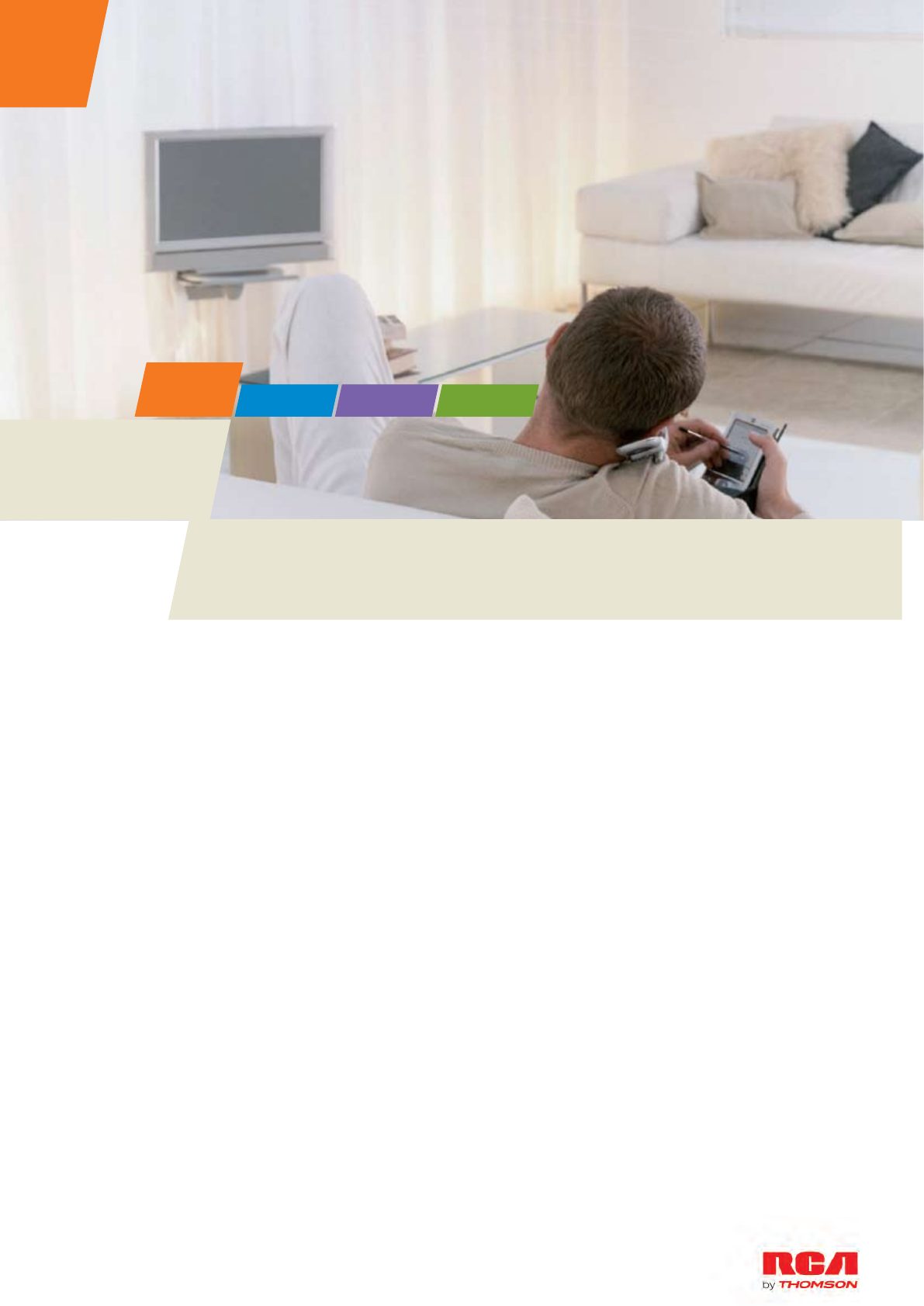
User manual
SATELLITE TELECOM
CABLE
TERRESTRIAL
DWG855 - Residential Voice Gateway
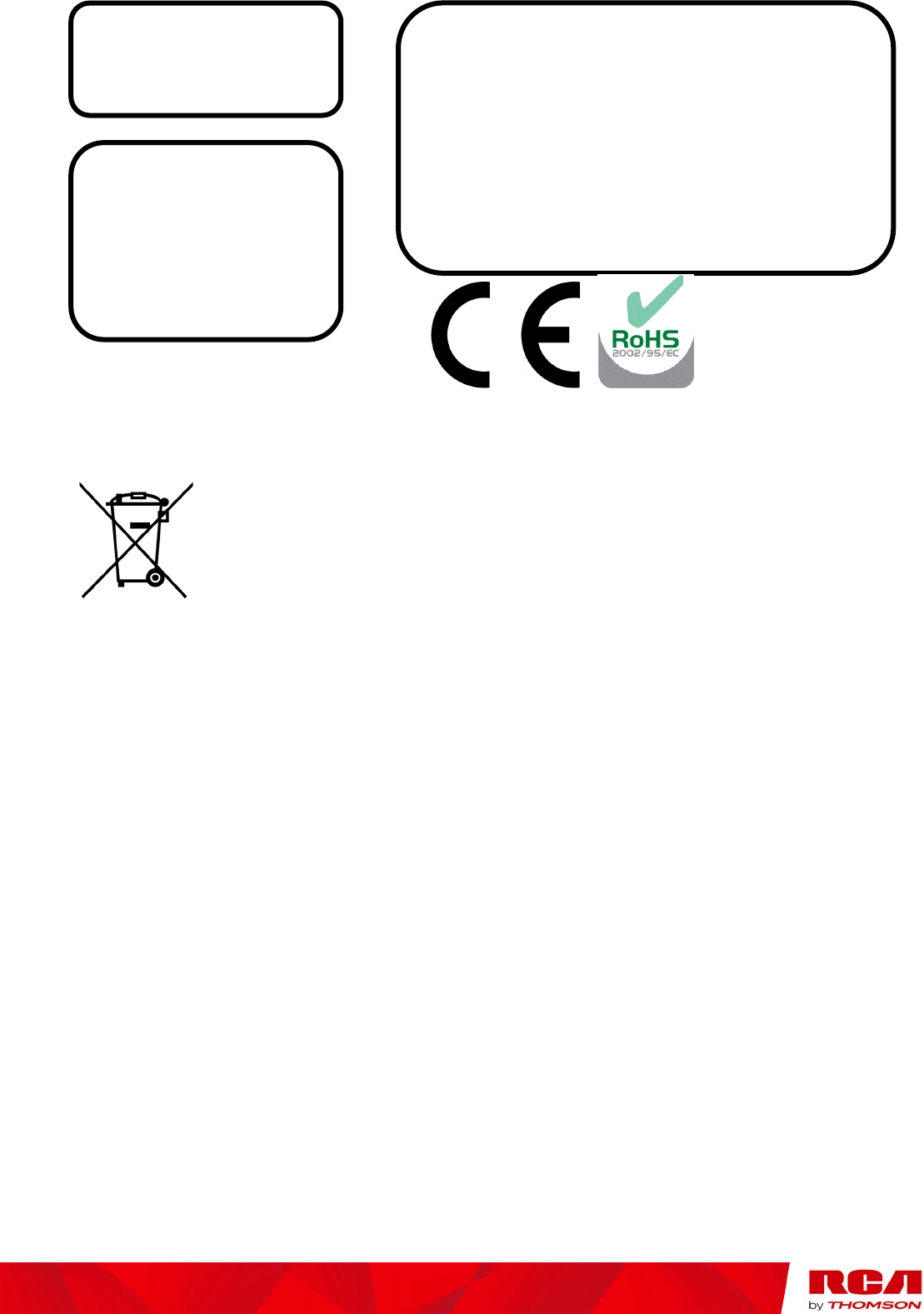
i
Illustrations contained in this document are for representation only.
CAUTION
Disconnect power before
servicing.
This device is intended for
indoor operation only.
Telephone jacks Line 1 and
Line 2 must not be connected
to outside wiring.
CAUTION
To ensure reliable operation and to prevent overheating,
provide adequate ventilation for this modem and keep it
away from heat sources. Do not locate near heat registers
or other heat-producing equipment. Provide for free air
flow around the Residential Voice Gateway and its power
supply.
NORTH AMERICAN CABLE INSTALLER:
This reminder is provided to call your attention to Article 820-40 of the National Electrical Code
(Section 54 of the Canadian Electrical Code, Part 1) which provides guidelines for proper grounding and,
in particular, specifies that the cable ground shall be connected to the grounding system of the building
as close to the point of cable entry as practical.
This symbol means that your inoperative electronic appliance must be collected separately and not mixed with the
household waste. The European Union has implemented a specific collection and recycling system for which
producers' are responsible.
This appliance has been designed and manufactured with high quality materials and components that can be
recycled and reused. Electrical and electronic appliances are liable to contain parts that are necessary in order for
the system to work properly but which can become a health and environmental hazard if they are not handled or
disposed of in the proper way. Consequently, please do not throw out your inoperative appliance with the
household waste.
If you are the owner of the appliance, you must deposit it at the appropriate local collection point or leave it with
the vendor when buying a new appliance.
- If you are a professional user, please follow your supplier's instructions.
- If the appliance is rented to you or left in your care, please contact your service provider.
Help us protect the environment in which we live !

ii
Illustrations contained in this document are for representation only.
PacketCable and DOCSIS compliant
This product was designed according to Data over Cable Service Interface Specifications and
PacketCable Voice Over IP Cable Telephony Specifications.
It will operate on any DOCSIS-compliant Hybrid Fiber Coax (HFC) cable system and offers DOCSIS
and PacketCable Baseline Privacy to promote secure internet transactions and PC-secure telephone
service.
Operating Information
Operating Temperature: 0° to 40° C (32° to 104° F)
Storage Temperature: -30° to 65° C (-22° to 149° F)
If you purchased this product at a retail outlet, please read the following:
Product Registration
Please fill out the product registration card (packed separately) and return it immediately, or register
on-line at rca.com. Registering allows us to contact you if needed.
Product Information
Keep your sales receipt to obtain warranty parts and service and for proof of purchase. Attach it here and
record the serial and model numbers in case you need them. The numbers are located on the back of the
product.
Model No. ____________________________Serial No ________________________________
Purchase Date: ________________________Dealer/Address/Phone: _________________________

Chapter 1: Connections and Setup
1
Illustrations contained in this document are for representation only.
Chapter 1: Connections and Setup .................................................................................................... 4
Introduction ................................................................................................................................ 4
Residential Voice Gateway Features ........................................................................................... 4
What’s on the CD-ROM .......................................................................................................... 4
Computer Requirements .......................................................................................................... 5
Wall Mounting ...................................................................................................................... 6
Residential Voice Gateway DWG855 Overview ................................................................................... 7
Front Panel .......................................................................................................................... 7
Rear Panel ........................................................................................................................... 9
Installing the Battery .............................................................................................................. 9
Flank Panel ........................................................................................................................ 10
Relationship among the Devices .................................................................................................... 11
What the Modem Does .......................................................................................................... 11
What the Modem Needs to Do Its Job ....................................................................................... 11
Contact Your Local Cable Company ......................................................................................... 12
Connecting the Residential Voice Gateway to a Single Computer ........................................................... 13
Attaching the Cable TV Wire to the Residential Voice Gateway ....................................................... 13
Important Connection Information ........................................................................................... 13
Ethernet Connection to One Computer ...................................................................................... 14
Connecting More Than Two Computers to the Residential Voice Gateway .......................................... 15
Telephone or Fax Connection.................................................................................................. 16
Activating the Residential Voice Gateway ........................................................................................ 17
Chapter 2: Web Configuration ....................................................................................................... 18
Accessing the Web Configuration ................................................................................................... 18
Outline of Web Manager ........................................................................................................ 19
Gateway - Status Web Page Group ................................................................................................. 20

Chapter 1: Connections and Setup
2
Illustrations contained in this document are for representation only.
1. Software ........................................................................................................................ 20
2. Connection ..................................................................................................................... 21
3. Password ........................................................................................................................ 22
4. Diagnostics ..................................................................................................................... 23
5. Event Log ....................................................................................................................... 24
6. Backup/Restore ................................................................................................................ 25
Gateway – Network Web Page Group .............................................................................................. 26
1. LAN ............................................................................................................................. 26
2. WAN ............................................................................................................................. 27
3. Computers ...................................................................................................................... 28
4. DDNS ........................................................................................................................... 29
5. Time ............................................................................................................................. 30
Gateway – Advanced Web Page Group ............................................................................................ 31
1. Options .......................................................................................................................... 31
2. IP Filtering ..................................................................................................................... 32
3. MAC Filtering ................................................................................................................. 33
4. Port Filtering ................................................................................................................... 34
5. Forwarding ..................................................................................................................... 35
6. Port Triggers ................................................................................................................... 36
7. DMZ Host ...................................................................................................................... 37
8. RIP (Routing Information Protocol) Setup............................................................................... 38
Gateway – Firewall Web Page Group .............................................................................................. 39
1. Web Content Filtering ........................................................................................................ 39
2. TOD Access Filtering ........................................................................................................ 40
3. Local Log and Remote Log ................................................................................................. 41
Gateway – Parental Control Web Page Group .................................................................................... 42

Chapter 1: Connections and Setup
3
Illustrations contained in this document are for representation only.
Basic Setup ........................................................................................................................ 42
Gateway – Wireless Web Page Group .............................................................................................. 43
1. Radio ............................................................................................................................ 44
2. Primary Network .............................................................................................................. 45
3. Guest Networks ............................................................................................................... 53
4. Access Control ................................................................................................................. 54
5. Advanced ....................................................................................................................... 55
6. Bridging ......................................................................................................................... 57
7. WMM ........................................................................................................................... 58
VoIP – Basic Web Page Group ....................................................................................................... 60
1. Basic LAN ..................................................................................................................... 60
2. Hardware Info ................................................................................................................. 61
3. Event Log ....................................................................................................................... 62
4. CM State ........................................................................................................................ 63
5. Battery .......................................................................................................................... 64
Chapter 3: Additional Information .................................................................................................. 65
Frequently Asked Questions ......................................................................................................... 65
General Troubleshooting .............................................................................................................. 67
FCC Declaration of Conformity and Industry Canada Information .......................................................... 69
Service Information .................................................................................................................... 70
Glossary .................................................................................................................................. 71

Chapter 1: Connections and Setup
4
Illustrations contained in this document are for representation only.
Chapter 1: Connections and Setup
Introduction
Residential Voice Gateway Features
Support Multiple Provisioning Mode
4 Standard RJ-45 connectors for 10/100BaseT Ethernet with auto-negotiation and MDIS functions
Two RJ-11 Foreign Exchange Station (FXS) ports for IP telephony
IEEE 802.11b/g Wireless interface
Support simultaneous voice and data communications
Two simultaneous voice conversations in the different FXS ports with different CODEC: PCM
A-law, PCM-law, G.723.1, G.729, G.729a, G.729e, G.728, G.726, BV16, BV32 and SIP
Echo Cancellation
Voice Active Detection (VAD)
DTMF detection and generation
Comfort Noise Generation (CNG)
Support V.90 fax and modem services
Transparent bridging for IP traffic
RSA and 56 bit DES data encryption security
SNMP network management support
Remote operating firmware downloading
Support Web pages and private DHCP server for status monitoring
Clear LED display
Plug and Play
What’s on the CD-ROM
Insert the Residential Voice Gateway CD-ROM into your CD-ROM drive to view troubleshooting tips,
the internal diagnostics, and other valuable information.
CD-ROM Contents:
Electronic copy of this user’s guide in additional languages (PDF format)
Adobe Acrobat Reader — application you can load to read PDF format, if you don’t have it loaded
already

Chapter 1: Connections and Setup
5
Illustrations contained in this document are for representation only.
Links to RCA or Thomson web sites
DOCSIS and PacketCable are trademarks of Cable Television Laboratories, Inc.
Computer Requirements
For the best possible performance from your Residential Voice Gateway, your personal computer must
meet the following minimum system requirements (note that the minimum requirements may vary by
cable companies):
IBM PC COMPATIBLE MACINTOSH**
CPU Pentium preferred PowerPC or higher
System RAM 16MB (32MB preferred) 24MB (32MB preferred)
Operating System Windows* NT/2000/Me/XP/Vista,
Linux
Mac OS** 7.6.1 or higher
Available Disk Space 125MB 50MB
Sound Card Required for audio on CD-ROM N/A
Video VGA or better (SVGA preferred) VGA or better (SVGA built-in preferred)
CD-ROM Drive Required Required
Ethernet 10BaseT or 100BaseT
10BaseT or 100BaseT
An Ethernet card makes it possible for your computer to pass data to and from
the internet. You must have an Ethernet card and software drivers installed in
your computer. You will also need a standard Ethernet cable to connect the
Ethernet card to your Residential Voice Gateway.
Software A TCP/IP network protocol for each machine
Microsoft Internet Explorer 4.0 or later or Netscape Navigator 4.0 or later.
(5.0 and 4.7 or later, respectively, are strongly recommended.)
* Windows is a trademark of Microsoft Corporation.
** Macintosh and the Mac OS are trademarks of Apple Computer, Inc.
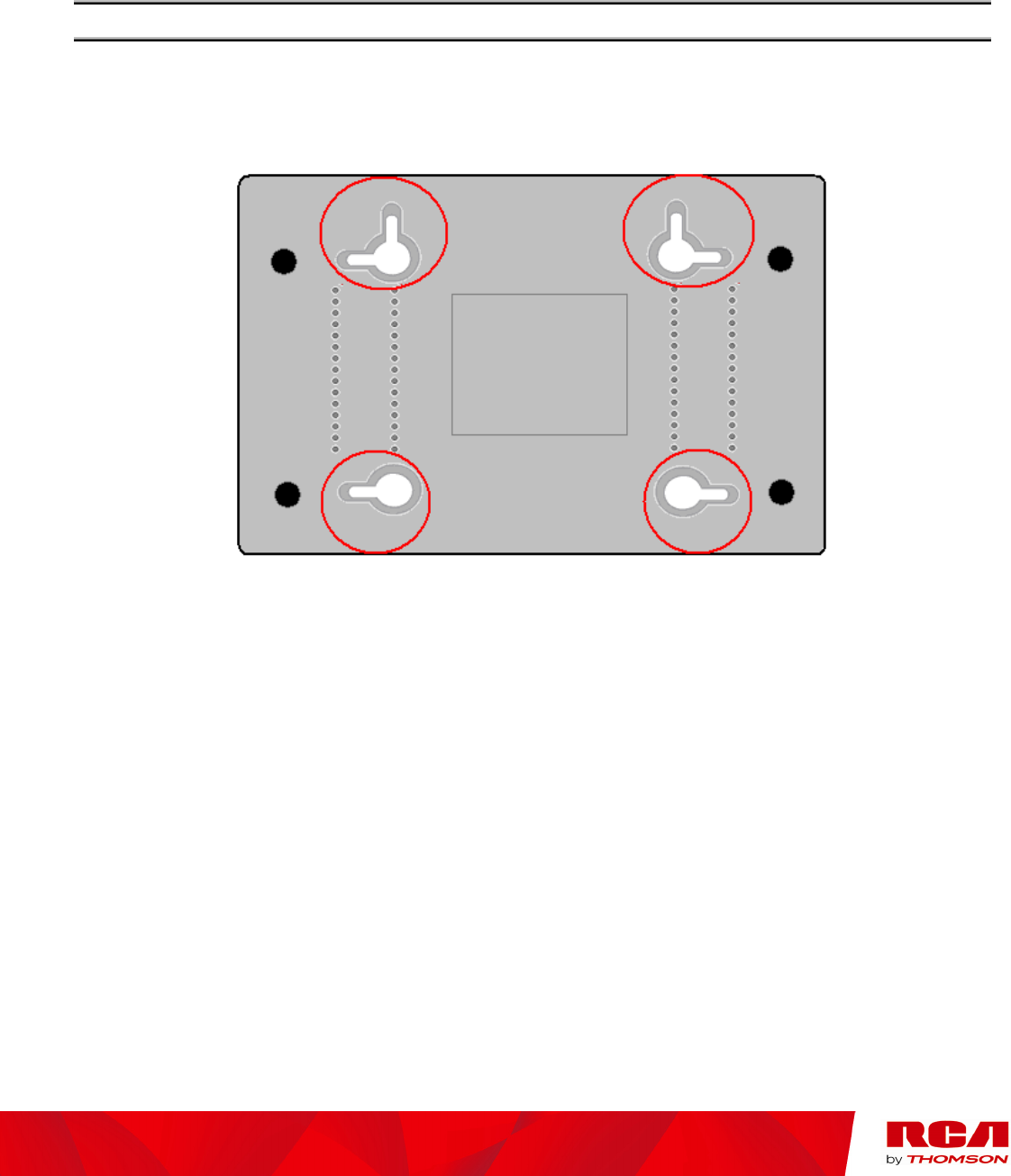
Chapter 1: Connections and Setup
6
Illustrations contained in this document are for representation only.
Wall Mounting
The number of the screw: 2 pcs
Direction for wall mounting: LED panel upward.
Dimension for the screw: 4.4 mm (0.17 inch)
There are 4 slots on the underside of the EMTA that can be used for wall mounting.
Note: When wall mounting the unit, ensure that it is within reach of the power outlet.
You will need 2 suitable screws which screw diameter would be 4.4 mm (0.17 inch) to wall mount the
Cable Modem or the Battery Pack. Two different wall mount directions could be chosen for the Battery
Pack.
To do this:
1. Ensure that the wall you use is smooth, flat, dry and sturdy and use the 4 screw
holes which are 101.6 mm (4 inches) apart from each other.
2. Fix the screws into wall, leaving their heads 3 mm (0.12 inch) clear of the wall
surface.
3. Remove any connections to the unit and locate it over the screw heads. When
in line, gently push the unit on to the wall and move it downwards to secure.
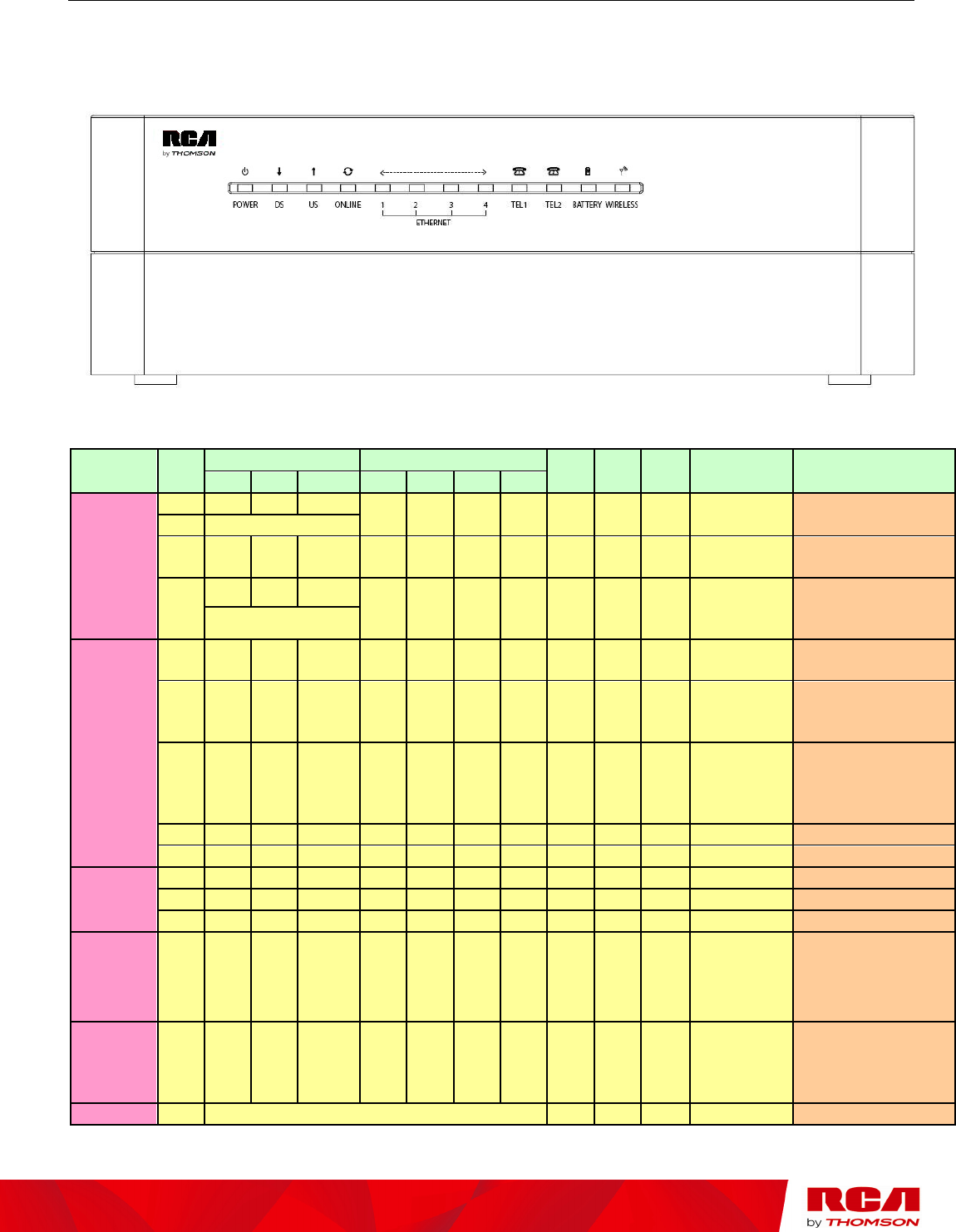
Chapter 1: Connections and Setup
7
Illustrations contained in this document are for representation only.
Residential Voice Gateway DWG855 Overview
Front Panel
The following illustration shows the front panel of the DWG855 machine:
The LEDs on the front panel are described in the table below (from left to right):
DWG855T/
DWG855CH
Power
Internet Ethernet Tel 1
Tel 2
Battery
Wireless Description
DS US Online
1 2 3 4
Boot-up
Operation
ON
ON
ON
ON ON
ON
ON
ON
ON
ON
X ON Power on 0.25 sec
ON
0.25 second
ON
FLASH
FLASH
FLASH
X X X X X X X X From power ON to system
initialization complete
ON
ON
ON
ON
X X X X X X X X
Following system
initialization complete to
(before) DS scanning
1 second
DOCSIS
Start-up
Operation
ON
FLASH
OFF
OFF X X X X X X X X During DS scanning and
acquiring SYNC
ON
ON
FLASH
OFF X X X X X X X X
From SYNC completed,
receiving UCD to ranging
completed
ON
ON
ON
FLASH
X X X X X X X X
During DHCP, configuration
file download, registration,
and Baseline Privacy
initialization
ON
ON
ON
ON X X X X X X X X Operational (NACO=ON)
ON
FLASH
FLASH
OFF X X X X X X X X Operational(NACO=OFF)
MTA
initialization
ON
ON
ON
ON X X X X FLASH
OFF
OFF
X MTA DHCP
ON
ON
ON
ON X X X X OFF
FLASH
OFF
X MTA SNMP/TFTP
ON
ON
ON
ON X X X X FLASH
FLASH
OFF
X RSIP
CPE
Operation ON
X X X
OFF
ON
FLASH
ON
OFF
ON
FLASH
ON
OFF
ON
FLASH
ON
OFF
ON
FLASH
ON
X X X X
No Ethernet Link
Ethernet Link
TX/RX Ethernet Traffic
Ethernet Collision
CPE
Operation ON
X X X X X X X X X X
OFF
ON
FLASH
ON
No Wireless Link
Wireless Link
TX/RX Wireless Traffic
Wireless init fail
AC Good ON
<CM Normal Operation> ON
ON
ON <CM Normal Both Lines On-Hook
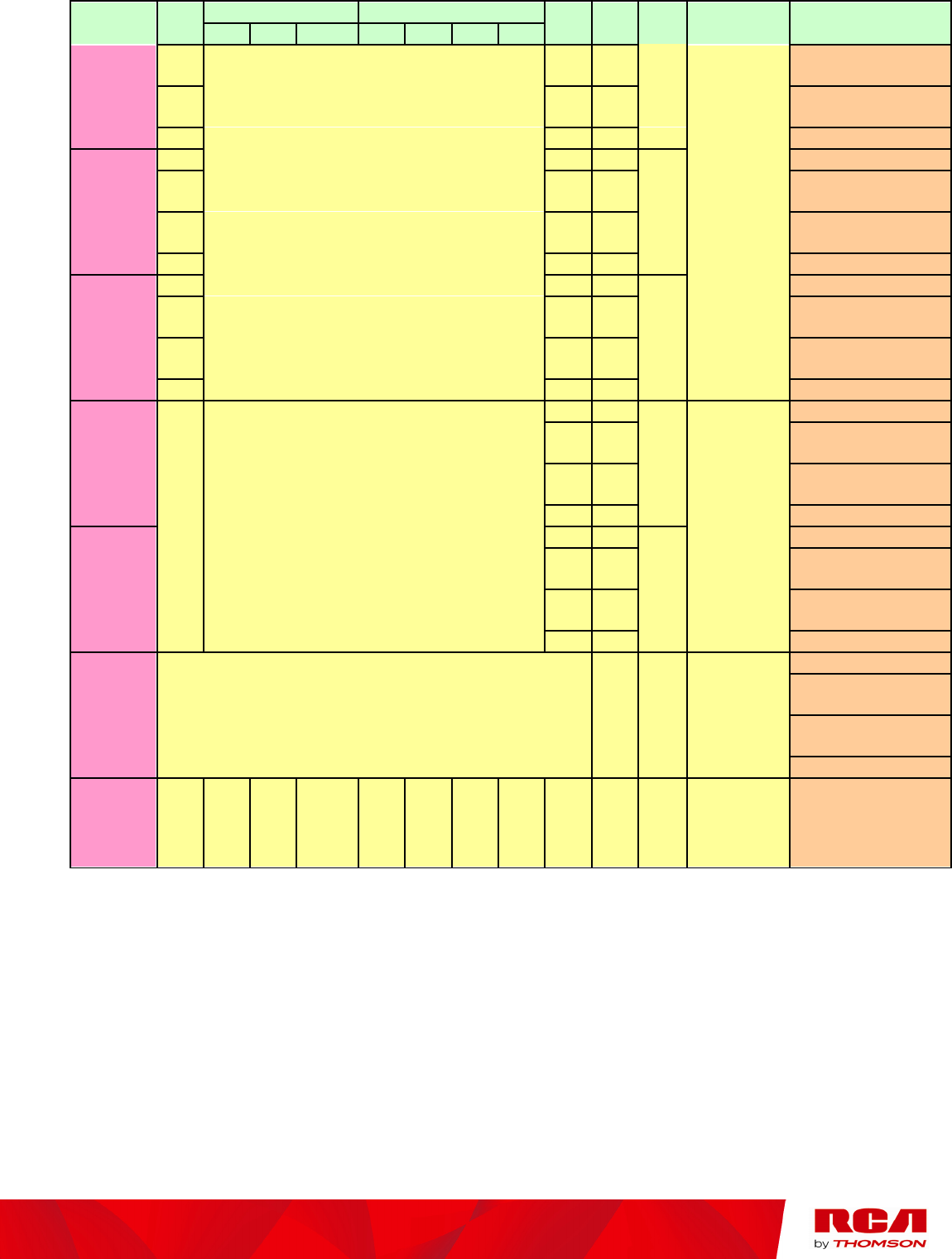
Chapter 1: Connections and Setup
8
Illustrations contained in this document are for representation only.
DWG855T/
DWG855CH
Power
Internet Ethernet Tel 1
Tel 2
Battery
Wireless Description
DS US Online
1 2 3 4
Battery Good
ON
FLASH
ON
Operation> Tel1 Off-hook, Tel2
On-hook
ON
ON
FLASH
Tel1 On-hook, Tel2
Off-hook
ON
FLASH
FLASH
Both Lines Off-Hook
AC Good
Battery Low
ON
ON
ON
FLASH
Both Lines On-Hook
ON
FLASH
ON
Tel1 Off-hook, Tel2
On-hook
ON
ON
FLASH
Tel1 On-hook, Tel2
Off-hook
ON
FLASH
FLASH
Both Lines Off-Hook
AC Good
Battery Bad
ON
ON
ON
OFF
Both Lines On-Hook
ON
FLASH
ON
Tel1 Off-hook, Tel2
On-hook
ON
ON
FLASH
Tel1 On-hook, Tel2
Off-hook
ON
FLASH
FLASH
Both Lines Off-Hook
AC Fail
Battery Good
FLASH
OFF
ON
ON
OFF
OFF
Both Lines On-Hook
FLASH
ON
Tel1 Off-hook, Tel2
On-hook
ON
FLASH
Tel1 On-hook, Tel2
Off-hook
FLASH
FLASH
Both Lines Off-Hook
AC Fail
Battery Low
ON
ON
FLASH
Both Lines On-Hook
FLASH
ON
Tel1 Off-hook, Tel2
On-hook
ON
FLASH
Tel1 On-hook, Tel2
Off-hook
FLASH
FLASH
Both Lines Off-Hook
AC Fail
Battery Bad
< All LEDs may be unlit due to lack of battery power> OFF
< All LEDs may
be unlit due to
lack of battery
power>
Both Lines On-Hook
Tel1 Off-hook, Tel2
On-hook
Tel1 On-hook, Tel2
Off-hook
Both Lines Off-Hook
SW Download
Operation ON
FLASH
FLASH
ON X X X X X X X X
A software download and
while updating the
FLASH
memory
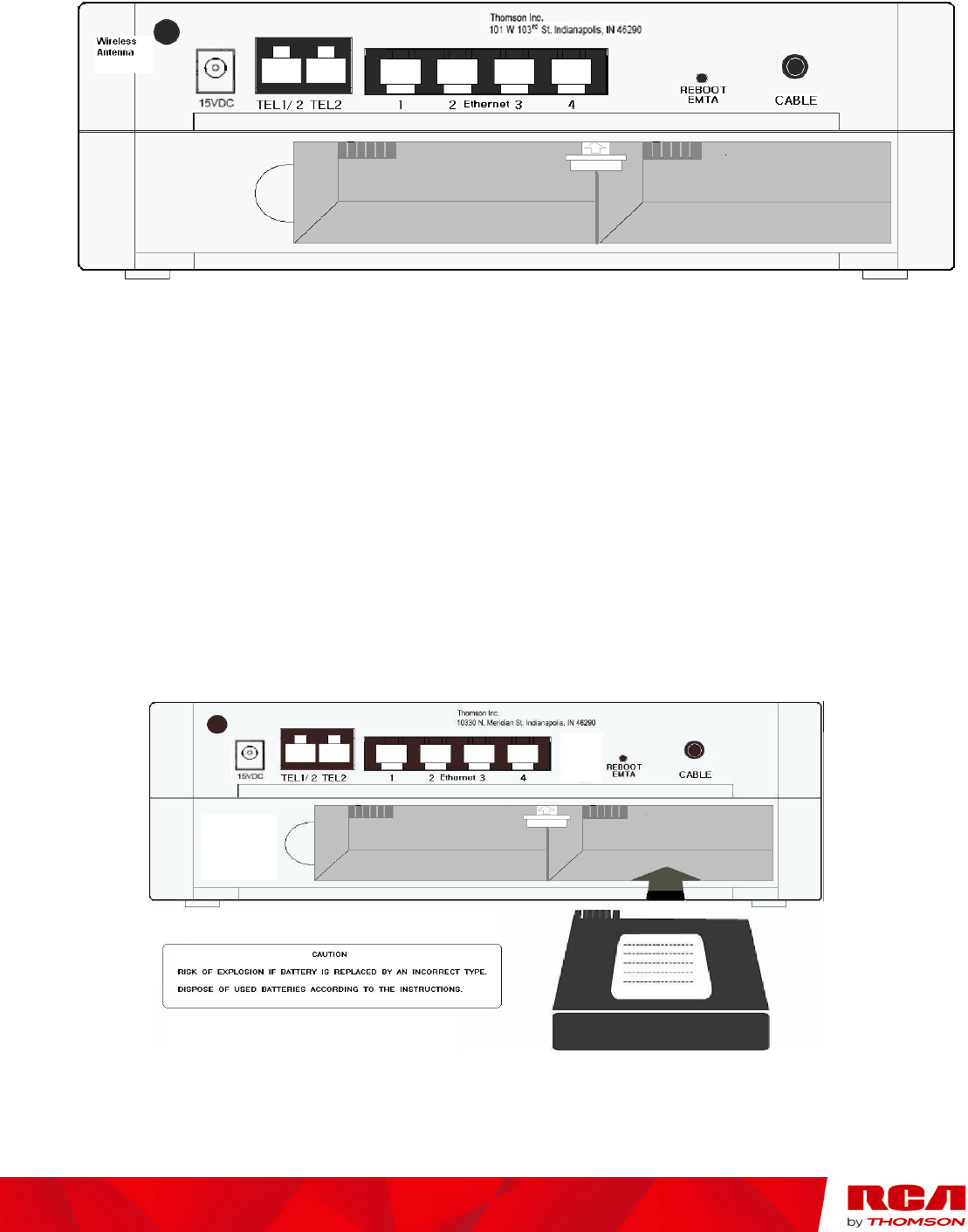
Chapter 1: Connections and Setup
9
Illustrations contained in this document are for representation only.
Rear Panel
TEL1 & TEL2 Telephony RJ-11 connector
ETHERNET 1-4: Ethernet 10/100BaseT RJ-45 connector
REBOOT EMTA: Reboot this Residential Voice Gateway
CABLE: F-Connector
15VDC: Power connector
Installing the Battery
This section provides information on installing batteries into the modem. Follow the steps below:
1. Ensure the power cord is unplugged.
2. Remove the battery cover on the rear panel. There are two battery compartments. You may install
a single battery into either compartment.

Chapter 1: Connections and Setup
10
Illustrations contained in this document are for representation only.
Flank Panel
WPS: WiFi Protected Setup
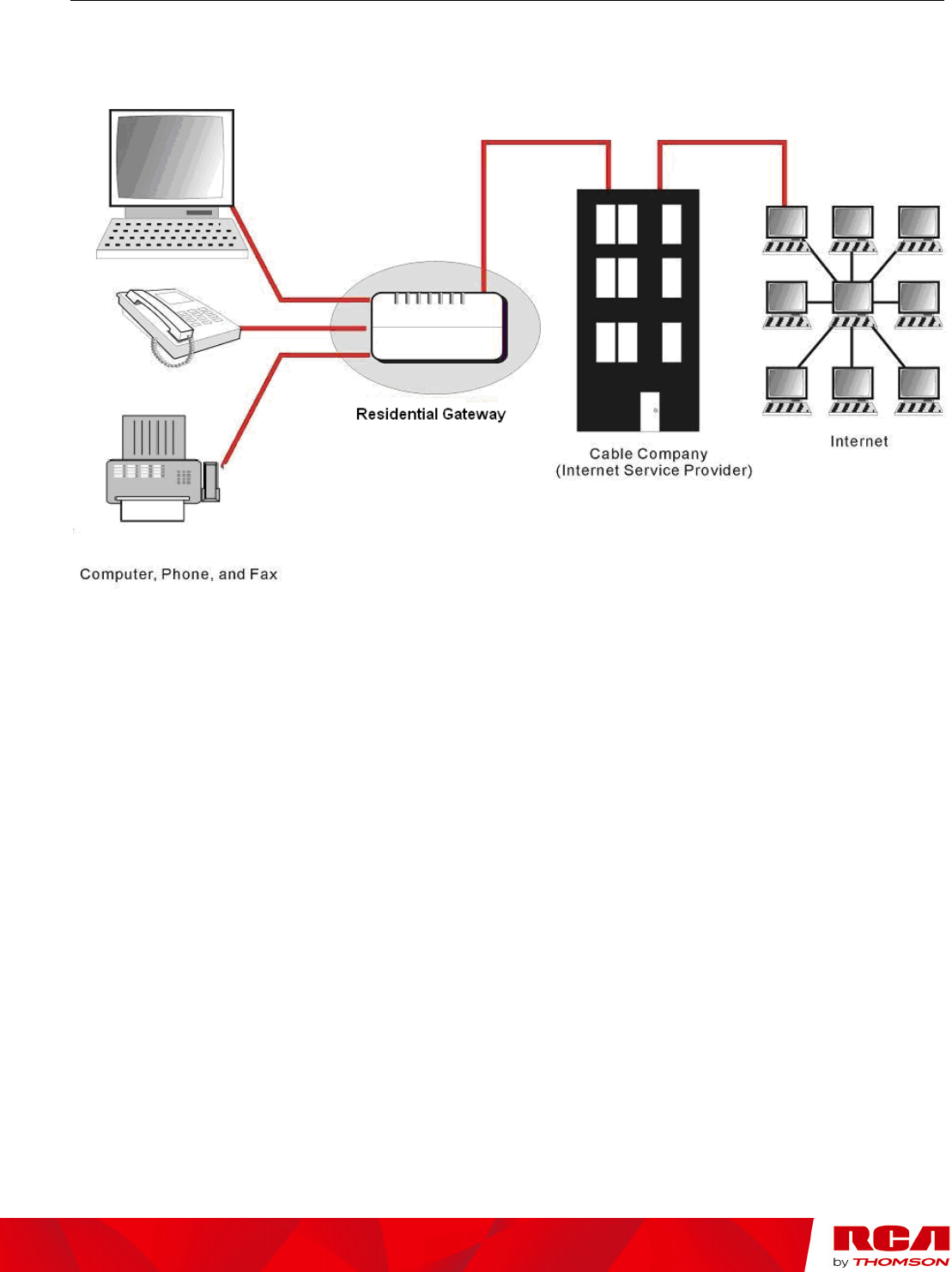
Chapter 1: Connections and Setup
11
Illustrations contained in this document are for representation only.
Relationship among the Devices
This illustration shows a cable company that offers DOCSIS- and PacketCable-compliant voice/data
services.
What the Modem Does
The Residential Voice Gateway provides wired and wireless high-speed Internet access as well as
cost-effective, toll-quality telephone voice and fax/modem services over residential, commercial, and
education subscribers on public and private networks via an existing CATV infrastructure. It can
inter-operate with the PacketCable compliant head end equipment and provide the IP-based voice
communications. The IP traffic can transfer between the Residential Voice Gateway and DOCSIS
compliant headend equipment. The data security secures upstream and downstream communications.
What the Modem Needs to Do Its Job
The Right Cable Company:
Make sure your local cable company provides data services that use
cable TV industry-standard DOCSIS-compliant and PacketCable-compliant technology.
The Internet/Telephony Service Provider (ISP/TSP):
Your cable company provides you access to an
Internet Service Provider (ISP) and Telephony Service Provider (TSP). The ISP is your gateway to
the Internet and provides you with a pipeline to access Internet content on the World Wide Web
(WWW). The TSP provides you with telephony access to other modems or other telephony services
over the Public Switched Telephone Network (PSTN).
Check with your cable company to make sure you have everything you need to begin; they’ll know if

Chapter 1: Connections and Setup
12
Illustrations contained in this document are for representation only.
you need to install special software or re-configure your computer to make your cable internet service
work for you.
Contact Your Local Cable Company
You will need to contact your cable company to establish an Internet account before you can use your
gateway. You should have the following information ready (which you will find on the sticker on the
gateway):
The serial number
The model number
The Cable Modem (CM) Media Access Control (MAC) address
The Terminal Adapter (EMTA) MAC address
Please verify the following with the cable company
The cable service to your home supports DOCSIS compliant two-way modem access.
Your internet account has been set up. (The Media Terminal Adapter will provide data service if the
cable account is set up but no telephony service is available.)
You have a cable outlet near your PC and it is ready for Cable Modem service.
Note: It is important to supply power to the modem at all times. Keeping your modem plugged in will
keep it connected to the Internet. This means that it will always be ready whenever you need.
Important Information
Your cable company should always be consulted before installing a new cable outlet. Do not attempt any
rewiring without contacting your cable company first.
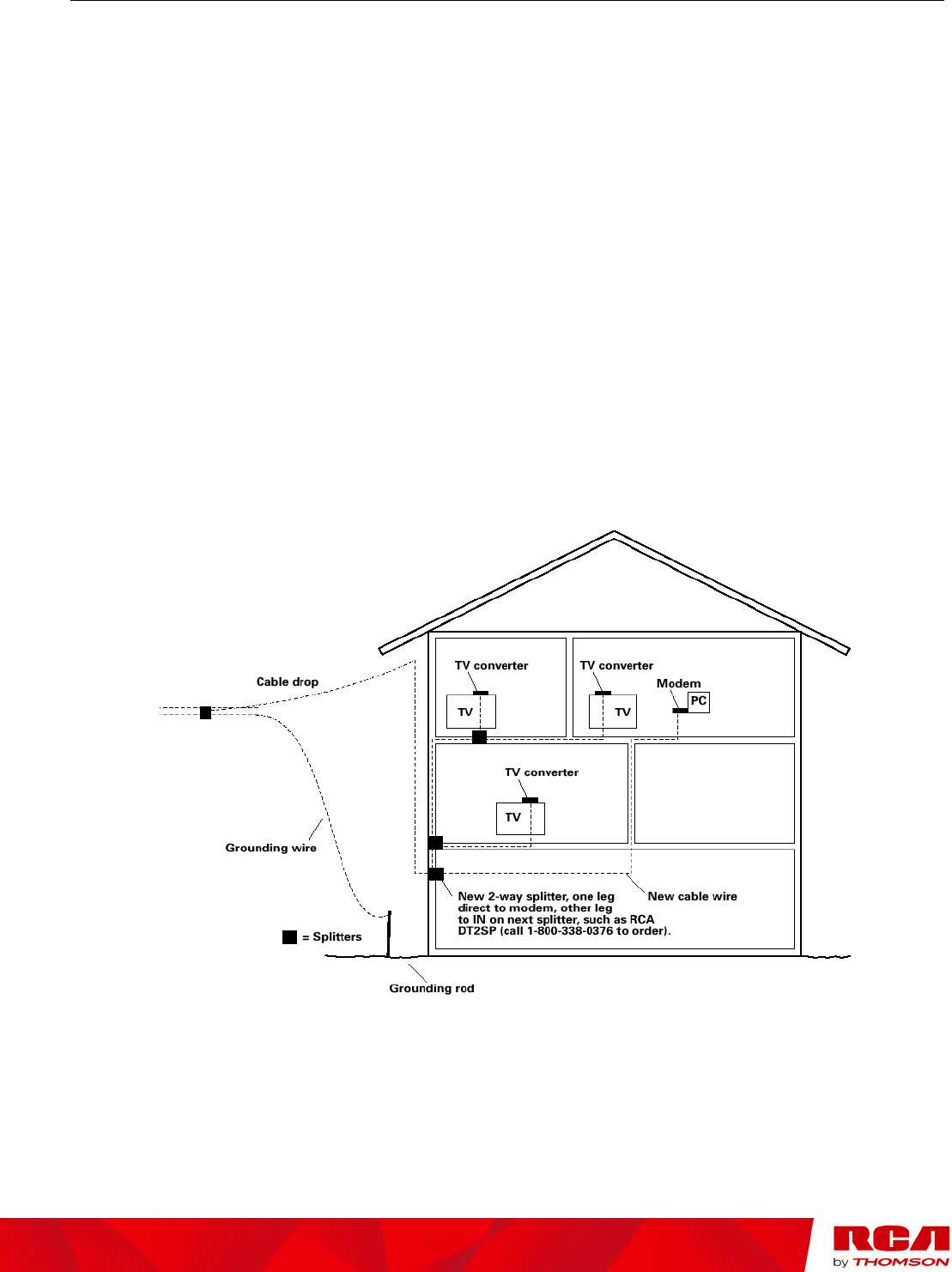
Chapter 1: Connections and Setup
13
Illustrations contained in this document are for representation only.
Connecting the Residential Voice Gateway to a Single Computer
This section of the manual explains how to connect your Residential Voice Gateway to the Ethernet port
on your computer and install the necessary software. Please refer to Figure 1 to help you connect your
Digital Cable Modem for the best possible connection.
Attaching the Cable TV Wire to the Residential Voice Gateway
1.
L
ocate the Cable TV wire. You may find it one of three ways:
a. Connected directly to a TV, a Cable TV converter box, or VCR. The line will be connected to
the jack which should be labeled either IN, CABLE IN, CATV, CATV IN, etc.
b. Connected to a wall-mounted cable outlet.
c. Coming out from under a baseboard heater or other location. See Figure 1 for the wiring
example.
Notes: For optimum performance, be sure to connect your
Residential Voice Gateway to the first point the cable enters
your home. The splitter must be rated for at least 1GHz.
Fig. 1: Basic Home Wiring
Important Connection Information
The Residential Voice Gateway supports Telephone and Ethernet connections simultaneously.
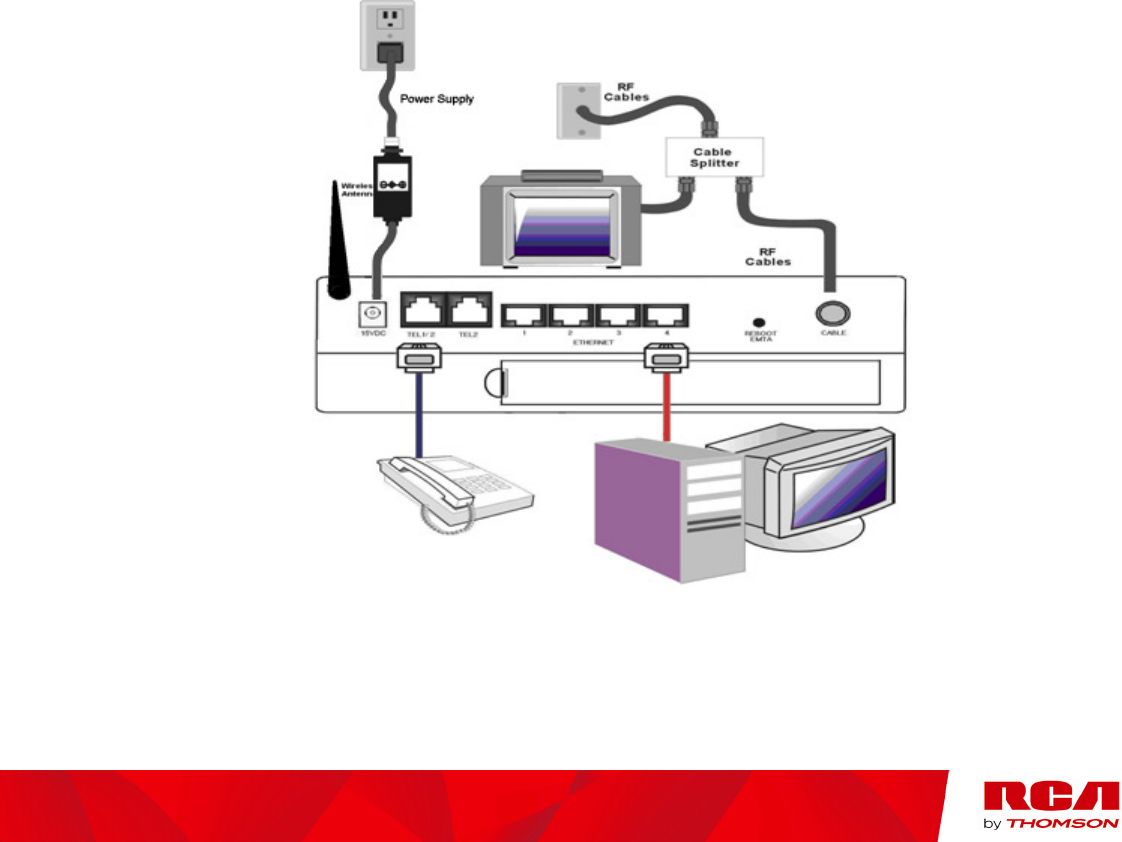
Chapter 1: Connections and Setup
14
Illustrations contained in this document are for representation only.
Below are important points to remember before you connect the Residential Voice Gateway.
For Ethernet connections, go to page 14.
For telephone and fax connections, go to page 16.
Ethernet Connection to One Computer
Make the connections to the modem in the following sequence:
1. Connect one end of the coaxial cable to the cable connection on the wall, and the other end to the
CABLE jack on the Residential Voice Gateway.
2. Connect the plug from the AC power supply into the DC jack on the Residential Voice Gateway, and
plug the power supply into an AC outlet.
3. Note: Use only the power supply that accompanied this unit. Using other adapters may damage the
unit. Connect one end of the Ethernet cable (straight-wired, see below) to the Ethernet port on the
back of your computer, and the other end to the ETHERNET port on the Residential Voice Gateway.
Make sure that the Ethernet cable is straight-wired (not “null” or crossover-wired). However, you
will need a crossover-type cable if you are connecting the modem to a hub, or a hub within a port
switch that provides the same function.
Fig.2 Ethernet Connection
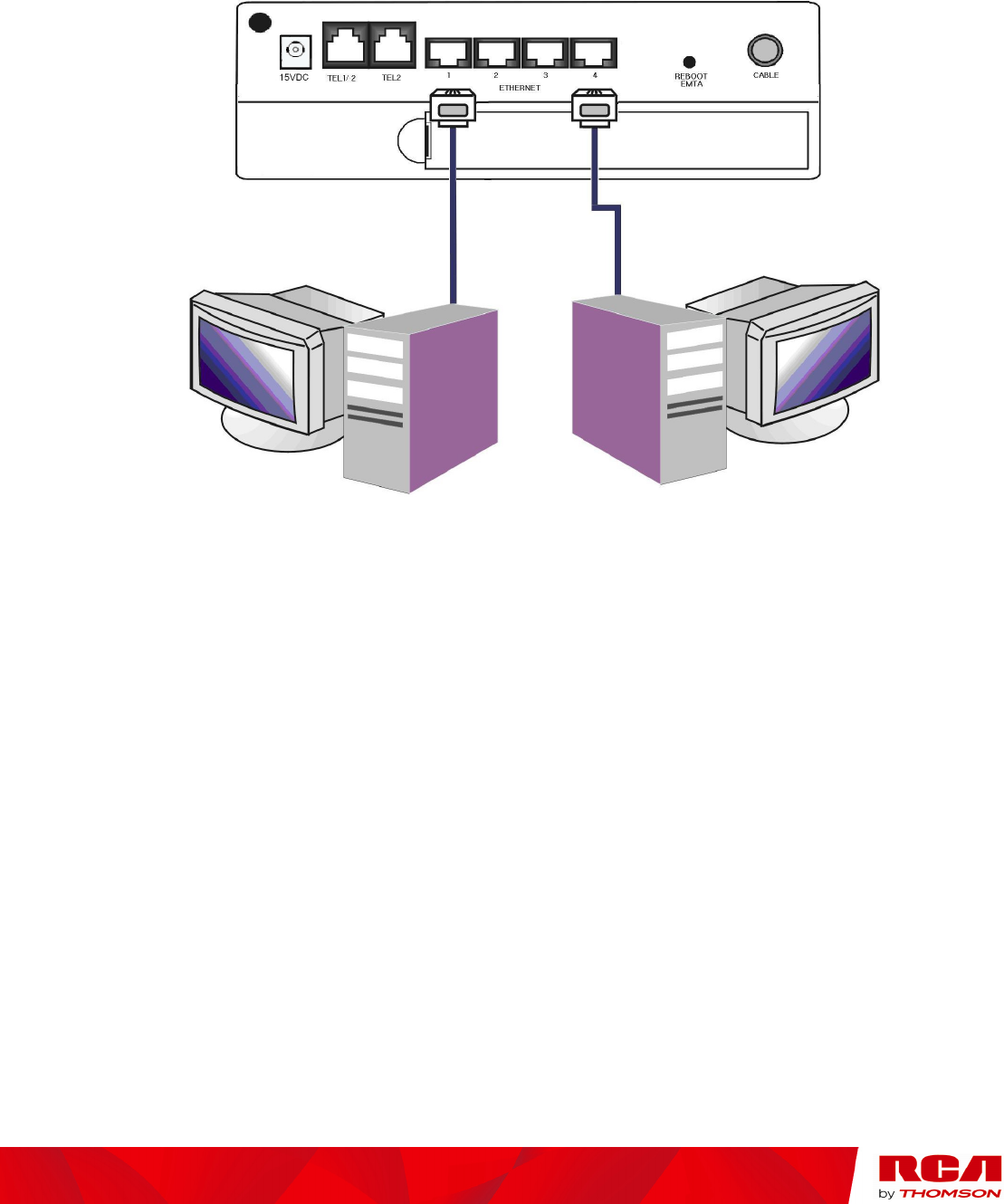
Chapter 1: Connections and Setup
15
Illustrations contained in this document are for representation only.
Connecting More Than Two Computers to the Residential Voice Gateway
If you need to connect more than two computers to DWG855, simply connect the computers to the
Ethernet ports on the rear panel.
Fig.3: Multiple-PC Connection
Note: You may need to check with your service provider in order to connect multiple computers.
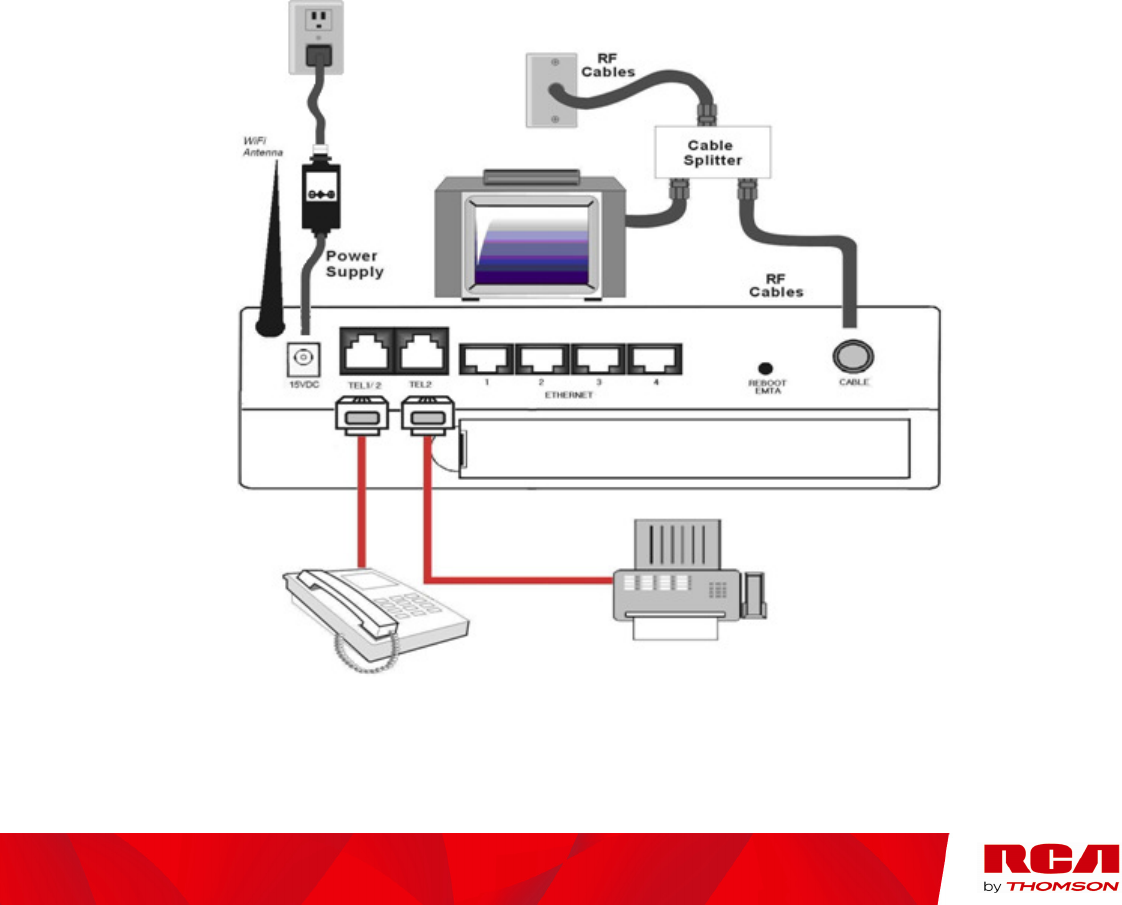
Chapter 1: Connections and Setup
16
Illustrations contained in this document are for representation only.
Telephone or Fax Connection
When properly connected, most telephony devices can be used with the Residential Voice Gateway just
as with conventional telephone service. To make a normal telephone call, pick up the handset; listen for a
dial tone, then dial the desired number. For services such as call waiting, use the hook switch (or FLASH
button) to change calls. The following procedures describe some of the possible connection schemes for
using telephony devices with the Residential Voice Gateway.
1. Connect a standard phone line cord directly from the phone (fax machine, answering machine, caller
ID box, etc.) to one of the LINE jacks on the Residential Voice Gateway.
2. If there is a phone line in your home which is NOT connected to another telephone service provider,
connect a standard phone line cord from a jack on this line to one of the LINE jacks of the
Residential Voice Gateway. Connect a standard phone line cord directly from the phone (fax machine,
answering machine, caller ID box, etc.) to one of the other jacks in the house that uses that line.
3.
If you have a multi-line telephone, connect a standard phone line cord (not an RJ-14 type line cord)
from the phone to the LINE jacks on the Residential Voice Gateway. (Other phones can be added to
each line by using standard phone line splitters.
Fig. 4- Phone/Fax Connection

Chapter 1: Connections and Setup
17
Illustrations contained in this document are for representation only.
Activating the Residential Voice Gateway
After installing the Residential Voice Gateway and turn it on for the first time (and each time the modem
is reconnected to the power), it goes through several steps before it can be used. Each of these steps is
represented by a different pattern of flashing lights on the front of the modem.
Note: All indicators flash once before the initialization sequence.
If all of the lights are flashing sequentially, it means the Residential Voice Gateway is automatically
updating its system software. Please wait for the lights to stop flashing. You cannot use your modem
during this time. Do not remove the power supply or reset the Residential Voice Gateway during this
process.
For a better wireless reception/connectivity, please make sure the supplied Wireless antenna is connected
to the back of the unit.
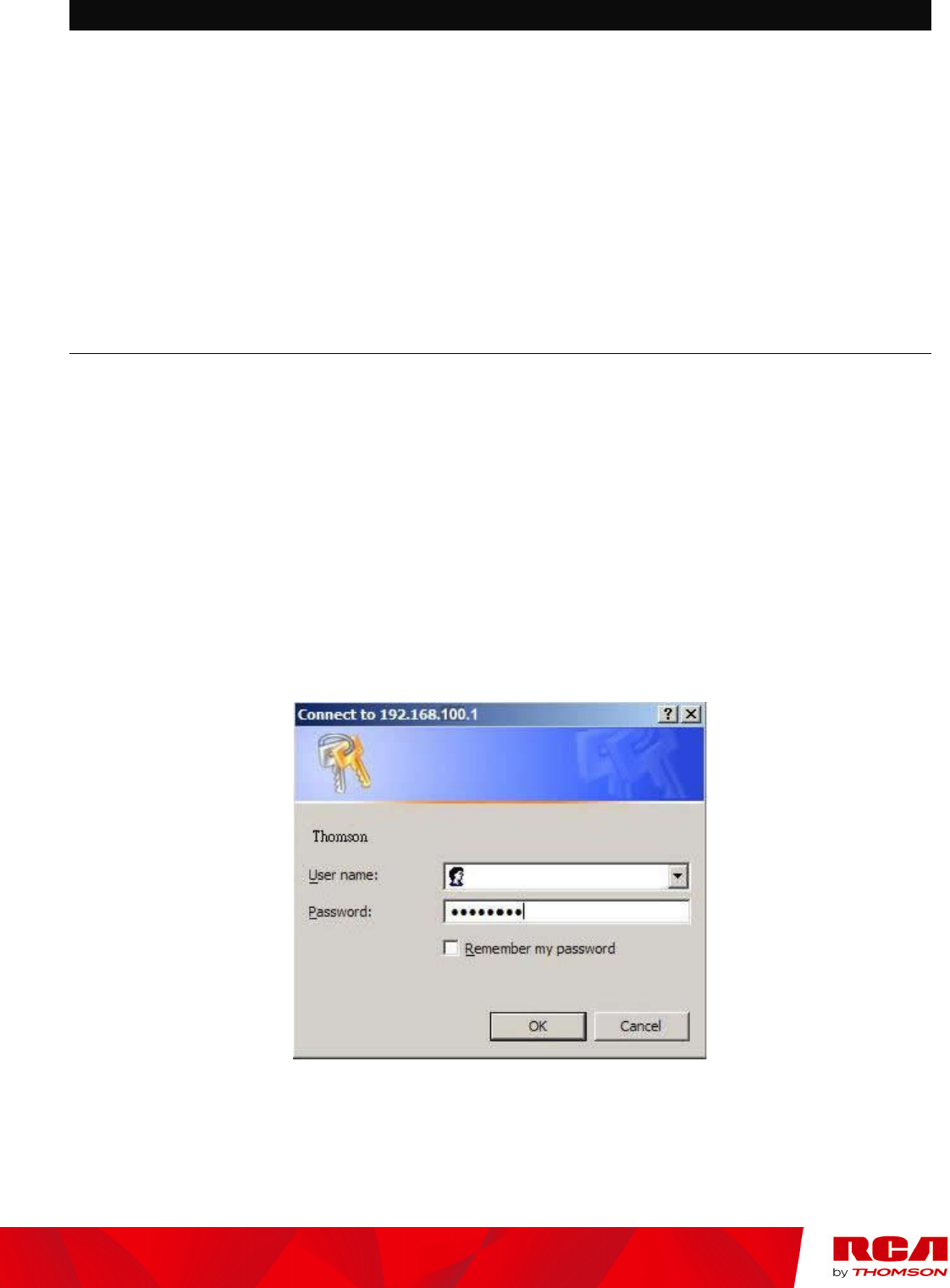
Chapter 2: Web Configuration
18
Illustrations contained in this document are for representation only.
Chapter 2: Web Configuration
To make sure that you can access the Internet successfully, please check the following first.
1. Make sure the connection (through Ethernet) between the Residential Voice Gateway
and your computer is OK.
2. Make sure the TCP/IP protocol is set properly.
3. Subscribe to a Cable Company.
Accessing the Web Configuration
The Residential Voice Gateway offers local management capability through a built in HTTP server and
a number of diagnostic and configuration web pages. You can configure the settings on the webpage and
apply them to the device.
Once your host PC is properly configured; please proceed as follows:
1. Start your web browser and type the private IP address of the Residential Voice
Gateway on the URL field: 192.168.0.1
2. After connecting to the device, you will be prompted to enter username and password.
By default, the username is “ ” and the password is “admin”.
Fig. 5 Dialogue for Login
If you login successfully, the main page will appear.
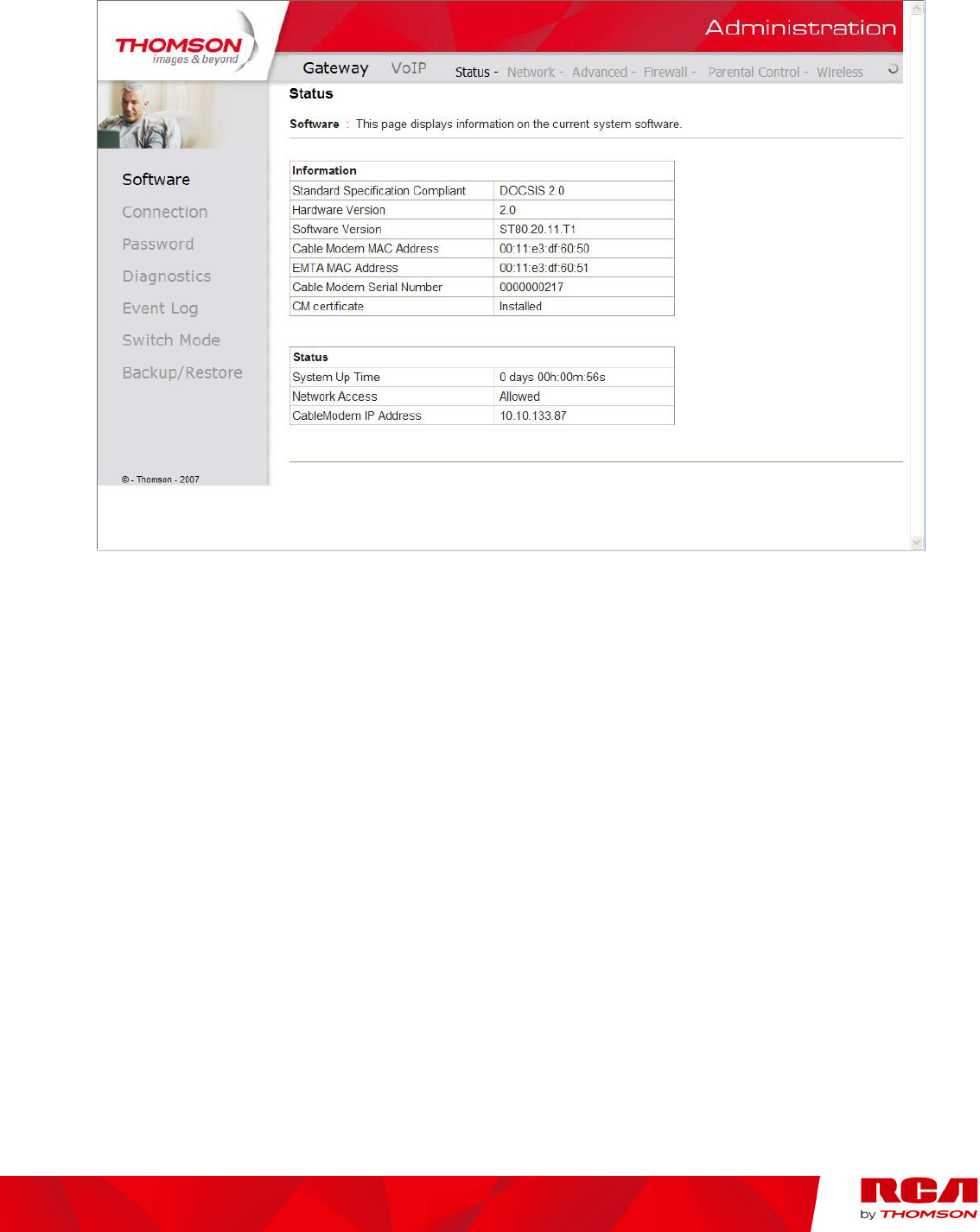
Chapter 2: Web Configuration
19
Illustrations contained in this document are for representation only.
Outline of Web Manager
The main screen will be shown as below.
Fig. 6 Outline of Web Manager
Main Menu: the hyperlinks on the top of the page, including Gateway, VoIP and several sub-menu
items
Title: the sidebar on the left side of the page, indicates the title of this management interface, e.g.,
Software in this example
Main Window: the current workspace of the web management, containing configuration or status
information
For easy navigation, the pages are organized in groups, with group names main menu, individual page
names within each group are provided in the sidebar. To navigate to a page, click the group hyperlink at
the top, then the page title on the sidebar.
Please note, your cable company may not support the reporting of some items of information listed on
your gateway’s internal web pages. In such cases, the information field appears blank or a little different
than what is showing in the figures. This is normal.
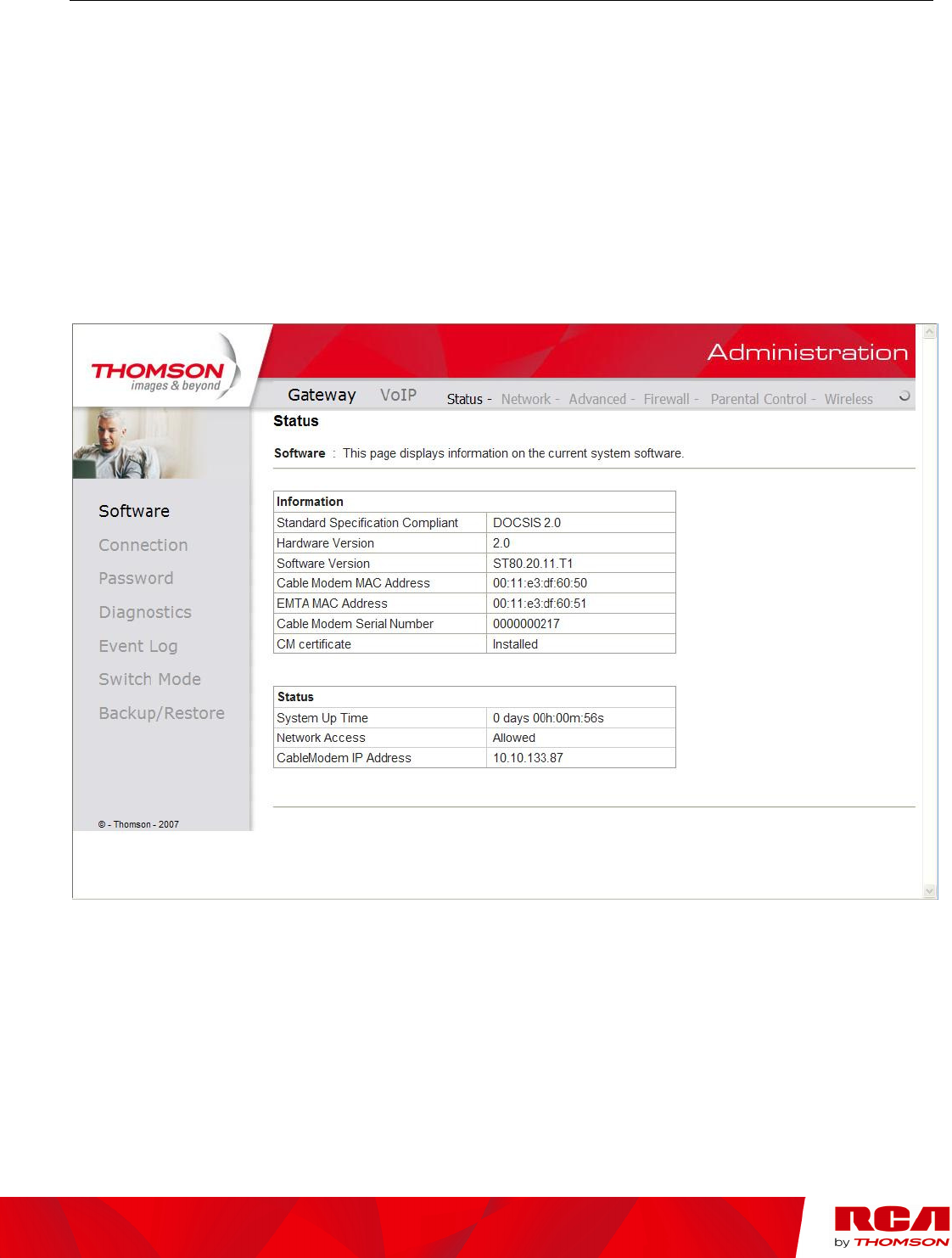
Chapter 2: Web Configuration
20
Illustrations contained in this document are for representation only.
Gateway - Status Web Page Group
1. Software
The information section shows the hardware and software information about your gateway.
The status section of this page shows how long your gateway has operated since last time being powered
up, and some key information the Cable Modem received during the initialization process with your
cable company. If Network Access shows “Allowed,” then your cable company has configured your
gateway to have Internet connectivity. If not, you may not have Internet access, and should contact your
cable company to resolve this.
Fig. 7 Gateway\Status\Software
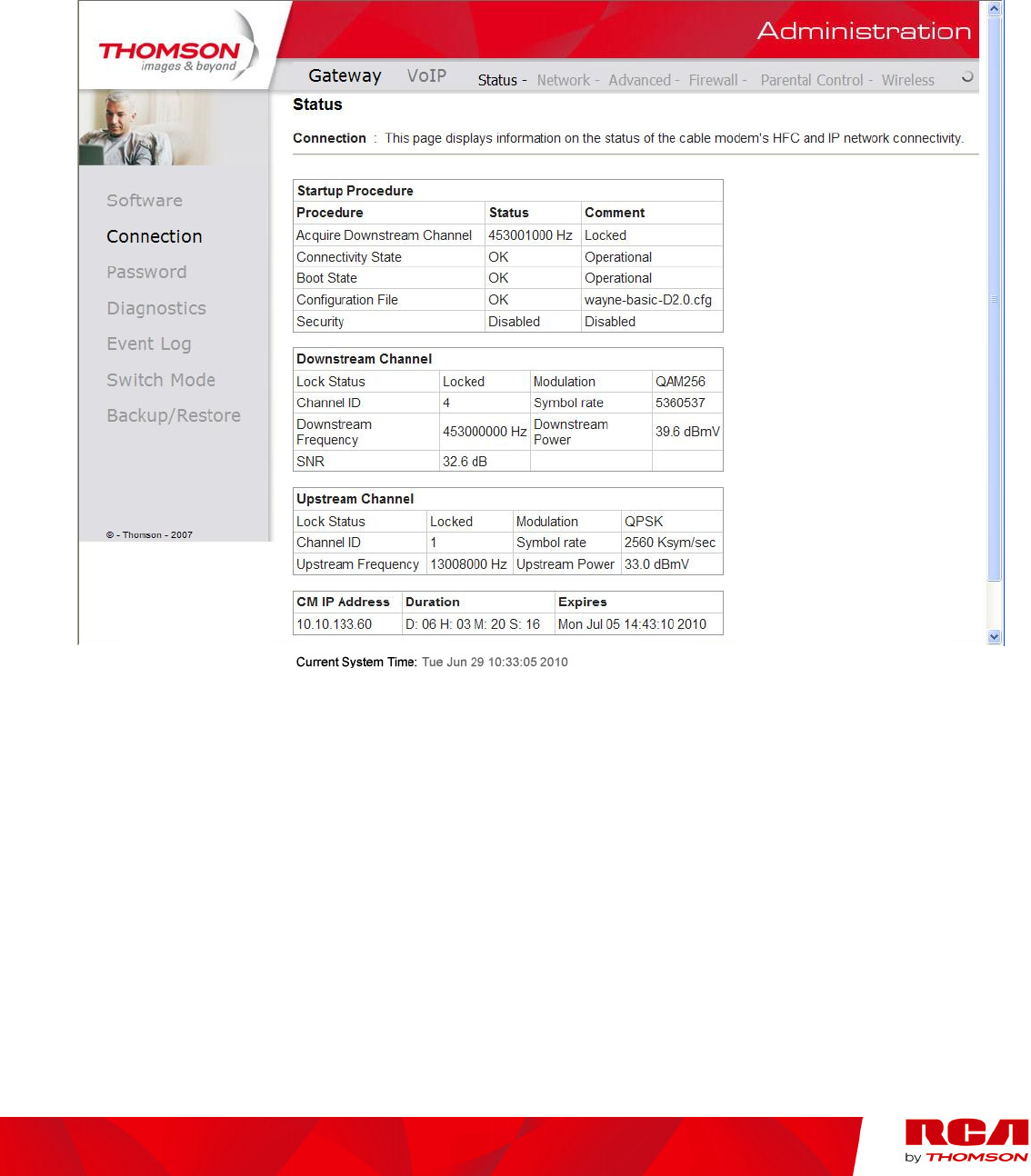
Chapter 2: Web Configuration
21
Illustrations contained in this document are for representation only.
2. Connection
This page reports current connection status containing startup procedures, downstream and upstream
status, CM online information, and so on. The information can be useful to your cable company’s
support technician if you’re having problems.
Fig. 8 Gateway\Status\Connection
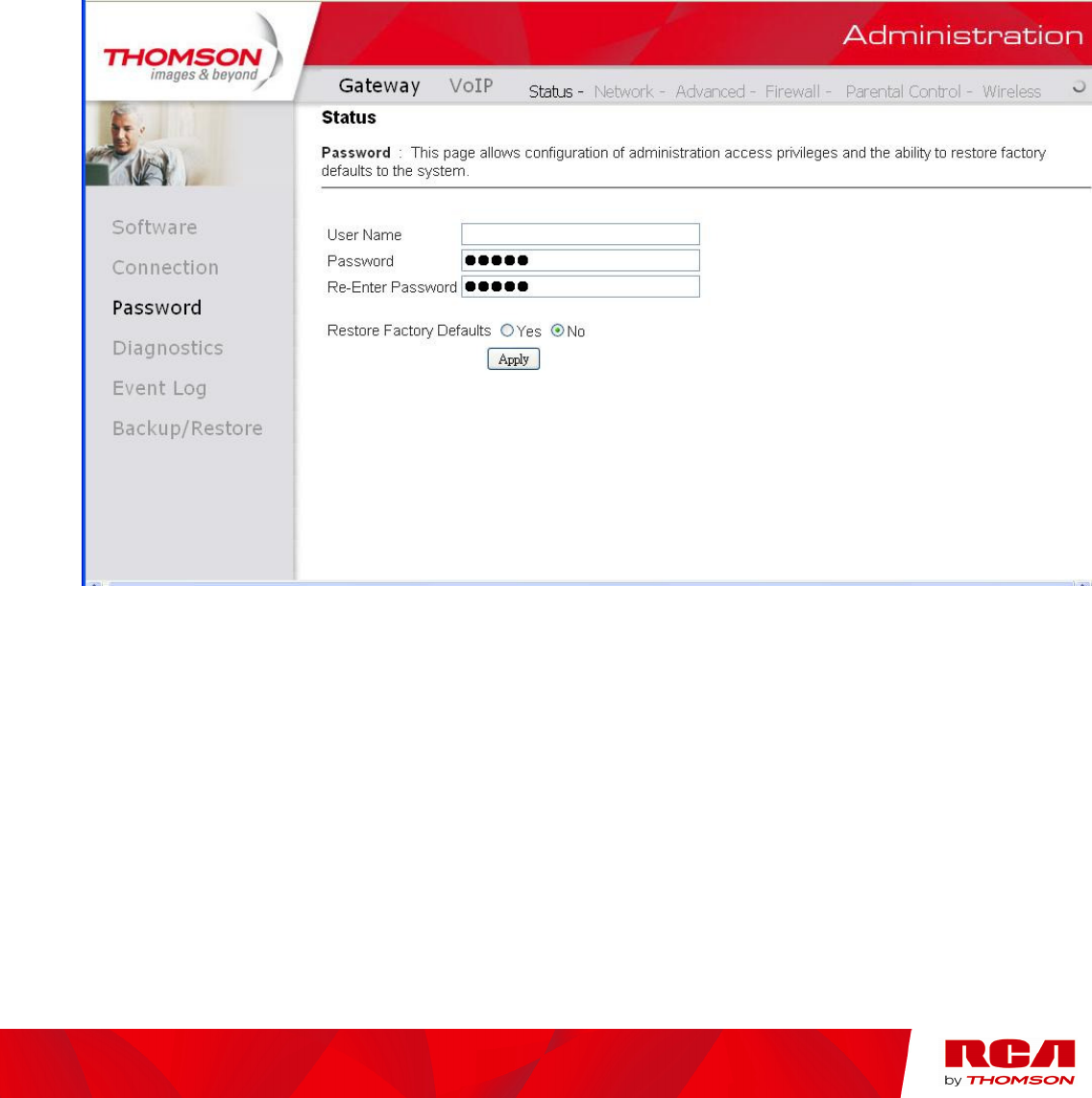
Chapter 2: Web Configuration
22
Illustrations contained in this document are for representation only.
3. Password
This page is used to change the password that enables you to access the gateway web pages next time.
The default User ID is “ ”(EMPTY), and the password is “admin”. The password can be a maximum of
8 characters and is case sensitive. In addition, this page can be used to restore the gateway to its original
factory settings. Use this with caution, as all the settings you have made will be lost. To perform this
reset, set Restore Factory Defaults to Yes and click Apply. This has the same effect as a factory reset
using the rear panel reset switch, where you hold in the switch for 15 seconds, then release.
Fig. 9 Gateway\Status\Password
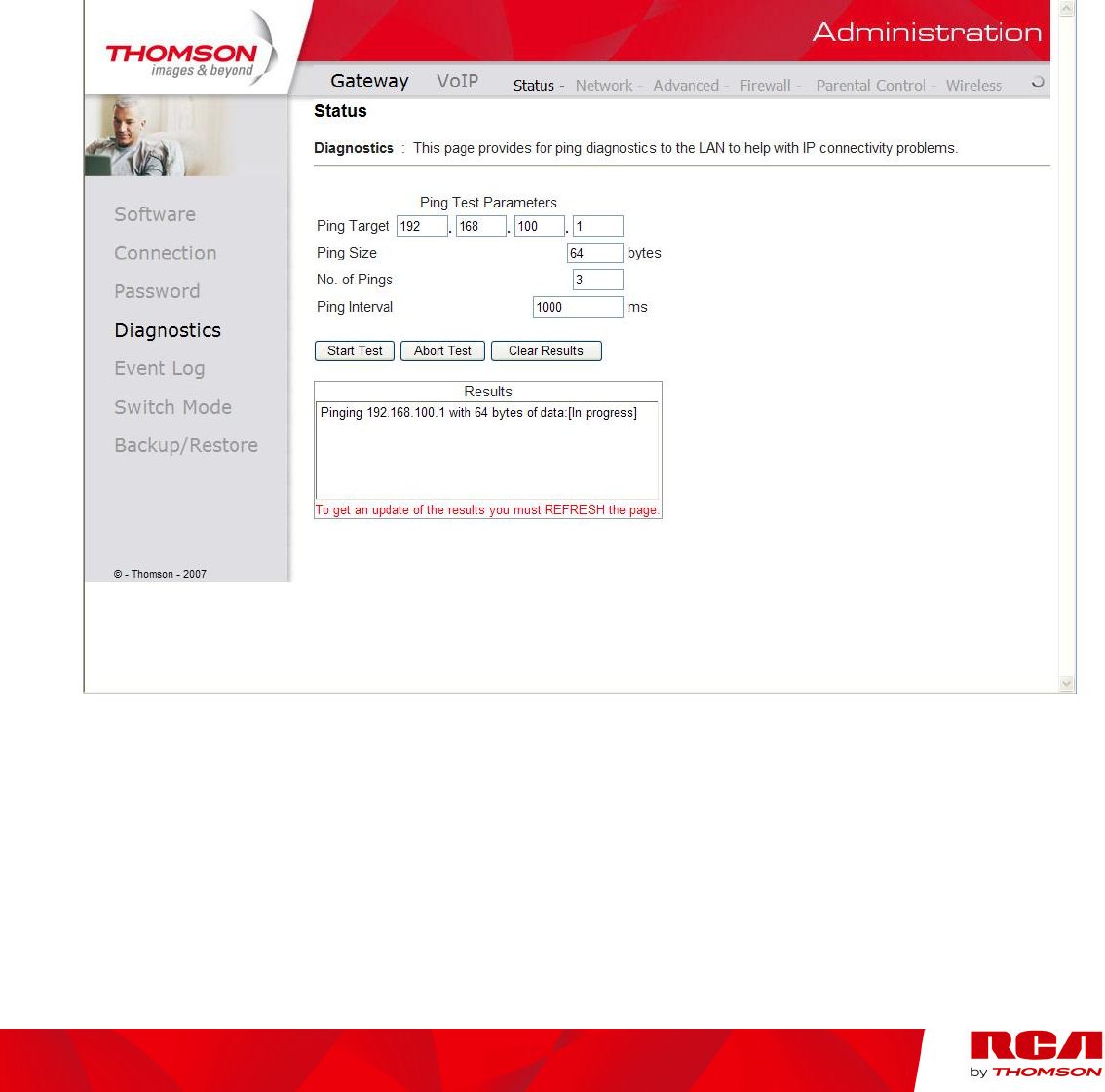
Chapter 2: Web Configuration
23
Illustrations contained in this document are for representation only.
4. Diagnostics
This page offers basic diagnostic tools for you to utilize when connectivity problems occur. When you
ping an Internet device, you send a packet to its TCP/IP stack, and it sends one back to yours. To use the
ping Test, enter the information needed and press Start Test; the Result will be displayed in the lower
part of the window. Press Abort Test to stop, and Clear Results to clear the result contents.
Note: Firewalls may cause pings to fail but still provide you TCP/IP access to selected devices behind
them. Keep this in mind when pinging a device that may be behind a firewall. Ping is most useful to
verify connectivity with PCs have no firewall, such as the PCs on your LAN side.
Fig. 10 Gateway\Status\Diagnostics
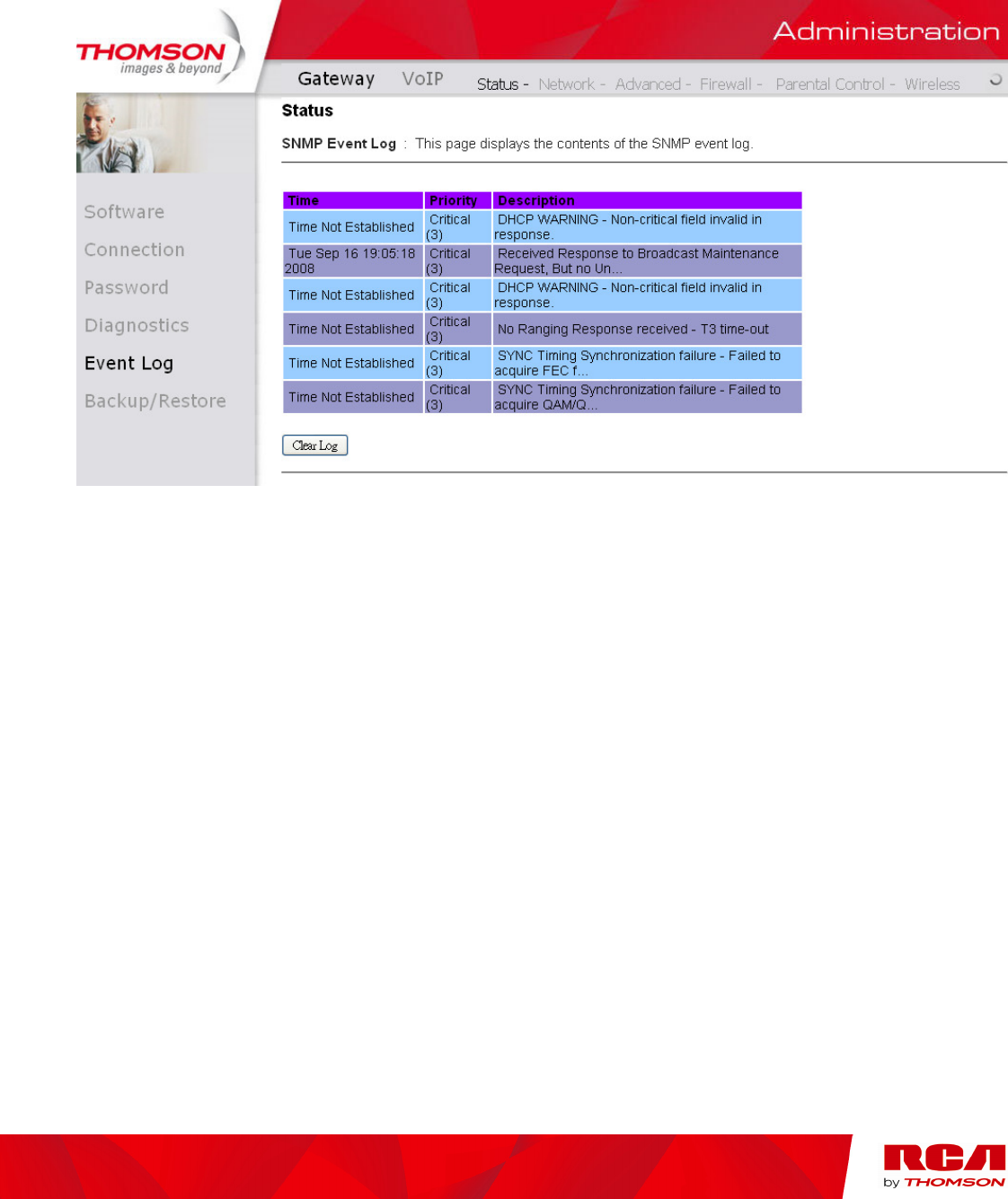
Chapter 2: Web Configuration
24
Illustrations contained in this document are for representation only.
5. Event Log
This page displays the content of the SNMP event log. Press “Clear Log” button to clear the logs.
Fig. 11 Gateway\Status\Event Log
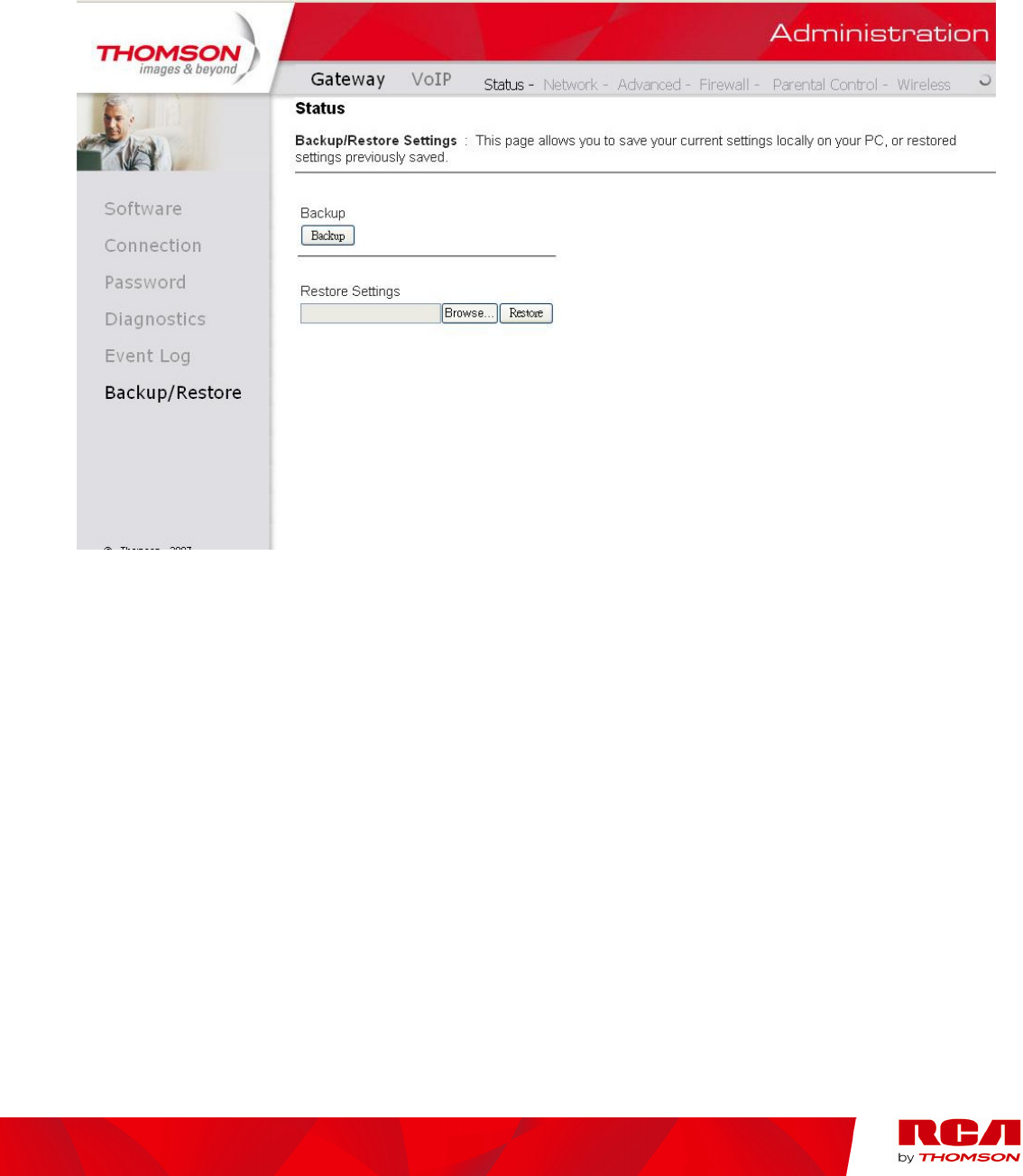
Chapter 2: Web Configuration
25
Illustrations contained in this document are for representation only.
6. Backup/Restore
This page allows you to save your current settings locally on your PC, or restored settings previously
saved.
Fig. 12 Gateway\Status\Backup/Restore
To backup the current configuration, click “Backup” and follow the prompts.
To restore a previous configuration, click “Browser” and use the navigation window to locate the file.
( UsuallyGatewaySettings.bin, unless you rename it before saving. ) Once the file has been located,
click “Restore” to restore the settings. Note that once the settings are restored, the device will reboot.
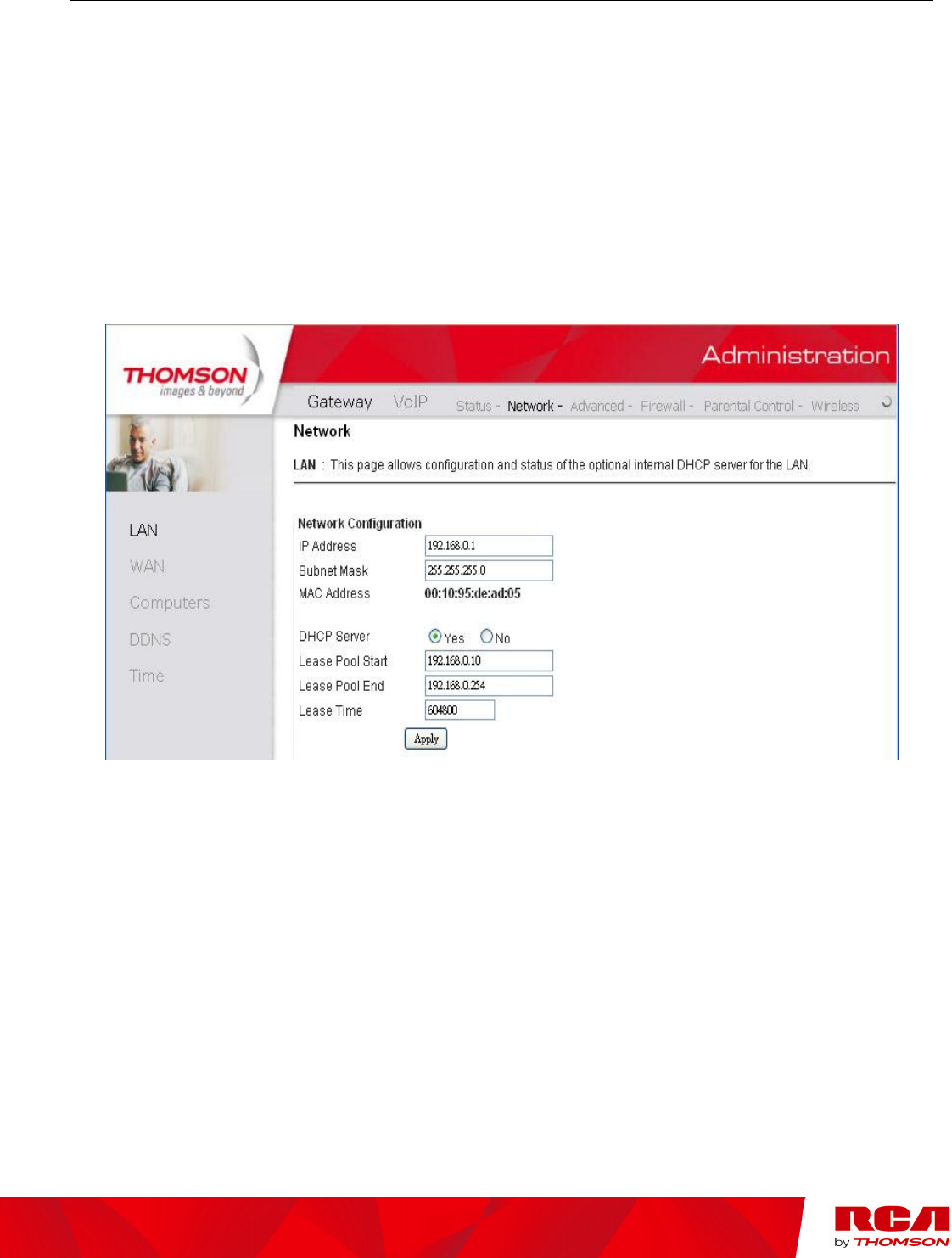
Chapter 2: Web Configuration
26
Illustrations contained in this document are for representation only.
Gateway – Network Web Page Group
1. LAN
You can activate the DHCP server function for the LAN on this page.
With this function activated, your cable company’s DHCP server provides one IP address for your
gateway, and your gateway’s DHCP server provides IP addresses, starting at the address you set in IP
Address on the LAN page, to your PCs. A DHCP server leases an IP address with an expiration time.
To change the lowest IP address that your gateway will issue to your PCs, enter it into the IP Address
box and then click Apply.
Fig. 13 Gateway\Network\LAN
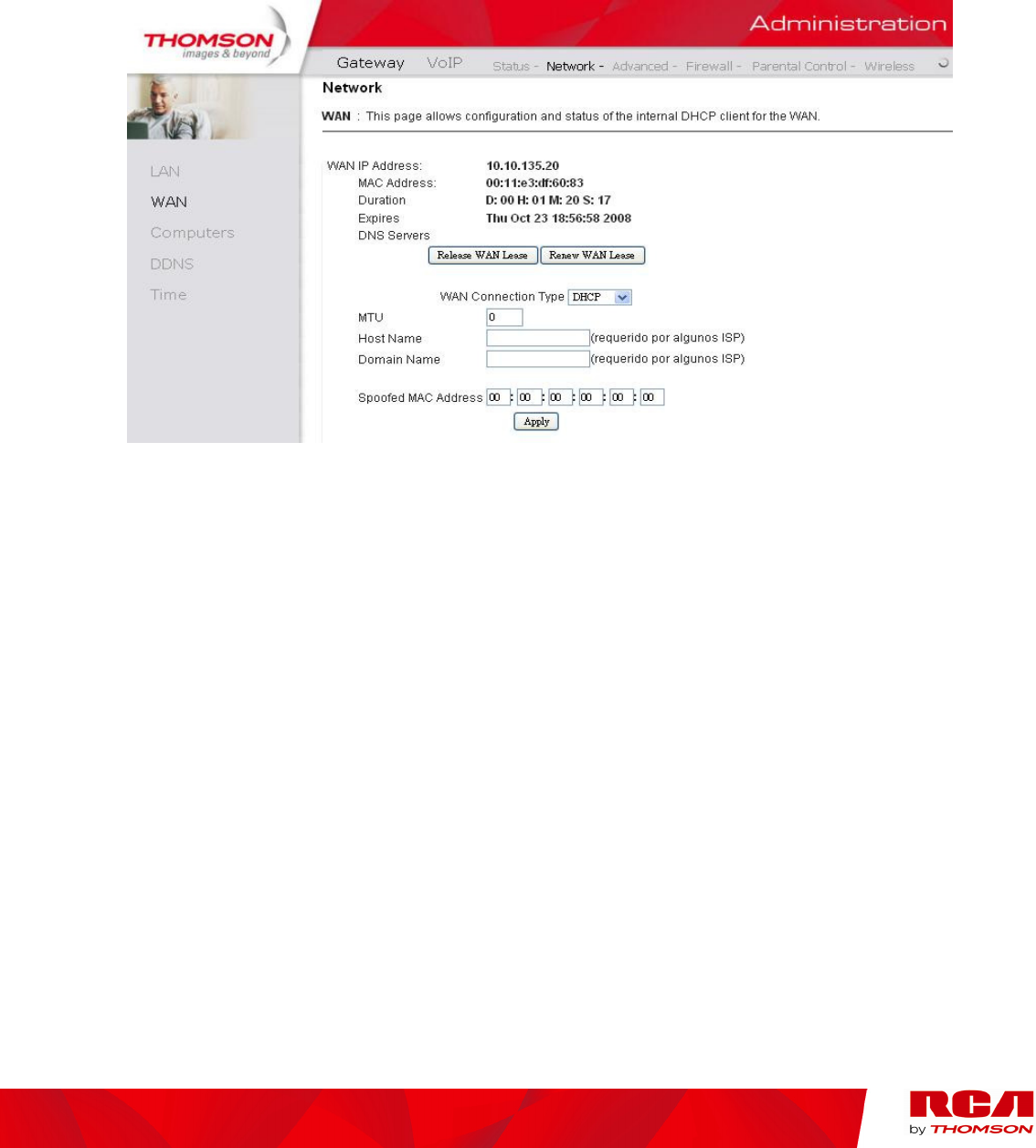
Chapter 2: Web Configuration
27
Illustrations contained in this document are for representation only.
2. WAN
You can configure the optional internal DHCP server for the WAN on this page. Select different WAN
Connection Type will lead to different contents. Take the WAN connection type-DHCP for example, you
can release and renew the WAN lease by pressing the buttons.
You can enter a spoofed MAC address that causes your gateway networking stack to use that MAC
address when communicating instead of the usual WAN MAC address, e.g., if the MAC address is
00:11:e3:df:66:95, this spoofed MAC address could be 00:11:e3:df:66:97 or any desired MAC address.
Fig. 14 Gateway\Network\WAN
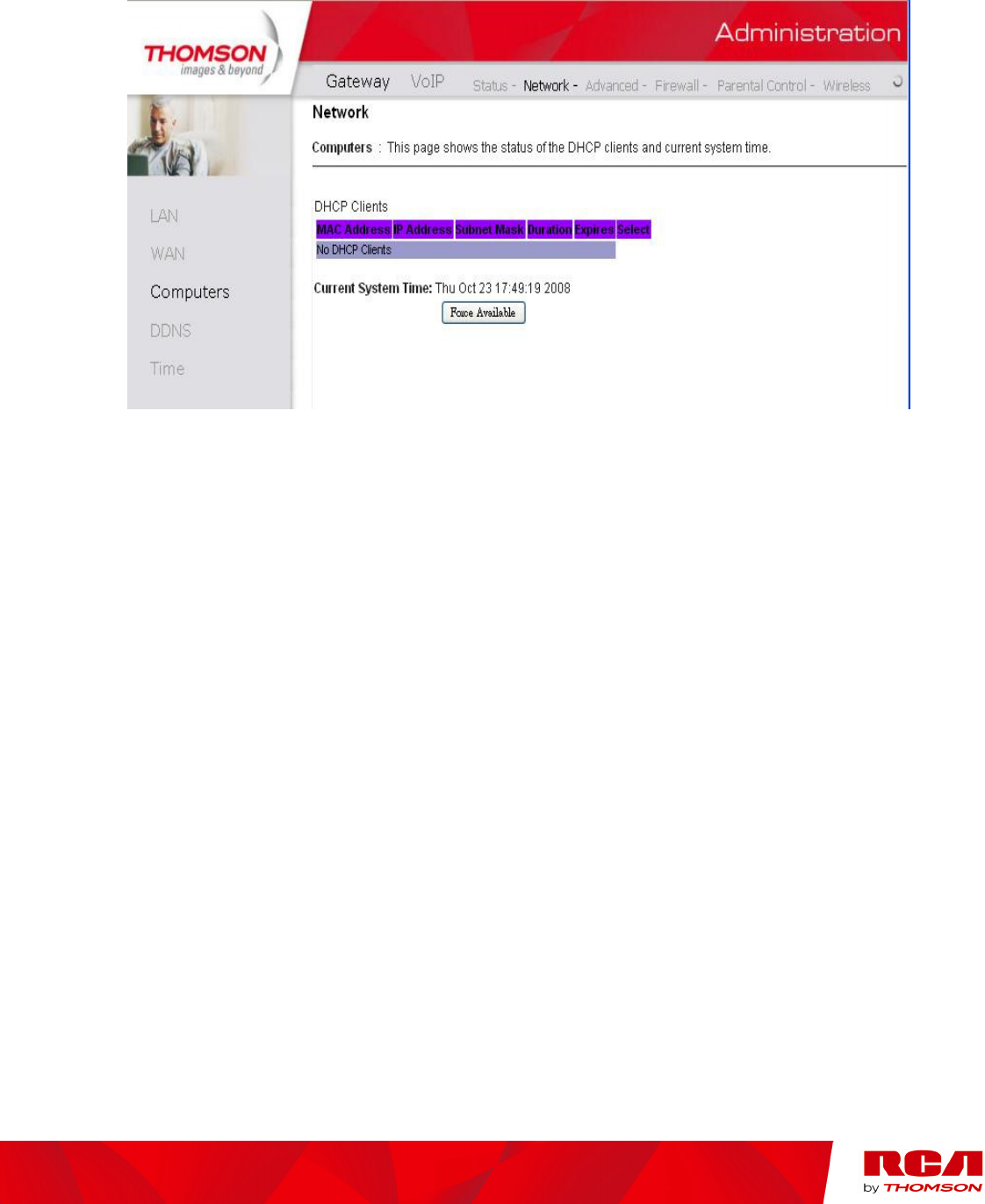
Chapter 2: Web Configuration
28
Illustrations contained in this document are for representation only.
3. Computers
This page displays the status of the DHCP clients and current system time. You can cancel an IP address
lease by selecting it in the DHCP Client Lease Info list and then clicking the Force Available button. If
you do so, you may have to perform a DHCP Renew on that PC, so that it can obtain a new lease.
Fig. 15 Gateway\Network\Computers
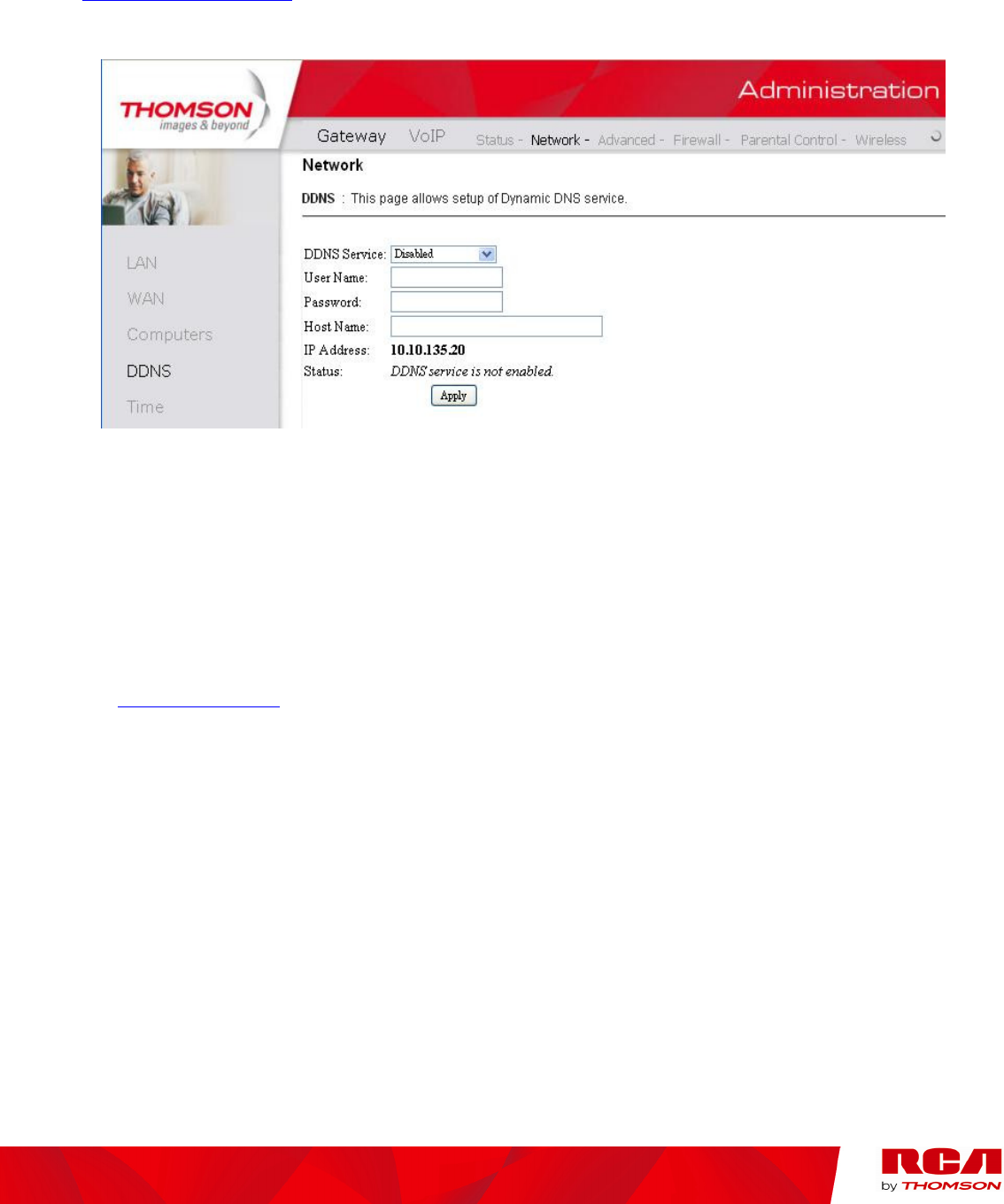
Chapter 2: Web Configuration
29
Illustrations contained in this document are for representation only.
4. DDNS
Dynamic DNS (DDNS) allows a dynamic IP address to be aliased to a static, pre-defined host name so
that the host can be easily contacted by other hosts on the internet even if its IP address changes. The
CMRG supports a dynamic CNS client compatible with the Dynamic DNS service
(http://www.dyndns.com/).
Fig. 16 Gateway\Network\DDNS
To activate the DDNS client:
1. Go to the DynDNS website and create an account for the Dynamic DNS service. You will create a
username and password, and be asked to choose a host name for your host’s current IP address. This
is the WAN IP address that has been assigned to your CMRG during provisioning.
2. Enter your account information on the DDNS web page, enable the service by selecting
www.DynDNS.org from the DDNS Service drop-down list, and click “Apply”.
3.
The DDNS client will notify the DDNS service whenever the WAN IP address changes so that your
chosen host name will be resolved properly by inquiring hosts. The current status of the service is
shown at the bottom of the DDNS web page.
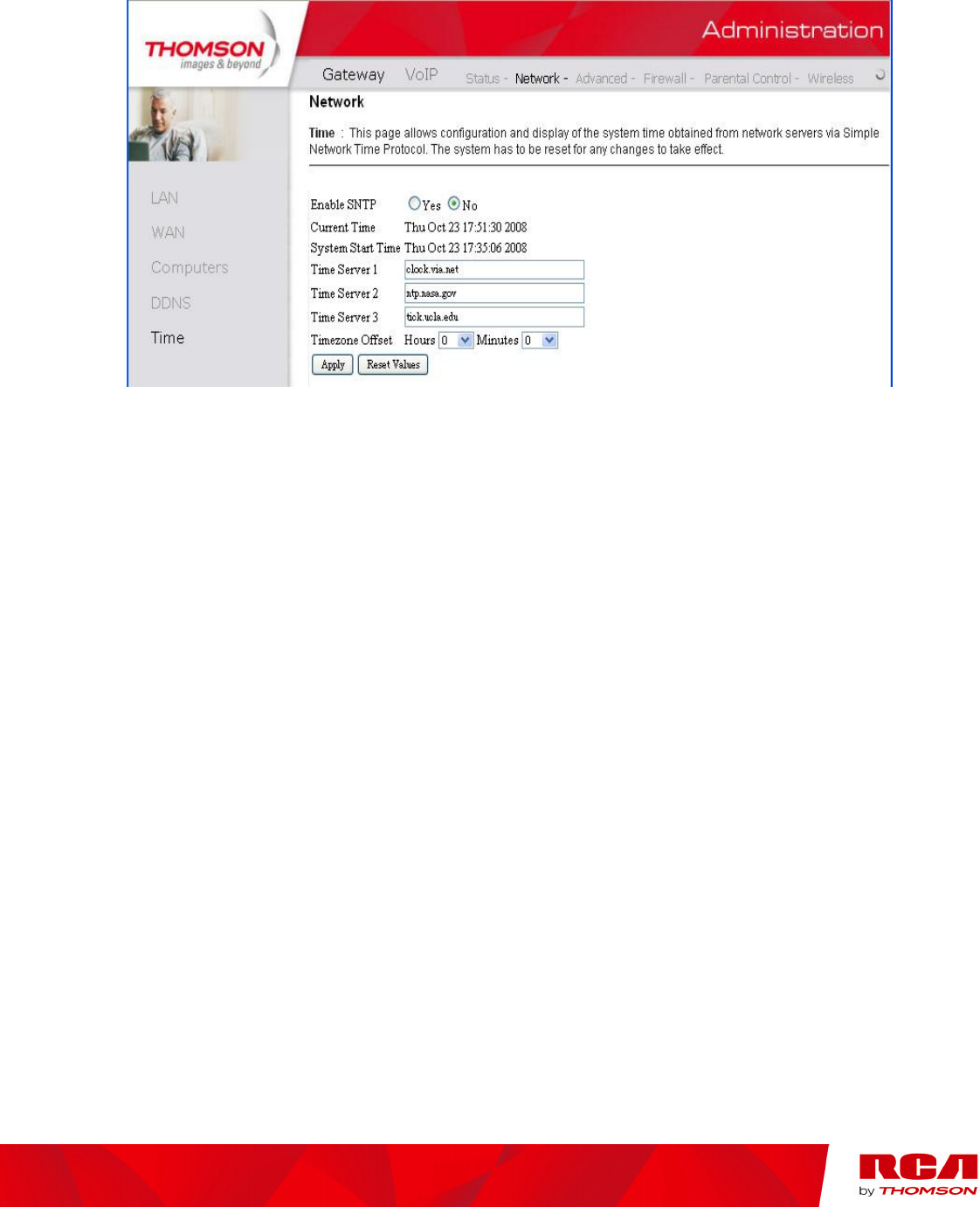
Chapter 2: Web Configuration
30
Illustrations contained in this document are for representation only.
5. Time
This page allows configuration and display of the system time obtained from network servers via simple
network protocol.
Fig. 17 Gateway\Network\Time
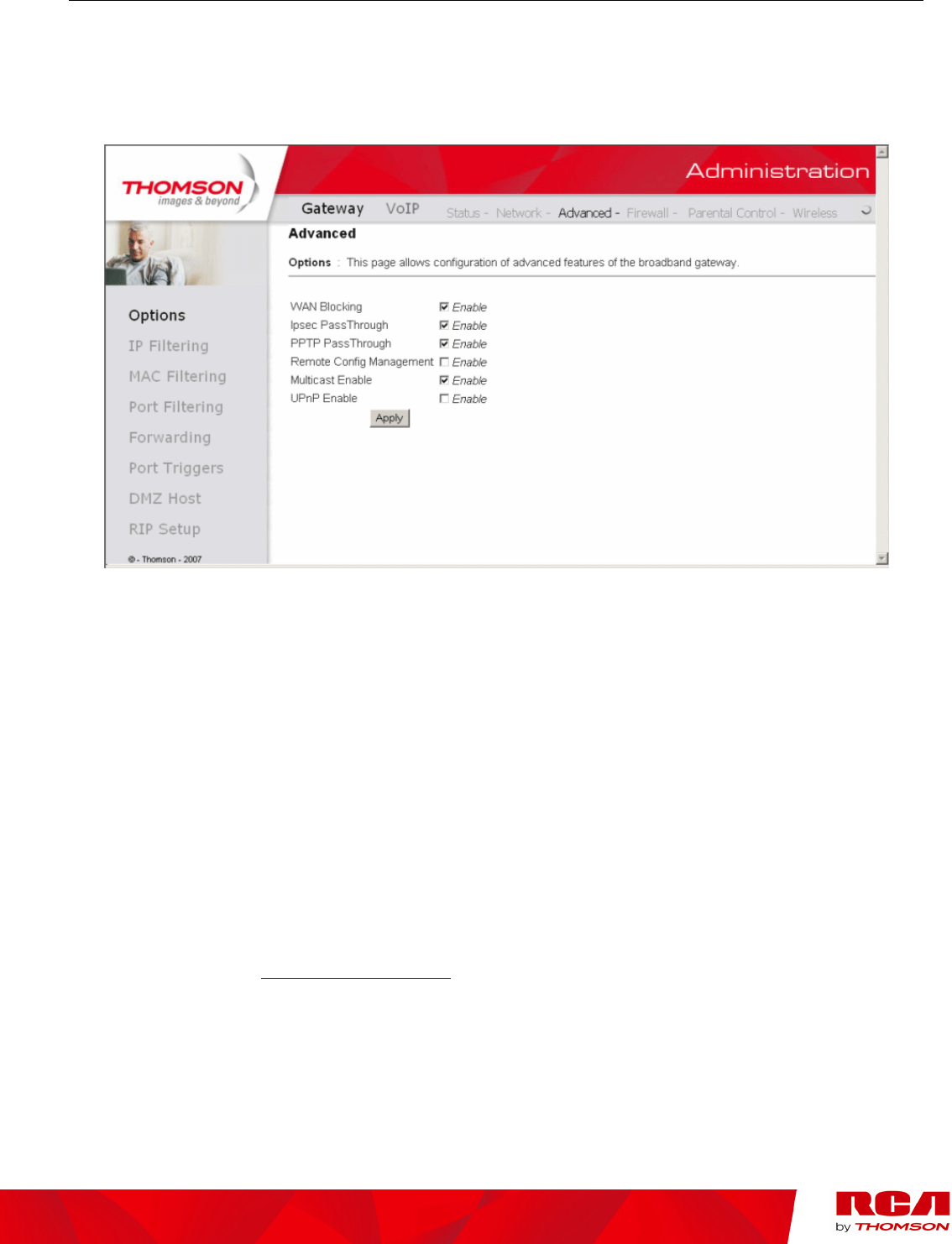
Chapter 2: Web Configuration
31
Illustrations contained in this document are for representation only.
Gateway – Advanced Web Page Group
1. Options
This page allows you to enable/disable some features of the Residential Voice Gateway.
Fig. 18 Gateway\Advnaced\Options
WAN Blocking prevents others on the WAN side from being able to ping your gateway. With WAN
Blocking enabled, your gateway will not respond to pings it receives, effectively “hiding” your
gateway.
Ipsec PassThrough enables IpSec type packets to pass WAN LAN. IpSec (IP Security) is a
security mechanism used in Virtual Private Networks (VPNs).
PPTP PassThrough enables PPTP type packets to pass WAN LAN. PPTP (Point to Point
Tunneling Protocol) is another mechanism sometimes used in VPNs.
Remote Config Management makes the configuration web pages in your gateway accessible from
the WAN side. Note that page access is limited to only those who know the gateway access
password. When accessing your gateway from a remote location, your must use HTTP port 8080
and the WAN IP address of the gateway. For example, if the WAN IP address is 157.254.5.7, you
would navigate to http://157.254.5.7:8080 to reach your gateway.
Multicast Enable enables multicast traffic to pass WAN LAN. You may need to enable this to
see some types of broadcast streaming and content on the Internet.
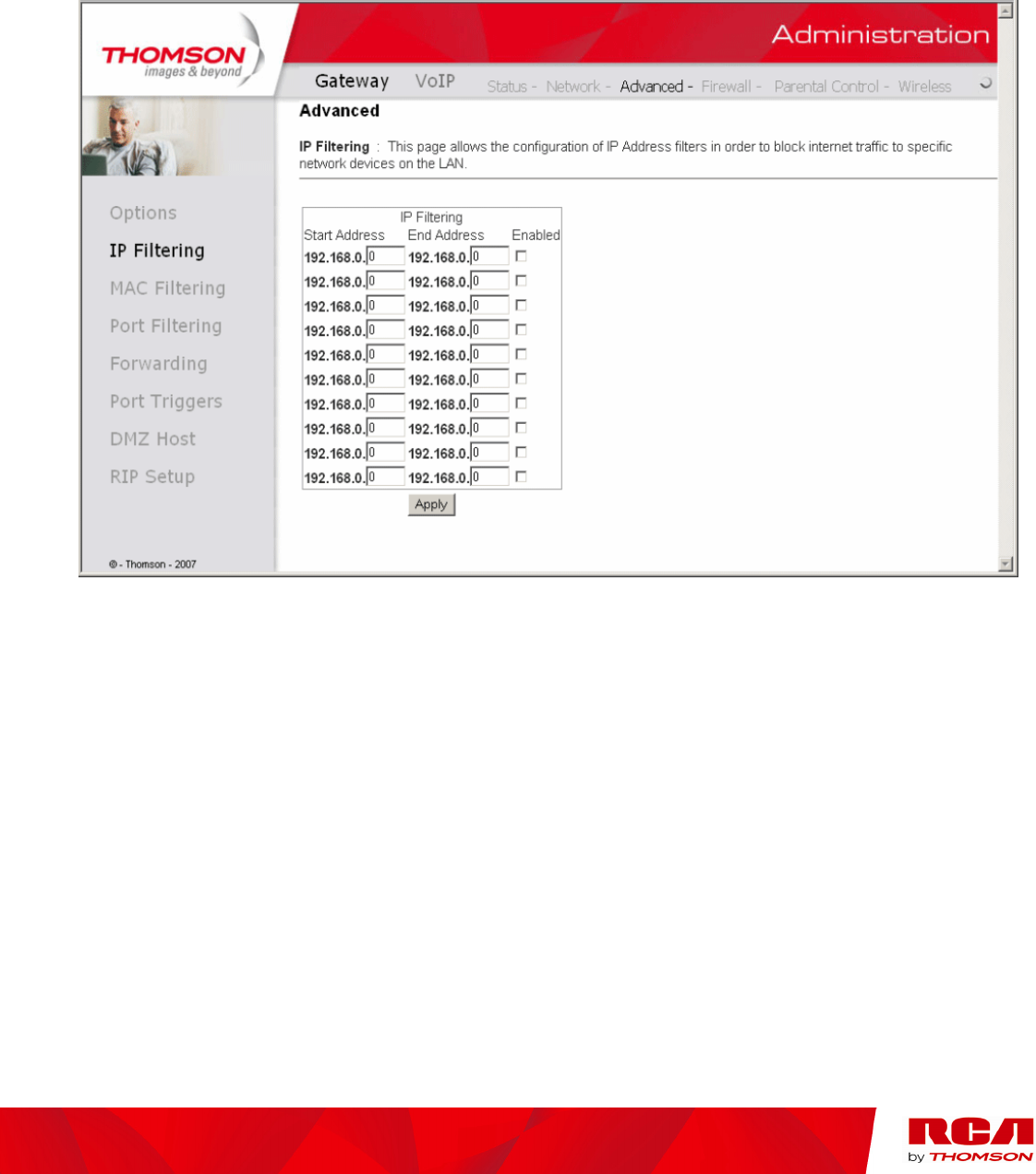
Chapter 2: Web Configuration
32
Illustrations contained in this document are for representation only.
2. IP Filtering
This page enables you to enter the IP address ranges of PCs on your LAN that you don’t want to have
outbound access to the WAN (Internet). These PCs can still communicate with each other on your LAN,
but traffic they originate to the WAN is blocked by the gateway.
Fig. 19 Gateway\Advnaced\IP Filtering
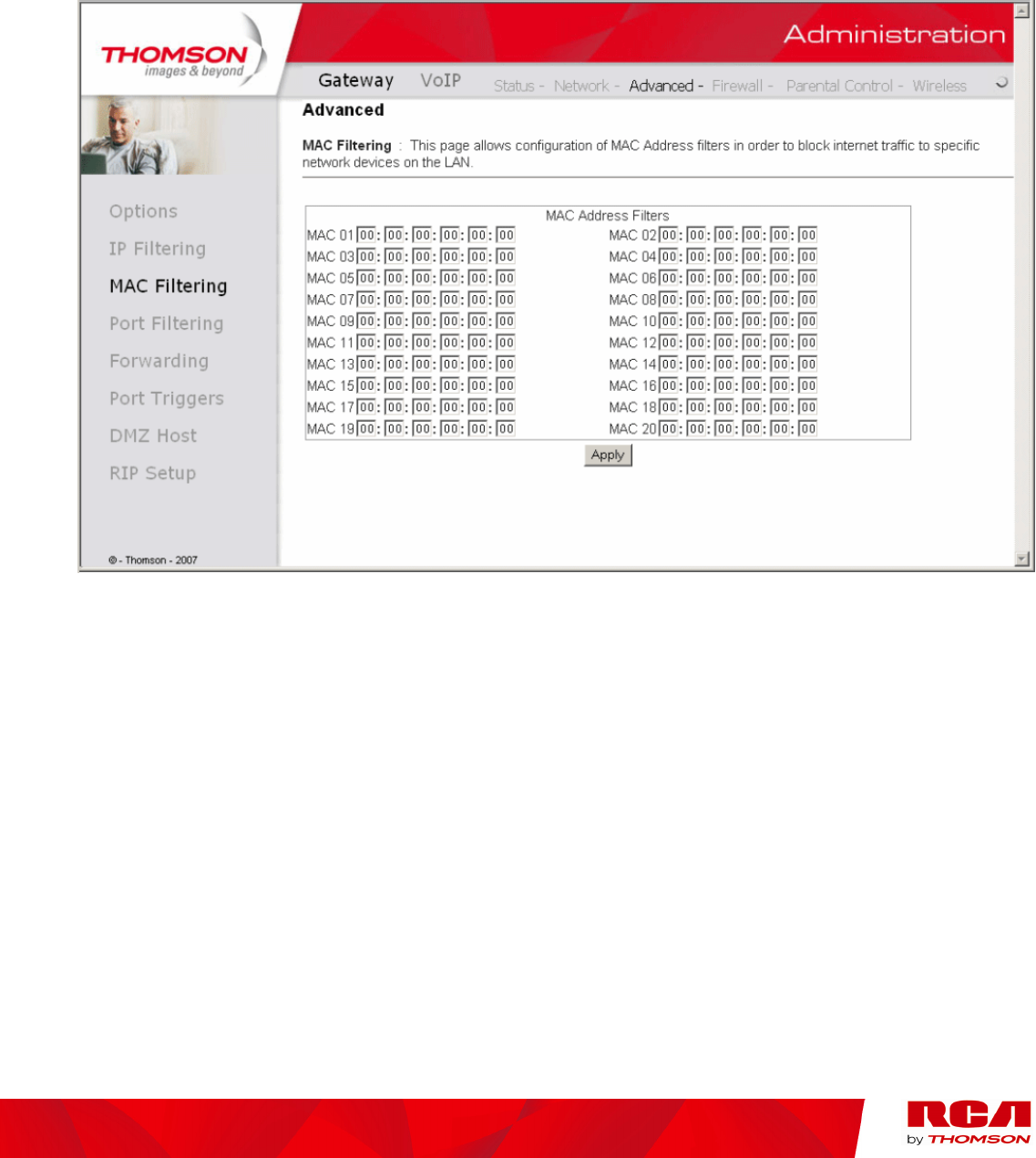
Chapter 2: Web Configuration
33
Illustrations contained in this document are for representation only.
3. MAC Filtering
This page enables you to enter the MAC address of specific PCs on your LAN that you wish to NOT
have outbound access to the WAN. As with IP filtering, these PCs can still communicate with each other
through the gateway, but packets they send to WAN addresses are blocked.
Fig. 20 Gateway\Advnaced\MAC Filtering
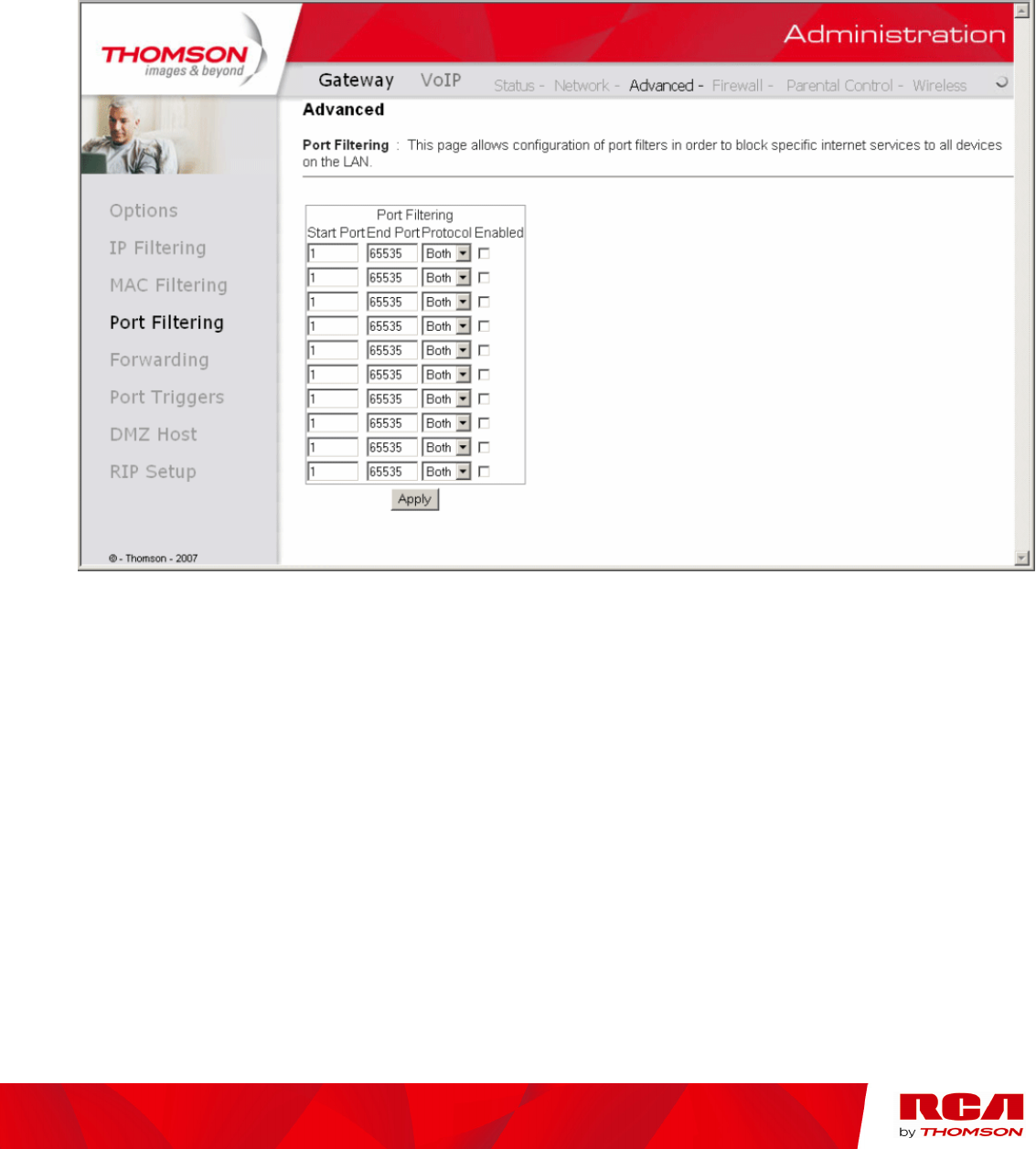
Chapter 2: Web Configuration
34
Illustrations contained in this document are for representation only.
4. Port Filtering
This page allows you to enter ranges of destination ports (applications) that you don’t want your LAN
PCs to send packets to. Any packets your LAN PCs send to these destination ports will be blocked. For
example, you could block access to worldwide web browsing (http = port 80) but still allow email
service (SMTP port 25 and POP-3 port 110). To enable port filtering, set Start Port and End Port for each
range, and click Apply. To block only one port, set both Start and End ports the same.
Fig. 21 Gateway\Advnaced\Port Filtering
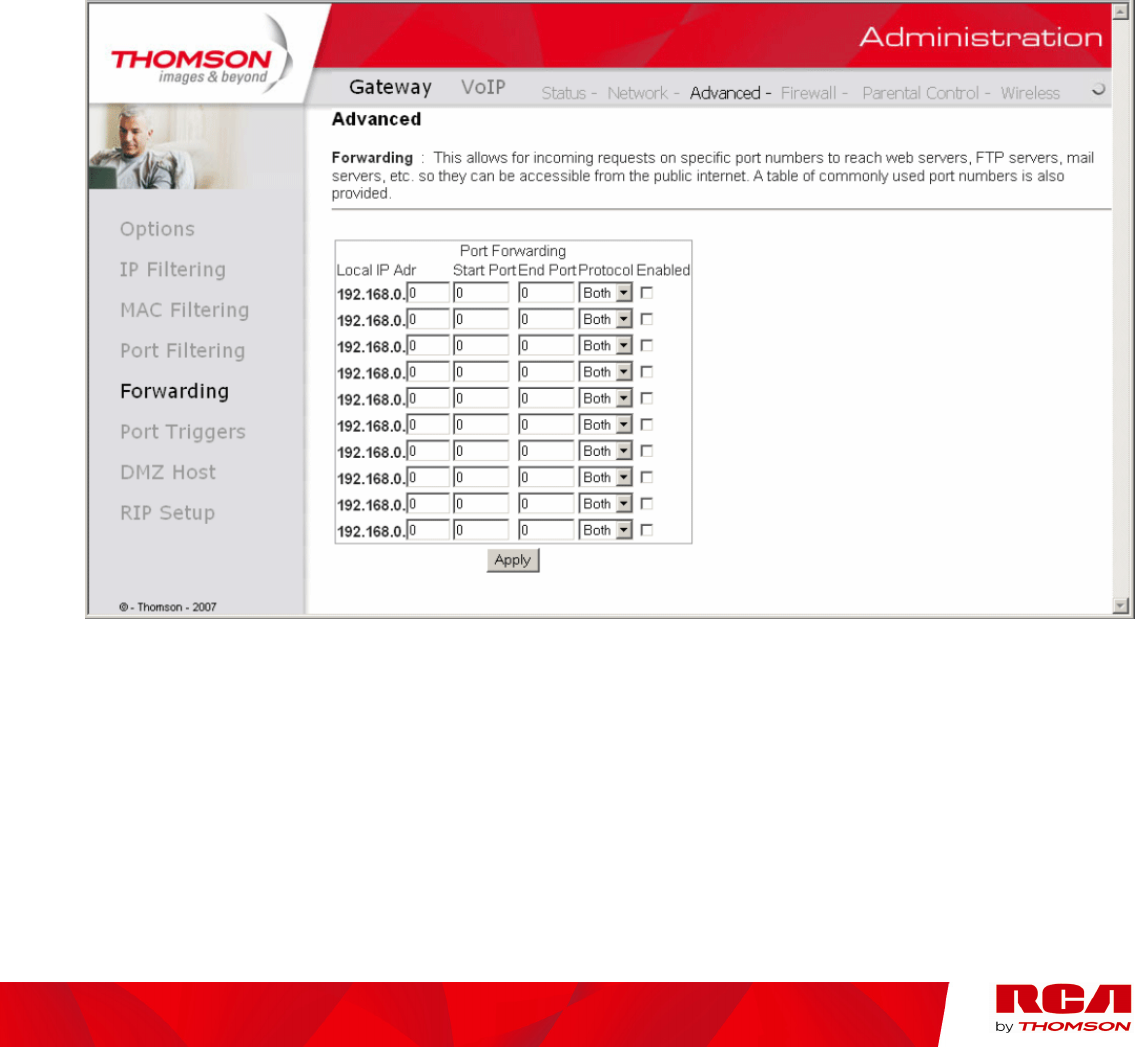
Chapter 2: Web Configuration
35
Illustrations contained in this document are for representation only.
5. Forwarding
For LAN WAN communications, the gateway normally only allows you to originate an IP connection
with a PC on the WAN; it will ignore attempts of the WAN PC to originate a connection onto your PC.
This protects you from malicious attacks from outsiders. However, sometimes you may wish for anyone
outside to be able to originate a connection to a particular PC on your LAN if the destination port
(application) matches one you specify.
This page allows you to specify up to 10 such rules. For example, to specify that outsiders should have
access to an FTP server you have running at 192.168.0.5, create a rule with that address and Start Port
=20 and End Port =21 (FTP port ranges) and Protocol = TCP (FTP runs over TCP and the other transport
protocol, UDP), and click Apply. This will cause inbound packets that match to be forwarded to that PC
rather than blocked. As these connections are not tracked, no entry is made for them in the Connection
Table. The same IP address can be entered multiple times with different ports.
Fig. 22 Gateway\Advnaced\Forwarding
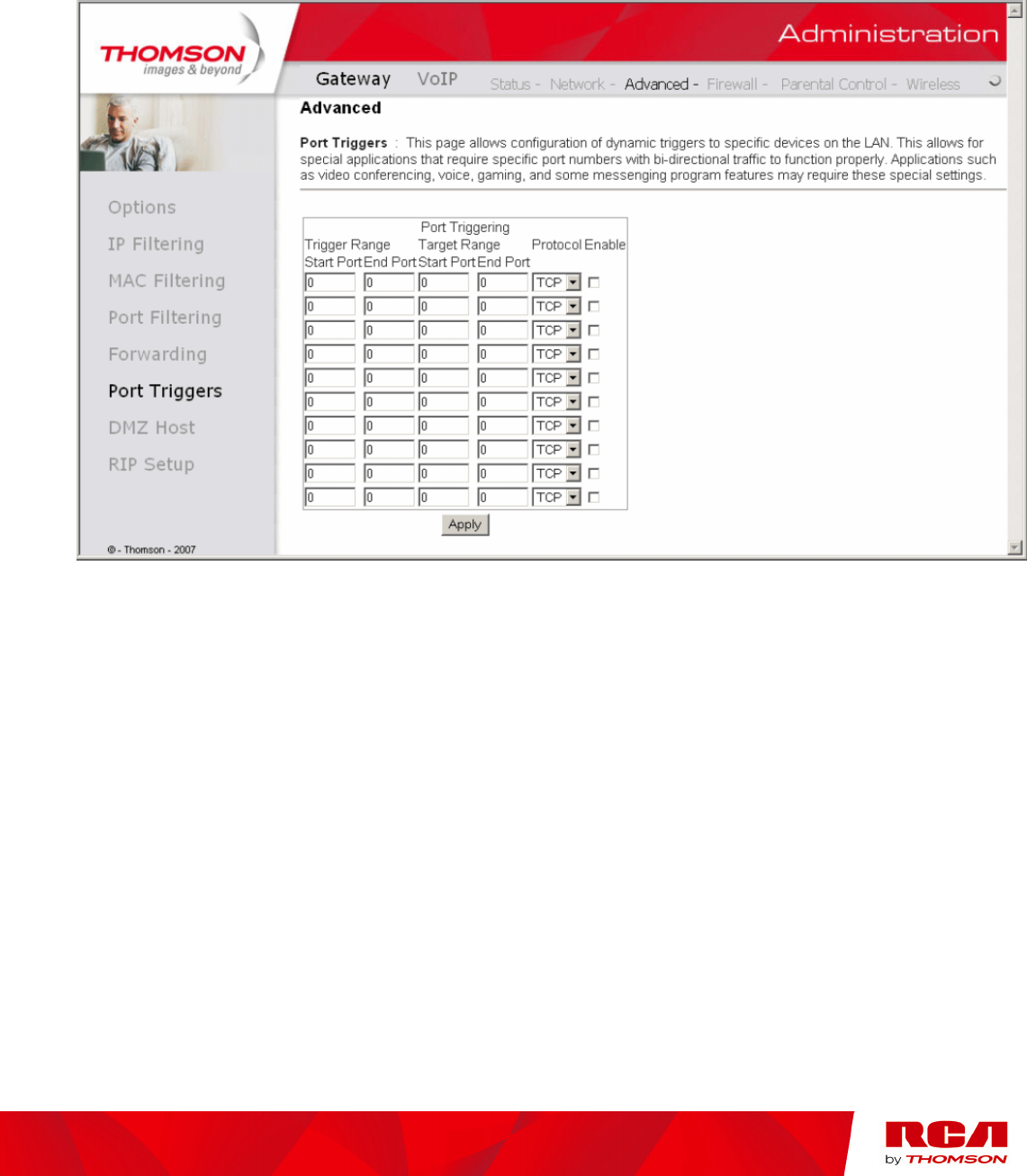
Chapter 2: Web Configuration
36
Illustrations contained in this document are for representation only.
6. Port Triggers
Some Internet activities, such as interactive gaming, require that a PC on the WAN side of your gateway
be able to originate connections during the game with your game playing PC on the LAN side. You could
use the Advanced-Forwarding web page to construct a forwarding rule during the game, and then remove
it afterwards (to restore full protection to your LAN PC) to facilitate this. Port triggering is an elegant
mechanism that does this work for you, each time you play the game.
Fig. 23 Gateway\Advnaced\Port Triggers
Port Triggering works as follows. Imagine you want to play a particular game with PCs somewhere on
the Internet. You make one time effort to set up a Port Trigger for that game, by entering into Trigger
Range the range of destination ports your game will be sending to, and entering into Target Range the
range of destination ports the other player (on the WAN side) will be sending to (ports your PC’s game
receives on). Application programs like games publish this information in user manuals. Later, each time
you play the game, the gateway automatically creates the forwarding rule necessary. This rule is valid
until 10 minutes after it sees game activity stop. After 10 minutes, the rule becomes inactive until the
next matched outgoing traffic arrives.
For example, suppose you specify Trigger Range from 6660 to 6670 and Target Range from 113 to 113.
An outbound packet arrives at the gateway with your game-playing PC source IP address 192.168.0.10,
destination port 666 over TCP/IP. This destination port is within the Trigger destined for port 113 to your
game-playing PC at 192.168.0.10.
You can specify up to 10 port ranges on which to trigger.
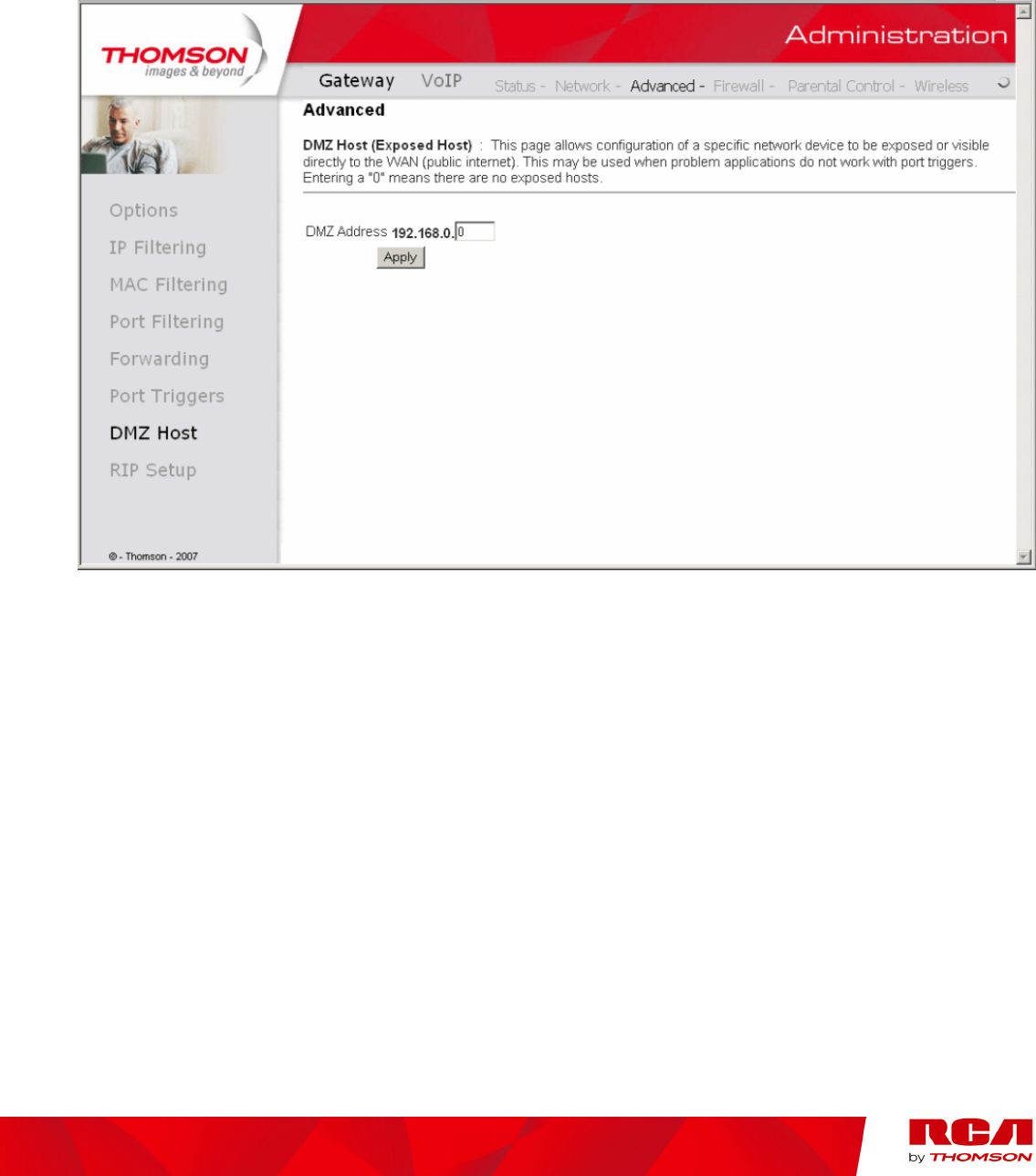
Chapter 2: Web Configuration
37
Illustrations contained in this document are for representation only.
7. DMZ Host
Use this page to designate one PC on your LAN that should be left accessible to all PCs from the WAN
side, for all ports. For example, if you put an HTTP server on this machine, anyone will be able to access
that HTTP server by using your gateway IP address as the destination. A setting of “0” indicates NO
DMZ PC. “Host” is another Internet term for a PC connected to the Internet.
Fig. 24 Gateway\Advnaced\DMZ Host
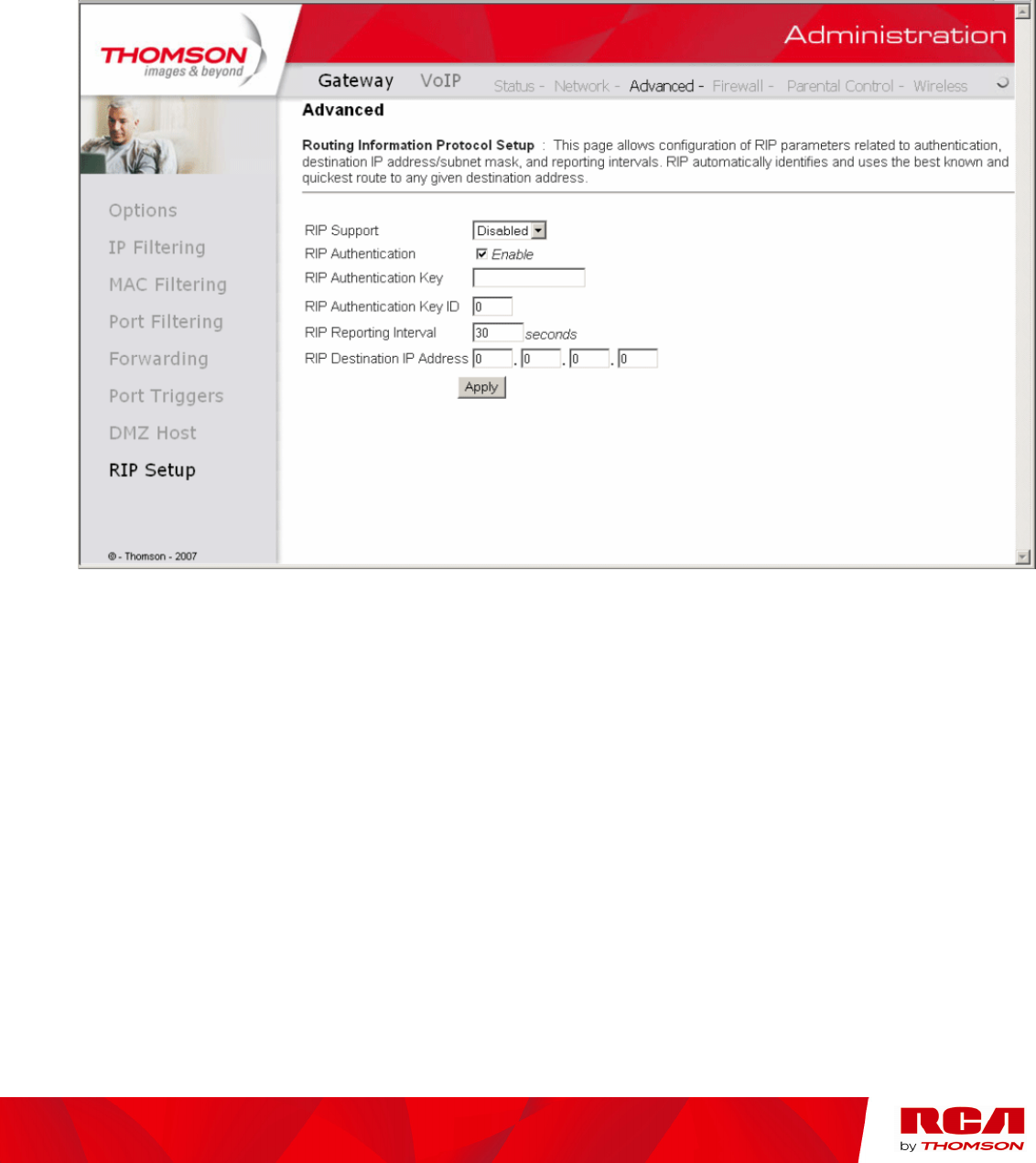
Chapter 2: Web Configuration
38
Illustrations contained in this document are for representation only.
8. RIP (Routing Information Protocol) Setup
This feature enables the gateway to be used in small business situations where more than one LAN (local
area network) is installed. The RIP protocol provides the gateway a means to “advertise” available IP
routes to these LANs to your cable operator, so packets can be routed properly in this situation.
Your cable operator will advise you during installation if any setting changes are required here.
Fig. 25 Gateway\Advnaced\RIP Setup

Chapter 2: Web Configuration
39
Illustrations contained in this document are for representation only.
Gateway – Firewall Web Page Group
1. Web Content Filtering
These pages allow you to enable, disable, and configure a variety of firewall features associated with
web browsing, which uses the HTTP protocol and transports HTML web pages. On these pages, you
designate the gateway packet types you want to have forwarded or blocked. You can activate settings by
checking them and clicking Apply.
The web-related filtering features you can activate from the Web Content Filter page include Filter Proxy,
Filter Cookies, Filter Java Applets, Filter ActiveX, Filter Popup Windows, and Firewall Protection.
If you want the gateway to exclude your selected filters to certain computers on your LAN, enter their
MAC addresses in the Trusted Computers area of this page.
Fig. 26 Gateway\Firewall\Web Filter
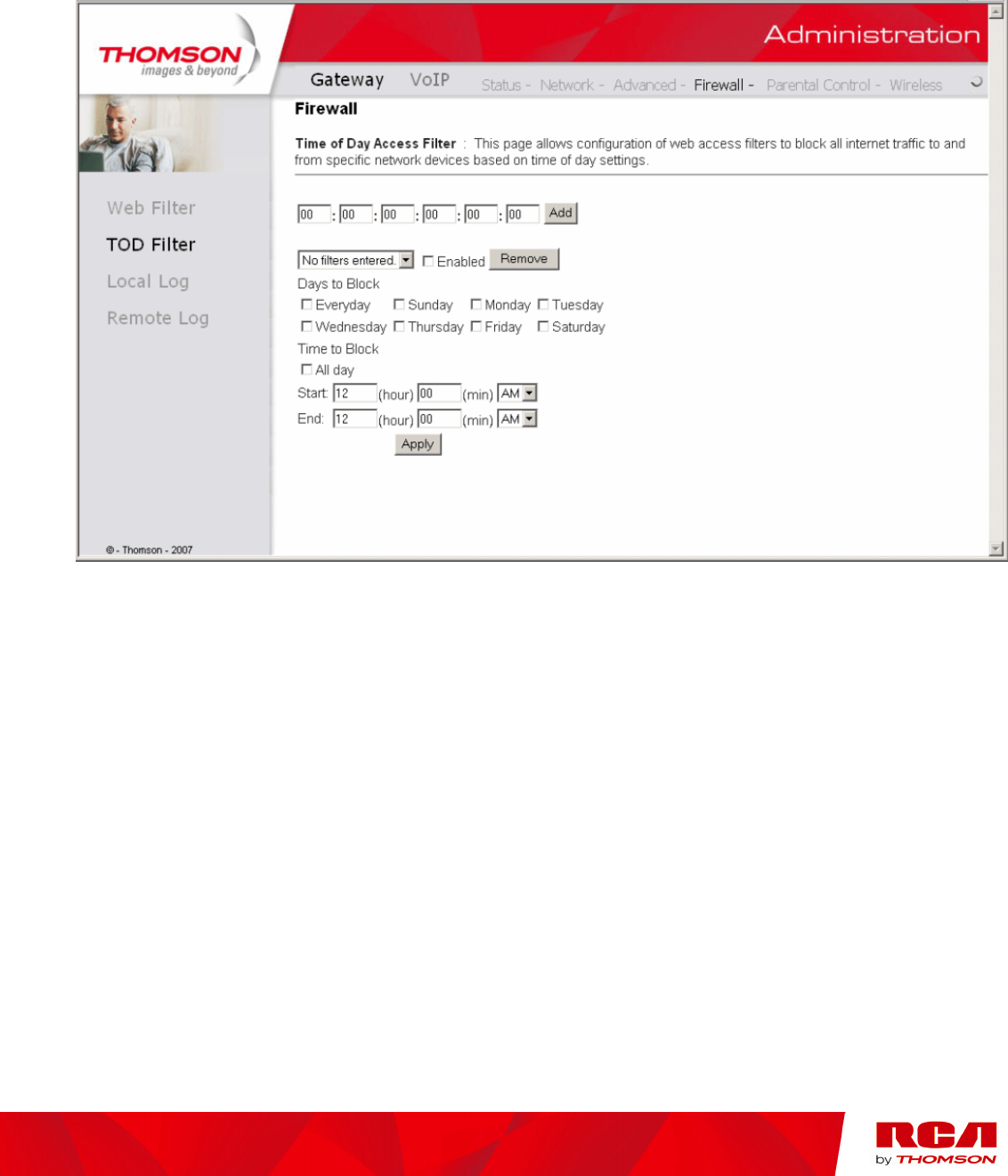
Chapter 2: Web Configuration
40
Illustrations contained in this document are for representation only.
2. TOD Access Filtering
Use this page to set rules that will block specific LAN side PCs from accessing the Internet, but only at
specific days and times. Specify a PC by its hardware MAC address, and then use the tools to specify
blocking time. Finally, click the Apply button to save your settings.
Fig. 27 Gateway\Firewall\TOD Filter
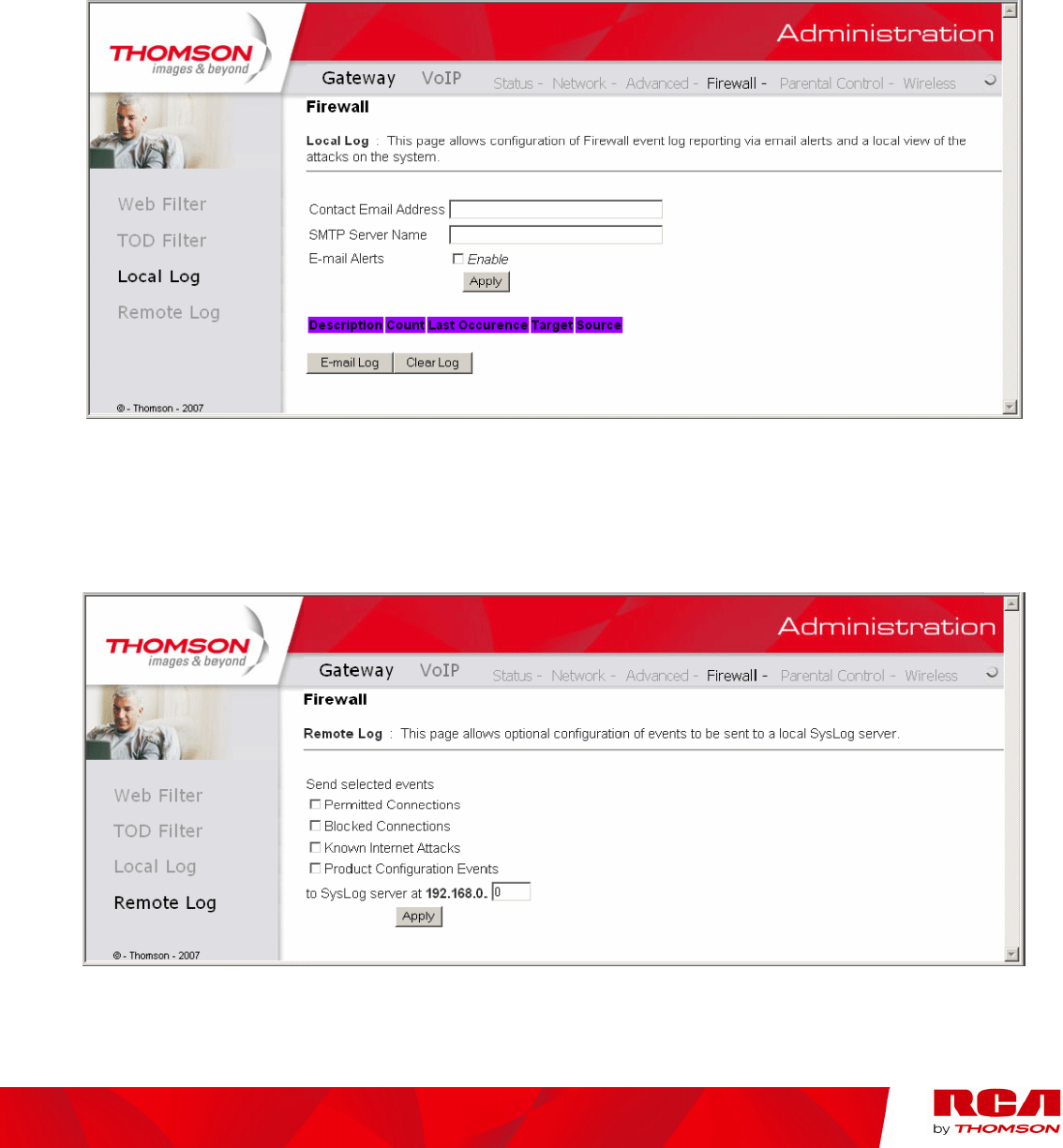
Chapter 2: Web Configuration
41
Illustrations contained in this document are for representation only.
3. Local Log and Remote Log
The gateway builds a log of firewall blocking actions that Firewall has taken. Using the Local Log
page lets you specify an email address to which you want the gateway to email this log. You must also
tell the gateway your outgoing (i.e. SMTP) email server’s name, so it can direct the email to it. Enable
Email Alerts has the gateway forward email notices when Firewall protection events occur. Click E-mail
Log to immediately send the email log. Click Clear Log to clear the table of entries for a fresh start.
The log of these events is also visible on the screen. For each blocking event type that has taken place
since the table was last cleared, the table shows Description, Count, Last Occurrence, Target, and Source.
Fig. 28 Gateway\Firewall\Local Log
The Remote Log page allows you to specify the IP address where a SysLog server is located and select
different types of firewall events that may occur. Then, each time such an event occurs, notification is
automatically sent to this log server.
Fig. 29 Gateway\Firewall\Remote Log
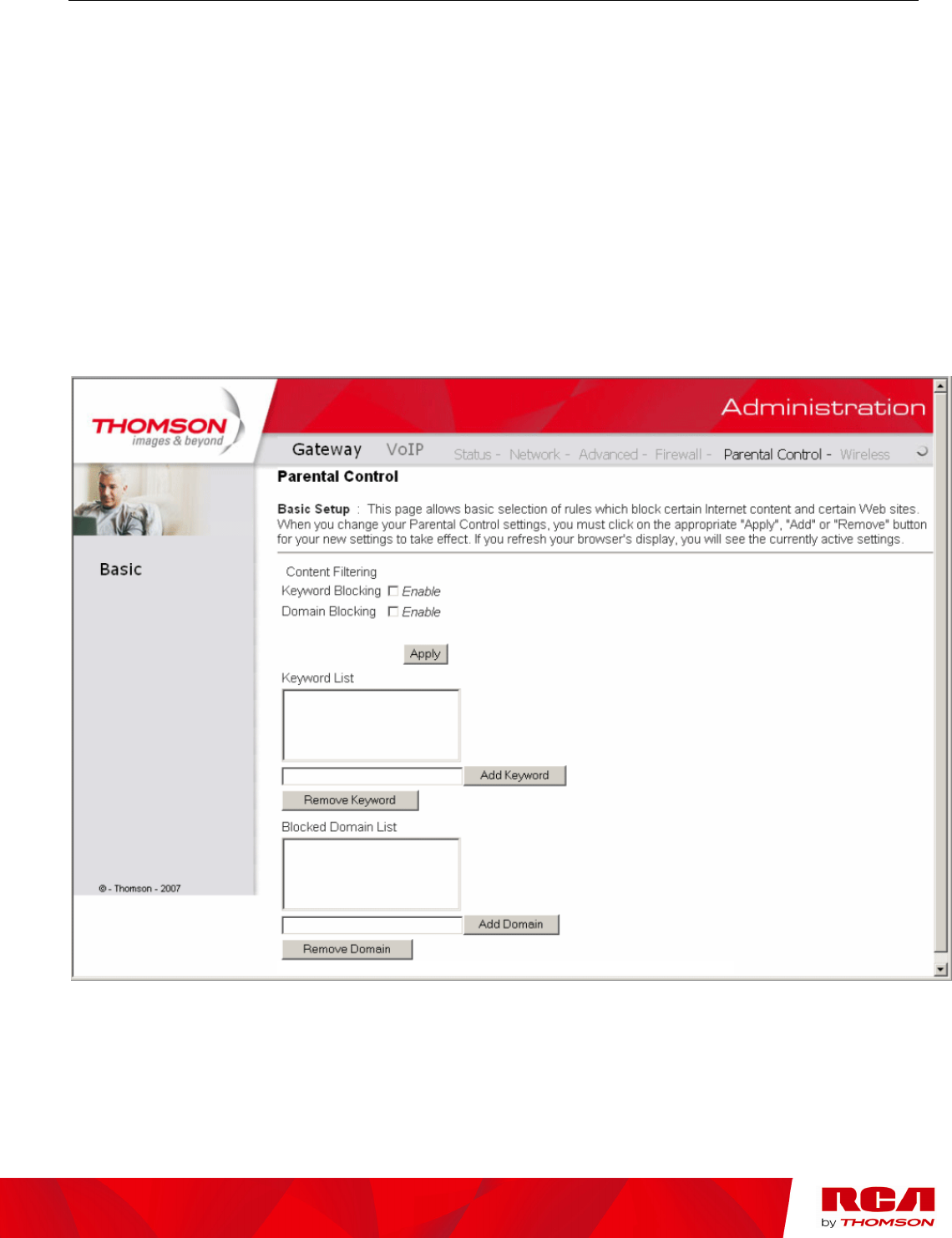
Chapter 2: Web Configuration
42
Illustrations contained in this document are for representation only.
Gateway – Parental Control Web Page Group
Basic Setup
This page allows you to enable, disable, and configure a variety of firewall features associated with web
browsing, which uses the HTTP protocol and transports HTML web pages. On these pages, you
designate the gateway packet types you want to have forwarded or blocked. You can activate settings by
checking them and clicking Apply.
Here are some of your choices on the Parental Control page:
Activate Keyword Blocking and specify some keywords in the Keyword List to cause blocking of
web pages on the WAN side with the specified keyword in the content.
Activate Domain Blocking and specify some Domain Names (e.g. disney.com) in the Domain List.
Fig. 30 Gateway\Parental Control\Basic

Chapter 2: Web Configuration
43
Illustrations contained in this document are for representation only.
Gateway – Wireless Web Page Group
Important: Changes to the wireless web pages should be made from a PC that is directly connected to
the gateway.
The Wireless web pages group enables a variety of settings that can provide secure and reliable wireless
communications for even the most demanding tech-savvy user.
The DWG855 gateway offers a choice of 802.1x, WPA and WPA-PSK authentication of your PCs to the
gateway, 64 and 128 bit WEP encryption of communication between the gateway and your PCs to
guaranty security, and an Access Control List function that enables you to restrict wireless access to only
your specific PCs.
The wireless function will probably work in your home as shipped from the factory, but without the
security features activated. In addition, the factory default wireless channel setting may not provide
optimum changes are recommended from the factory defaults, to secure your wireless communications
and provide optimum performance.
Performance
Because your wireless communication travels through the air, the factory default wireless channel setting
may not provide optimum performance in your home if you or your neighbors have other interfering
2.4GHz devices such as cordless phones. If your wireless PC is experiencing very sluggish or
dramatically slower communication compared with the speed you achieve on your PC that is wired to the
gateway, try changing the channel number. See the 802.11b/g Basic Web Page discussion below for
details.
Authentication
Authentication enables you to restrict your gateway from communicating with any remote wireless PCs
that aren’t yours. The following minimum authentication-related changes to factory defaults are
recommended. See the 802.11b/g Basic and Access Control Web Page discussions below for details.
Network Name (SSID) – Set a unique name you choose
Network Type – Set to Open
Access Control List – Enter your wireless PCs’ MAC addresses
Security
Security secures or scrambles messages traveling through the air between your wireless PCs and the
gateway, so they can’t be observed by others. The following minimum security setting changes to factory
defaults are recommended. See the 802.11b/g Security Web Page discussion below for details.
Data Encryption – Set to WEP (64-bit)
PassPhrase – Use this feature to generate security keys
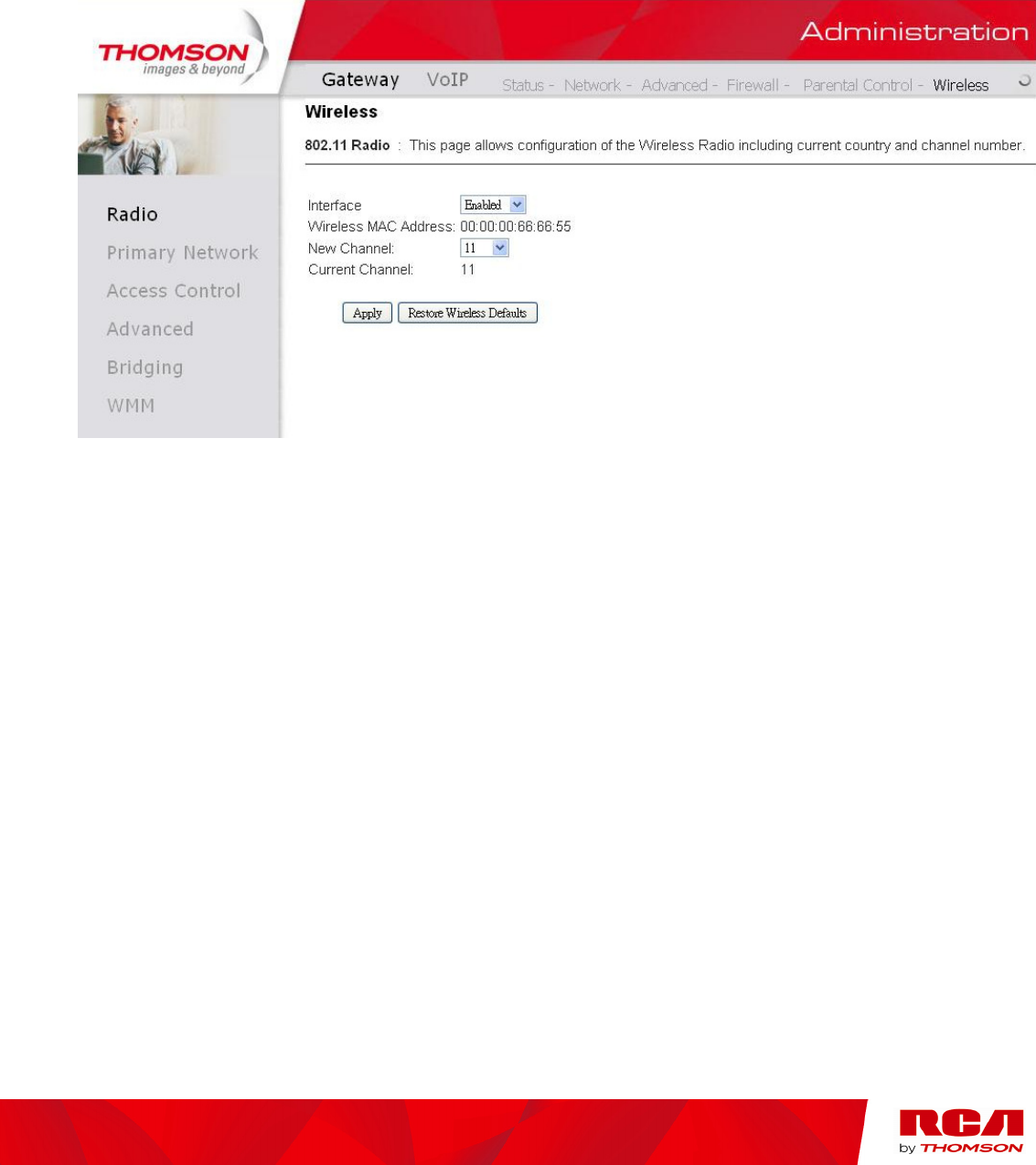
Chapter 2: Web Configuration
44
Illustrations contained in this document are for representation only.
1. Radio
This page allows configuration of the Wireless Radio including current country and channel number.
Press “Apply” button to enable the new setting that you have changed or press “Restore Wireless
Defaults” button to restore to defaults setting.
Fig. 31 Gateway\Wireless\Radio
Interface: The wireless radio in your gateway can be completely de-activated by changing Interface to
Disabled. Click the Apply button to save your settings. If you want to re-activate the disabled wireless radio
in your gateway, need to contact cable operator.
Wireless MAC Address: The MAC address for this wireless device will be displayed in this field
automatically.
New Channel: There are 13 channels that you can choose. Choose the one that is suitable for this device.
Current Channel: The channel that you choose will be displayed in this field.
Restore Wireless defaults: To recover to the default settings, press this button to retrieve the settings and click
Apply.
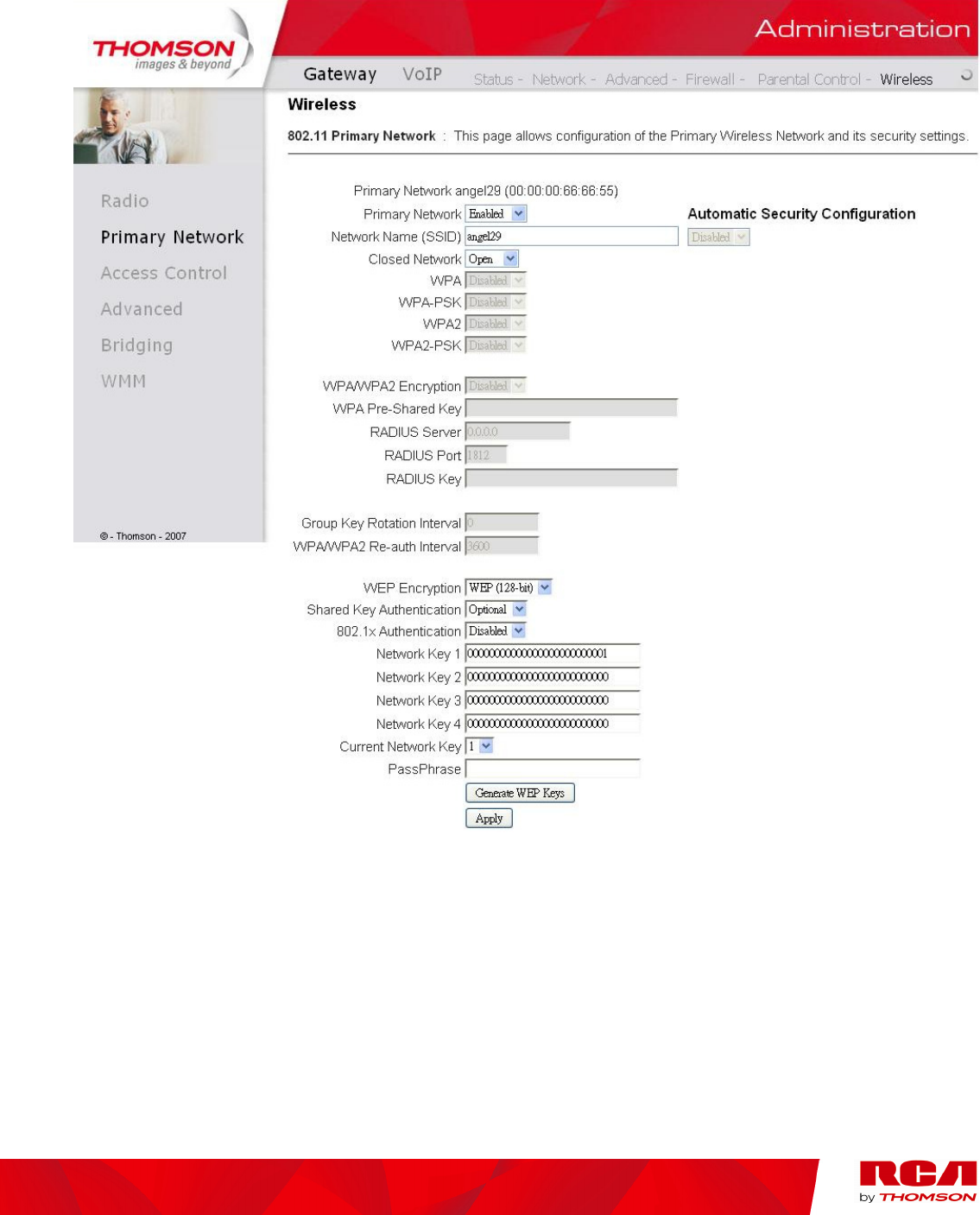
Chapter 2: Web Configuration
45
Illustrations contained in this document are for representation only.
2. Primary Network
This page allows you to configure the Network Authentication. Here provides several different modes of
wireless security. You will have to enter proper information according to the mode you select.
Fig. 32 Gateway\Wireless\Primary Network
Primary Network: It is used to Enable or Disable the whole Primary Network feature.
Network Name (SSID): By using this you can change the factory default to a name of your choice up to 32
characters long.
Closed Network: This control is used to hide or reveal your network name (SSID) to any remote, wireless
equipped PC in the area that may be scanning WiFi channels to find available WiFi networks. The gateway WiFi
radio frequently transmits a beacon signal which can contain this network name (SSID). If you set Closed

Chapter 2: Web Configuration
46
Illustrations contained in this document are for representation only.
Network to Enable, your SSID is included in that beacon, and is therefore detectable by any nearby wireless
equipped PCs in the area. The benefit of using Enable is it can speed your WiFi setup on some PCs. If you set
Closed Network to Disable, your SSID is not included in the beacon. This hides your network name (SSID), but as
a result may require a bit more effort on your part to set up your wireless PCs. And when we Enable the WPS
Config then the Closed Network will be Disabled automatically.
WPA (Wi-Fi Protected Access)/WPA2:
It must be used in conjunction with an authentication server such as RADIUS to provide centralized
access control and management. It can provide stronger encryption and authentication solution than none
WPA modes. WPA2 is the second generation of WPA security
WPA-PSK (WPA-Pre-Shared Key) /WPA2-PSK (WPA2-Pre-Shared Key):
It is useful for small places without authentication servers such as the network at home. It allows the use
of manually-entered keys or passwords and is designed to be easily set up for home users.
WEP Encryption:
You can choose 64-bit or 128-bit according to your needs. If you choose Disabled, the Network Keys
will not be shown on this page. If selected, the data is encrypted using the key before being transmitted.
For example, if you set 128-bit in this field, then the receiving station must be set to use the128 Bit
Encryption, and have the same Key value too. Otherwise, it will not be able to decrypt the data.
( Note: You need to connect one end of the Ethernet cable to the Ethernet port on the back of your
computer, and the other end to the ETHERNET port on the Residential Voice Gateway. )
If you select WEP (64-bit or 128-bit), you can adjust the following settings-
Shared Key Authentication: Decide whether to set the shared key Optional or Required by
selecting from the drop-down menu.
Network Key 1 to 4: The system allows you to enter four sets of the WEP key. For 64-bit WEP
mode, the key length is 5 characters or 10 hexadecimal digits. As for 128-bit WEP mode, the key
length is 13 characters or 26 hexadecimal digits.
Current Network Key: Select one set of the network key (from 1 to 4) as the default one.
PassPhrase: You can enter ASCII codes into this field. The range is from 8 characters to 64
characters. For ASCII characters, you can key in 63 characters in this field. If you want to key in 64
characters, only hexadecimal characters can be used.
Generate WEP Keys: Click this button to generate the PassPhrase.
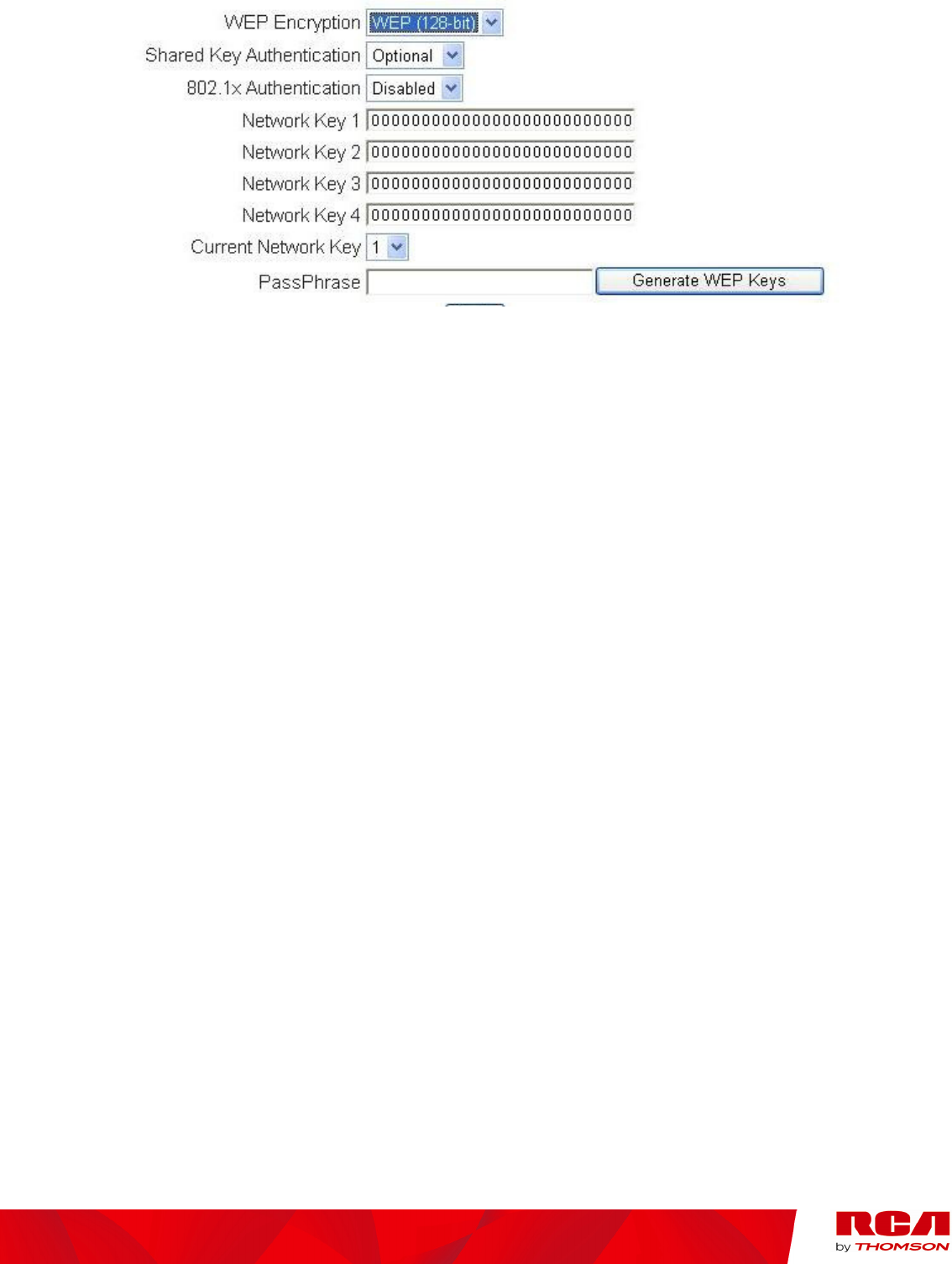
Chapter 2: Web Configuration
47
Illustrations contained in this document are for representation only.
Fig. 33 PassPhrase
Apply: After proper configuration, click Apply to invoke the settings.
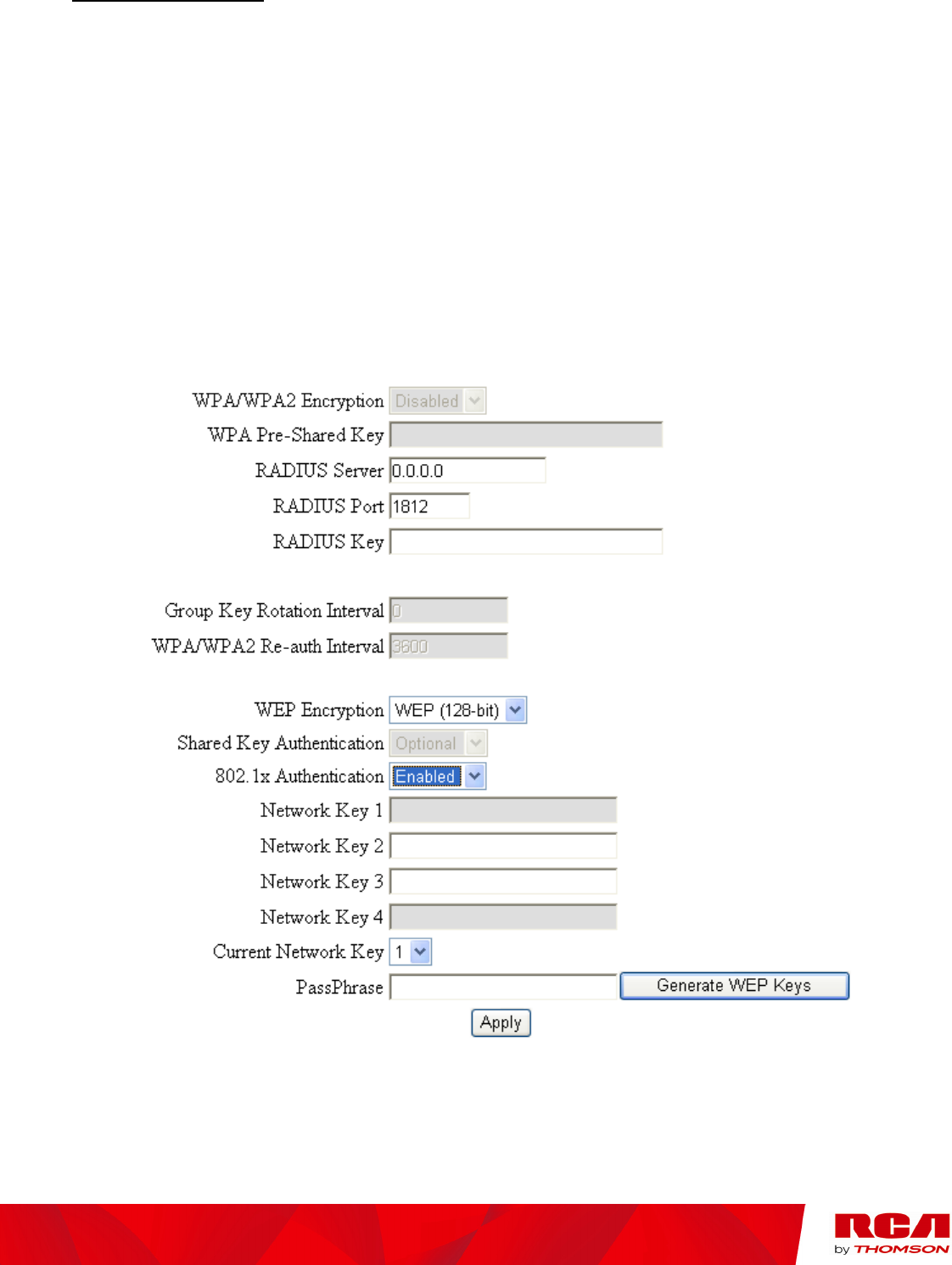
Chapter 2: Web Configuration
48
Illustrations contained in this document are for representation only.
802.1x Authentication
If you enable the 802.1x authentication function, you will have to offer the following information-
RADIUS Server: RADIUS Server is a protocol for carrying authentication, authorization, and
configuration information between a Network Access Server which desires to authenticate its links
and a shared Authentication Server. Please key in the IP Address for the RADIUS Server.
RADIUS Port: Besides the IP address of the RADIUS Server, you have to enter the port number
for the server. Port 1812 is the reserved RADIUS-authentication port described in RFC 2138.
Earlier AP (RADIUS clients) use port 1945. The default value will be shown on this box. You can
keep and use it.
RADIUS Key: A RADIUS Key is like a password, which is used between IAS and the specific
RADIUS client to verify identity. Both IAS and the RADIUS client must be use the same RADIUS
Key for successful communication to occur. Enter the RADIUS Key.
Fig. 34 802.1x Authentication
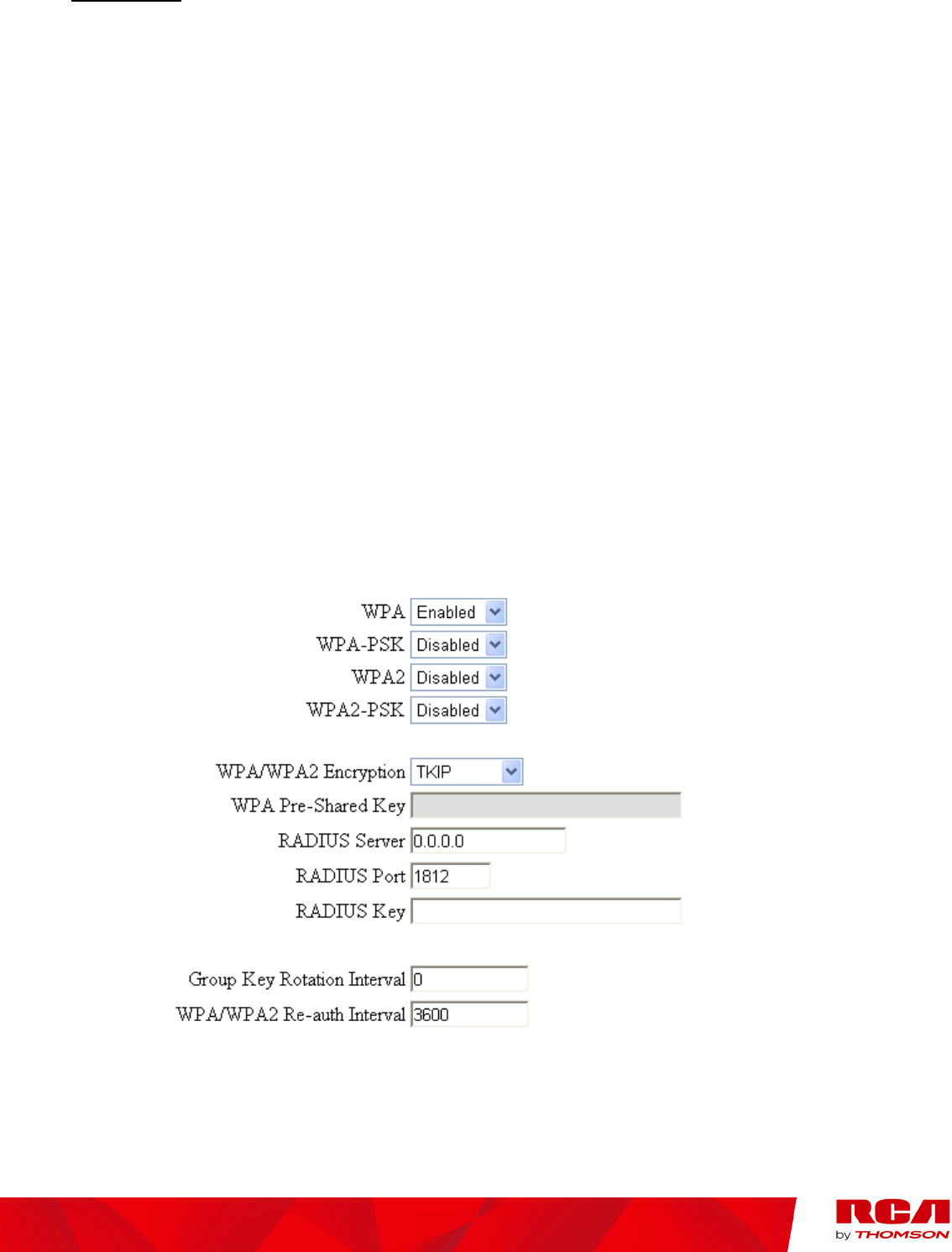
Chapter 2: Web Configuration
49
Illustrations contained in this document are for representation only.
WPA/WPA2
For the WPA/WPA2 network Authentication, the settings that you can adjust including WPA/WPA2
Encryption, RADIUS Server, RADIUS Port, RADIUS Key, Group Key Rotation Interval, and
WPA/WPA2 Re-auth Interval.
WPA/WPA2 Encryption: There are three types that you can choose, TKIP*, AES**, TKIP+AES.
TKIP takes the original master key only as a starting point and derives its encryption keys
mathematically from this mater key. Then it regularly changes and rotates the encryption
keys so that the same encryption key will never be used twice
** AES provides security between client workstations operating in ad hoc mode. It uses a
mathematical ciphering algorithm that employs variable key sizes of 128, 192 or 256 bits.
RADIUS Server/RADIUS Port/RADIUS Key: Please refer to the previous page.
Group Key Rotation Interval: Key in the time for the WAP group key rotation interval. The unit is
second. With increasing rekey interval, user bandwidth requirement is reduced.
WPA/WPA2 Re-auth Interval: When a wireless client has associated with the Residential Voice
Gateway for a period of time longer than the setting here, it would be disconnected and the
authentication will be executed again. The default value is 3600, you may modify it.
Fig. 35 WPA/WPA2
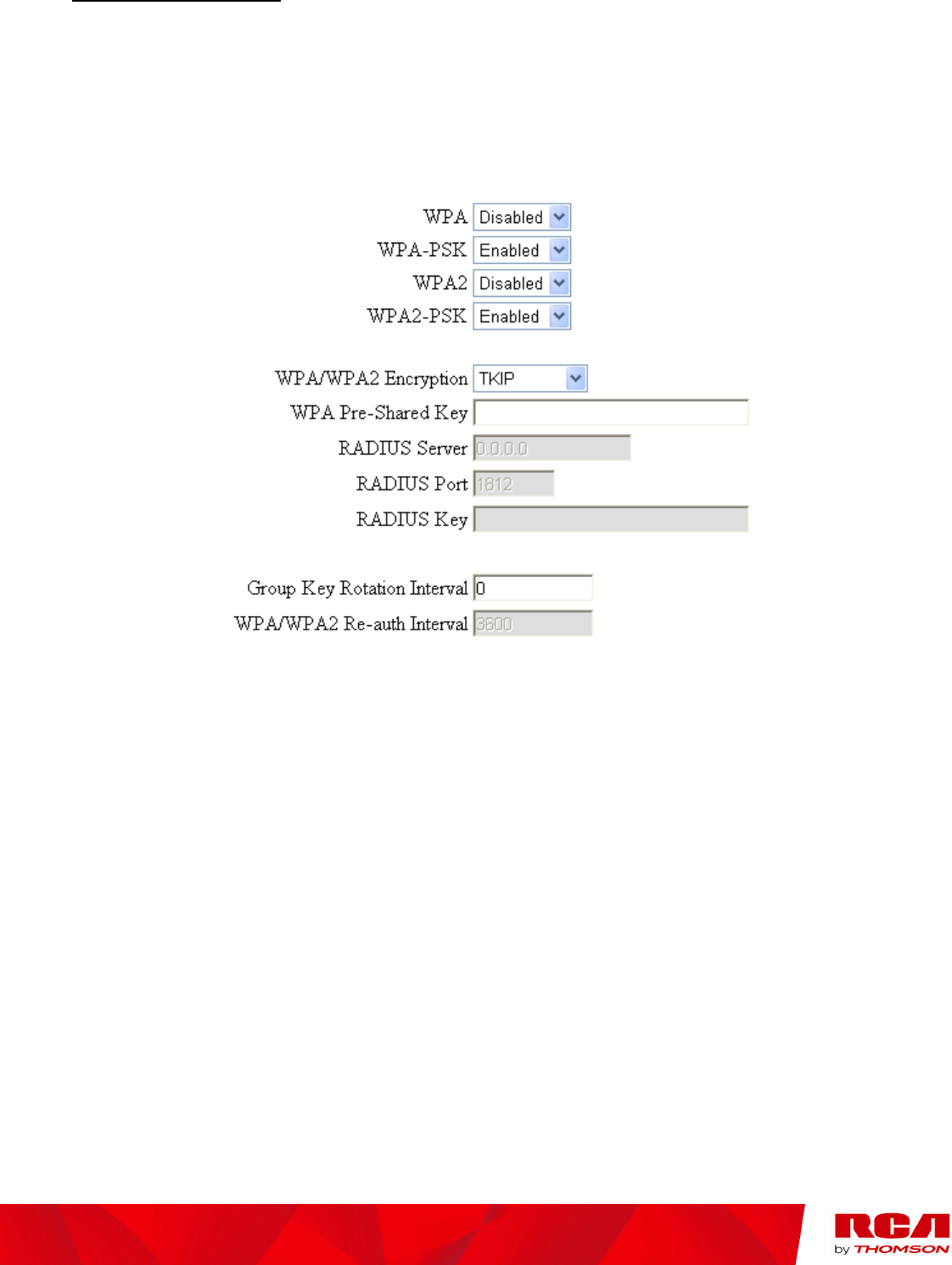
Chapter 2: Web Configuration
50
Illustrations contained in this document are for representation only.
WPA-PSK/ WPA2-PSK
For the WPA-PSK/WPA2-PSK network Authentication, the settings that you can adjust including
WPA/WPA2 Encryption, WPA Pre-Shared Key, and Group key Rotation Interval.
WPA Pre-Shared Key: Please type the key to be between 8 and 63 characters, or 64 hexadecimal
digits. Only the devices with a matching key that you set here can join this network.
WPA/WPA2 Encryption & WPA Group Rekey Interval: Please refer to the WPA/WPA2 part.
Fig. 36 WPA-PSK/WPA2-PSK
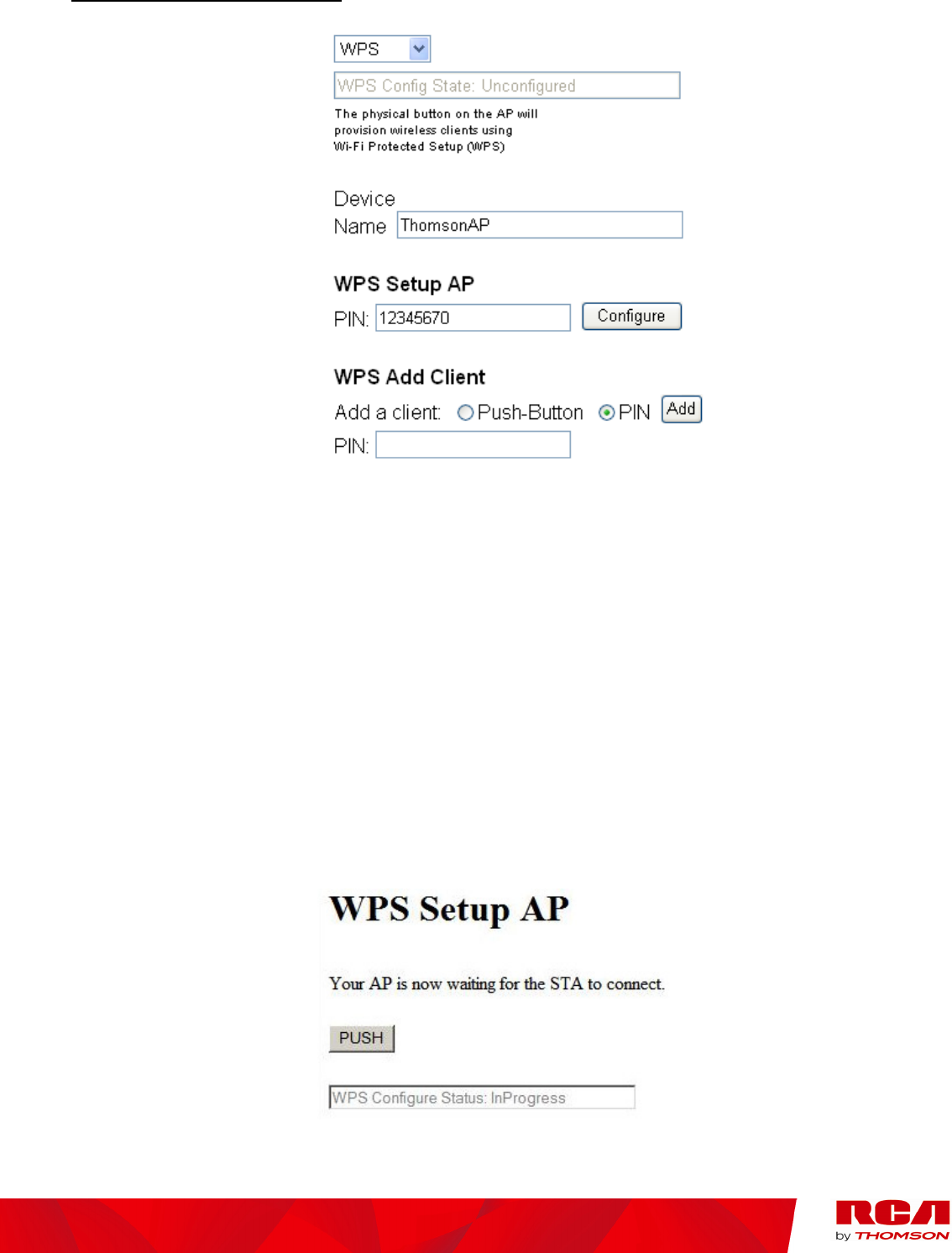
Chapter 2: Web Configuration
51
Illustrations contained in this document are for representation only.
Automatic Security Configuration
Fig. 37 Automatic Security Configuration
WiFi Protected Setup (WPS): It is a secure way of configuring and connecting your WiFi access point.
WPS Config: It will help to Enable or Disable the WPS feature.
Device Name: By using this you can change the factory default to a name of your choice up to 32 characters
long as like SSID
WPS Setup AP: Here we no need to do any configure. So, just skip this step.
WPS Add Client: T
here are two methods “Push-Button” and “PIN”. Select the method you want.
If you select “Push-Button”, then the WPS Setup AP page will appear as shown below.
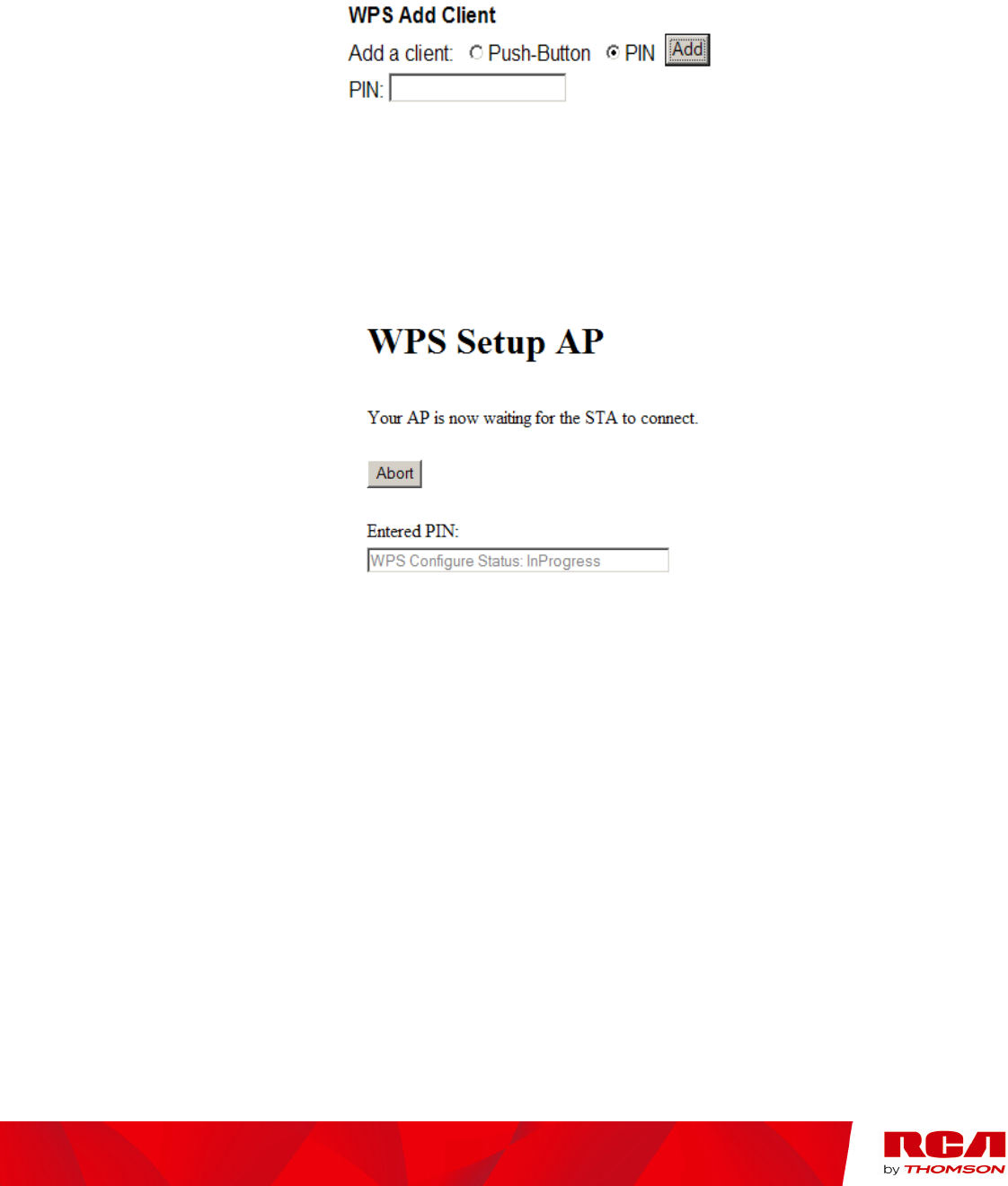
Chapter 2: Web Configuration
52
Illustrations contained in this document are for representation only.
Fig. 38 WPS Setup AP/PUSH
And WPS Configure Status will be “In progress”, after establishing the connection the WPS Configure
Status will be “Success!”. If you select WPS Method to PIN then It will ask for PIN while configuring the
WiFi AP by showing a text box so, you need to enter that PIN to establish
the connection. You can get the
PIN from client.
Fig. 39 WPS/Push-Button
PIN: Use this option to set the PIN, enter 4-8 digits PIN of the device you wish to configure. After entering
the pin click “Add” button, then the WPS Setup AP page will appear as shown below and the status will be
“In progress”, after establishing the connection the WPS Configure Status will be “Success!”.
Fig. 40 WPS Setup AP/PIN
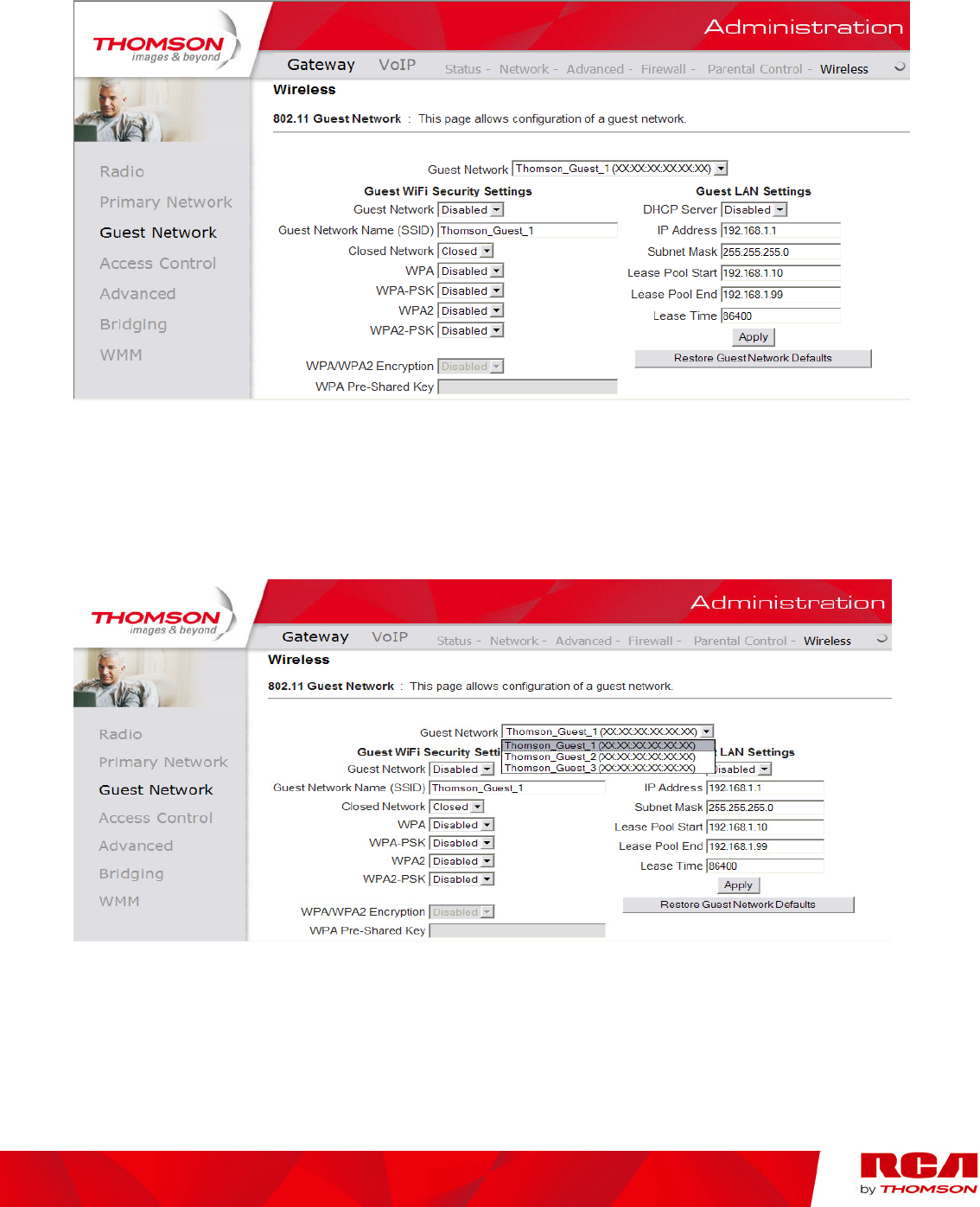
Chapter 2: Web Configuration
53
Illustrations contained in this document are for representation only.
3. Guest Networks
If enabled by the service provider, there are 3 additional Wireless Guest Networks can be configured and
activated. The default guest network screen looks as follow:
Fig 41 Gateway\Wireless\Guest Network
These networks are independent of each others. Each network is controlled and configured similar to
the primary network (described is the previous section). You may select the appropriate network by
clicking on the pull down bottom next to the “Thomson_Guest_1”.
Fig 42 Gateway\Wireless\Guest Network
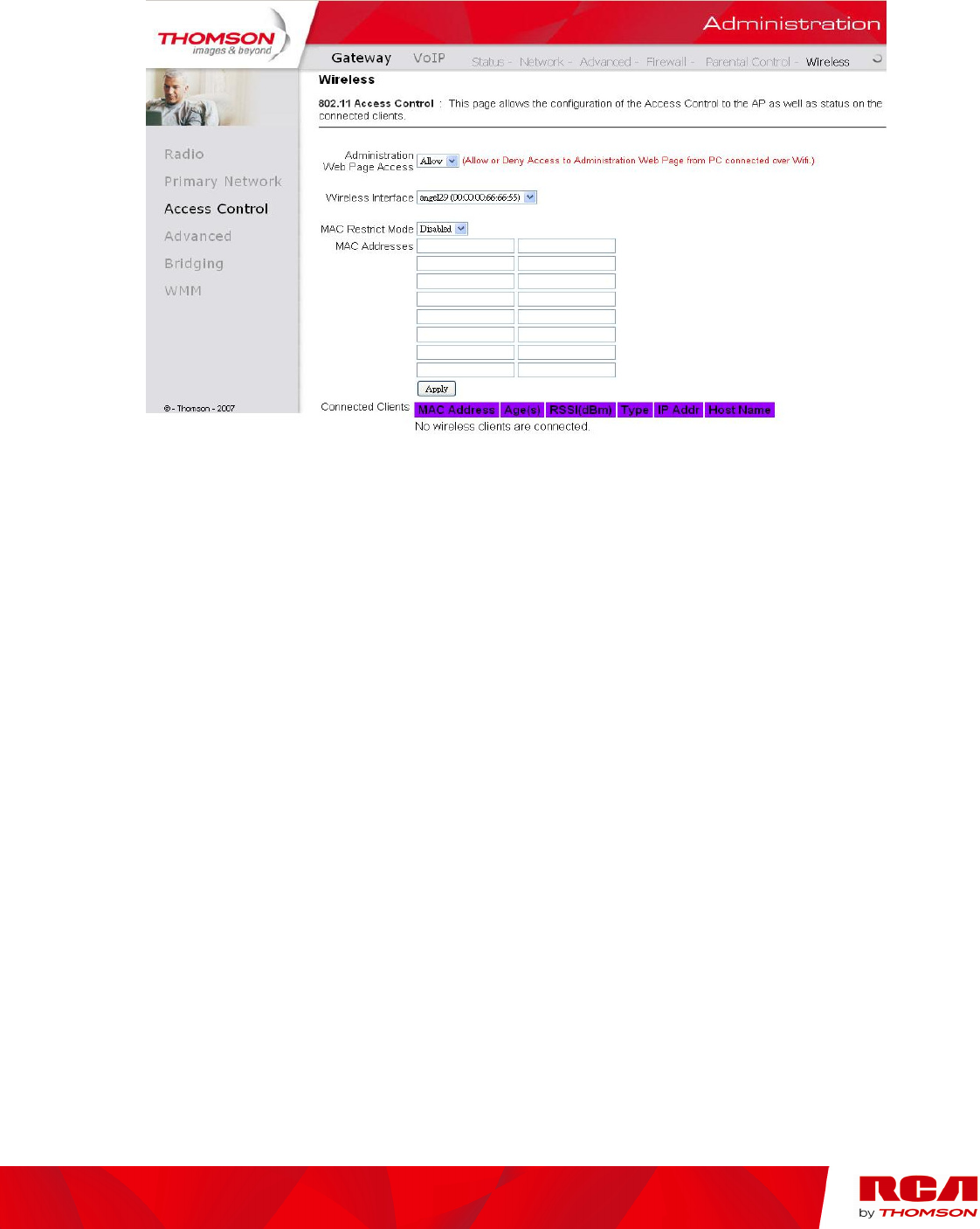
Chapter 2: Web Configuration
54
Illustrations contained in this document are for representation only.
4. Access Control
This page allows you to make access control to the AP or connected clients by offering the MAC
Addresses of the clients.
Fig. 43 Gateway\Wireless\Access Control
Administration Web page Access: It Allow or Deny access to Administration Web Page from PC
connected over WiFi.
Wireless Interface: By default it will be having two interfaces, “Primary Network interface” and “Guest
Network Interface”. The “Primary Network interface” will be available for all users. If you want to
access the “Guest Network Interface” then you need to contact cable operator.
MAC Restrict Mode: Click Disabled to welcome all of the clients on the network; select Allow to
permit only the clients on the list to access the cable modem; or choose Deny to prevent the clients on
the list to access this device.
MAC Address: Your Gateway identifies wireless PCs by their WiFi MAC Address. This address
consists of a string of 6 pairs of numbers 0-9 and letters A-F, such as 00 90 4B F0 FF 50. It is usually
printed on the WiFi card of the device (e.g. the PCMCIA card in a laptop). It can also be determined
from a Windows DOS prompt as explained below.
Enter the MAC addresses of the connected clients into the fields, and then click Apply to add them to the
list for access control.
Apply: After proper configuration, click Apply to invoke the settings.
Connected Clients: The information of currently connected clients will be displayed here.
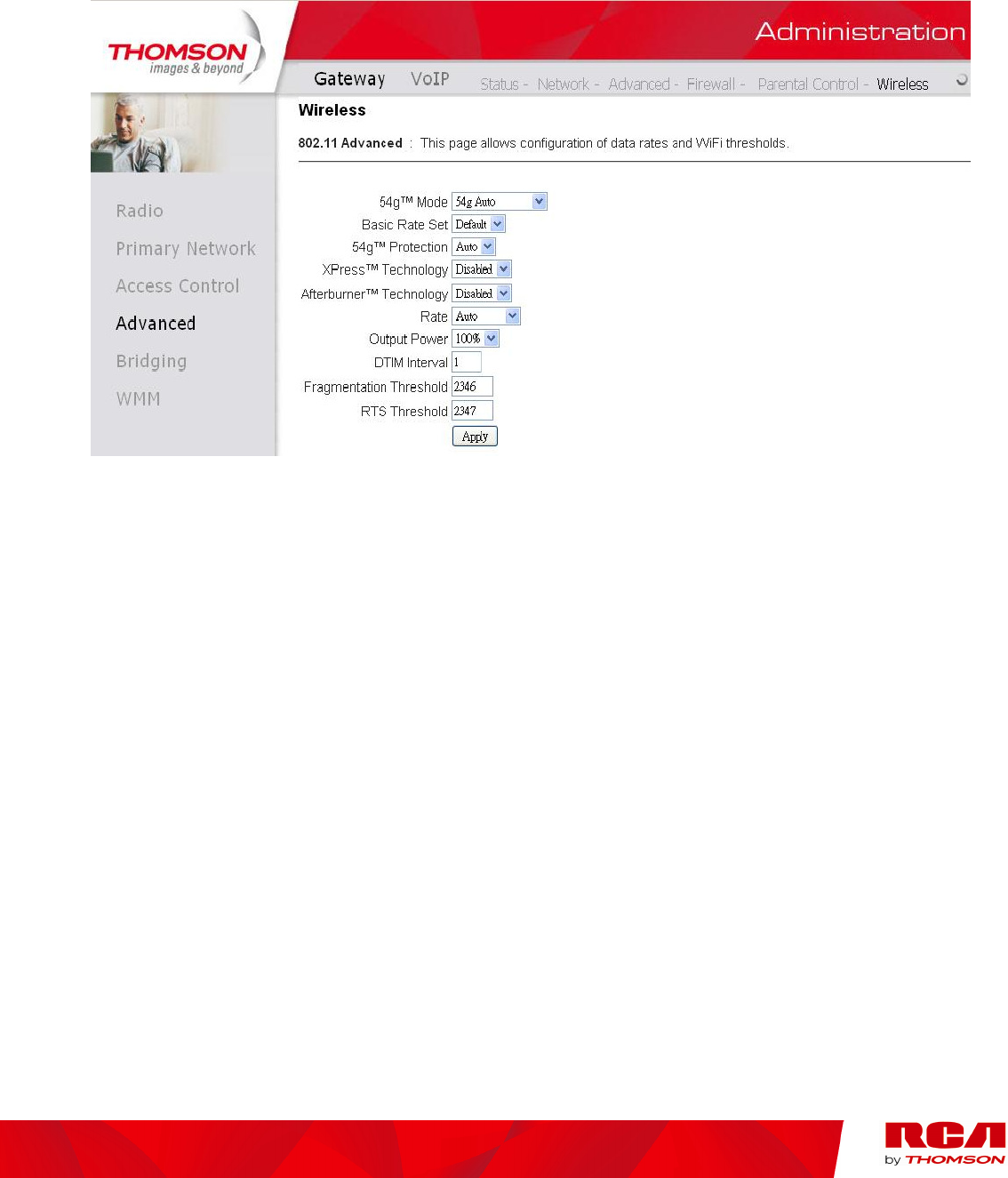
Chapter 2: Web Configuration
55
Illustrations contained in this document are for representation only.
5. Advanced
This page allows you to configure some advanced settings. The factory default values should provide
good results in most cases. We don’t recommend you change these settings unless you have technical
knowledge of 802.11b wireless technology.
For expert users, details of all settings on this web page are provided below.
Fig. 44 Gateway\Wireless\Advanced
Beacon Interval:
Set the period of beacon transmissions to allow mobile stations to locate and identify a BSS. The
measure unit is “time units” (TU) of 1024 microseconds. (Value range: 1~65535)
DTIM Interval:
The value you set here is used to inform mobile stations when multicast frames that have been buffered
at the Wireless Gateway will be delivered and how often that delivery occurs. (Value range: 1~255)
Fragmentation Threshold:
Set the number of the fragmenting frames to make the data to be delivered without errors induced by the
interference. Frames longer than the value you set here are fragmented before the initial transmission
into fragments no longer than the value of the threshold. (Value range: 256~ 2346)
RTS Threshold:
Set the value for sending a request to the destination. All the frames of a length greater than the threshold
that you set here will be sent with the four-way frame exchange. And, a length less than or equal to the
value that you set will not be proceeded by RTS. (Value range: 0~ 2347)
54gTM Network Mode:
There are three modes for you to choose, please check the specification of your wireless card and choose

Chapter 2: Web Configuration
56
Illustrations contained in this document are for representation only.
a proper setting.
54gTM Protection:
Select Auto to turn on the 54gTM protection; select Off to turn down the protection.
XpressTM Technology:
When Xpress is turned on, aggregate throughput (the sum of the individual throughput speeds of each
client on the network) can improve by up to 27% in 802.11g-only networks, and up to 75% in mixed
networks comprised of 802.11g and 802.11b standard equipment.
Rate:
It decides the speed of data transmission. There are several rates provided here for you to choose. Choose
any one of it according to your needs by using the drop-down menu.
Output Power:
This setting decides the output power of this device. You may use it to economize on electricity by
selecting lower percentage of power output.
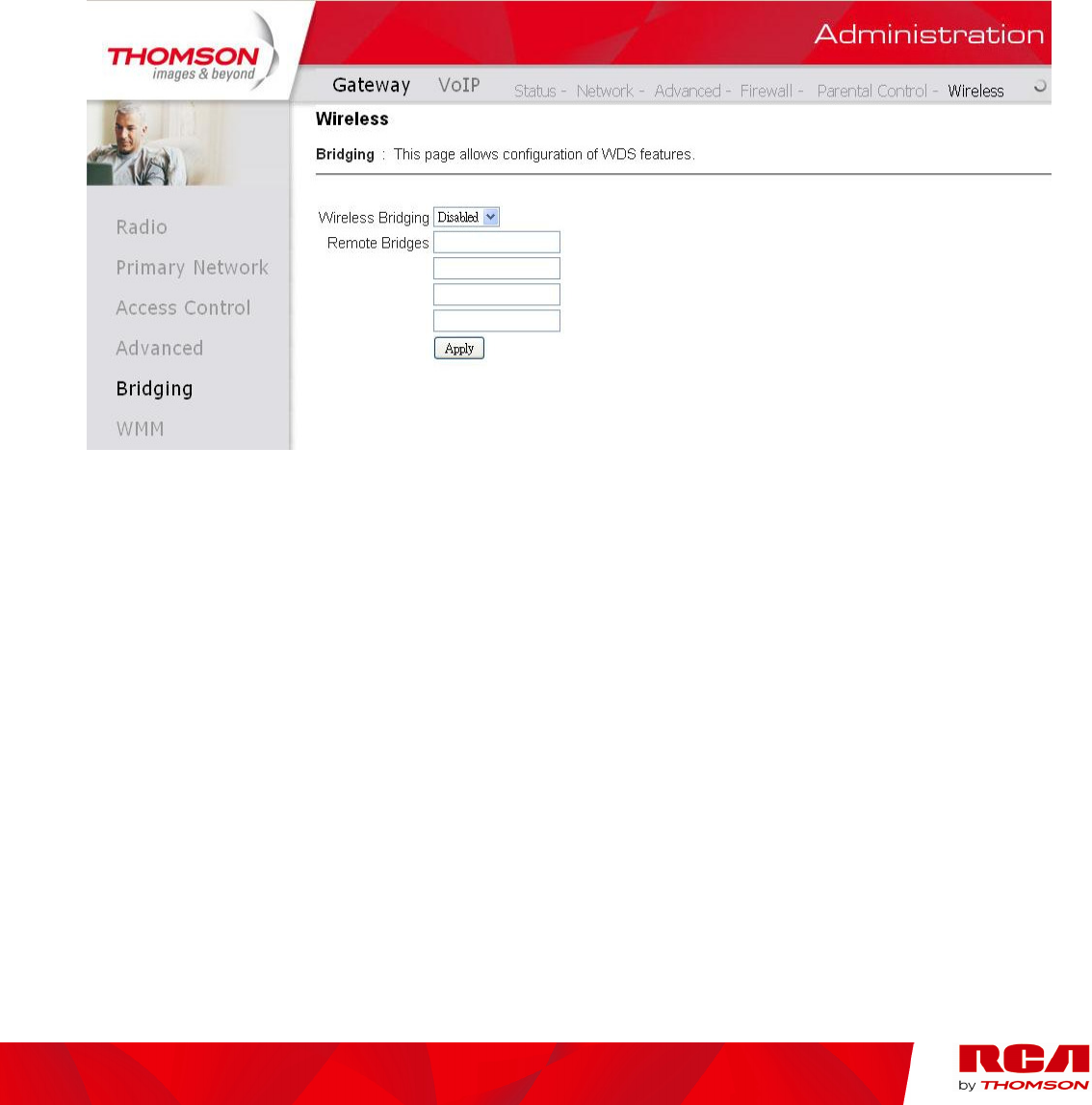
Chapter 2: Web Configuration
57
Illustrations contained in this document are for representation only.
6. Bridging
The Bridging page provides a location where settings can be adjusted related to the wireless WDS
(Wireless Distribution System) feature.
WDS is a system that enables the interconnection of access points wirelessly. It may also be referred to
as repeater mode because it appears to bridge and accept wireless clients at the same time (unlike
traditional bridging).
The wireless gateway can be placed in a mode that allows the gateway to communicate with other
“extender” wireless access points either exclusively or mixed with communications to local PCs. Use
this page to designate the Remote Bridges the gateway is allowed to communicate with, and to select the
Wireless Bridging mode.
Fig. 45 Gateway\Wireless\Bridging
Wireless Bridging:
Choose Disabled to shutdown this function; select Enabled to turn on the function of WDS.
Remote Bridges:
Enter the MAC Addresses of the remote Bridges to relay the signals for each other.
Apply:
After proper configuration, click Apply to invoke the settings.
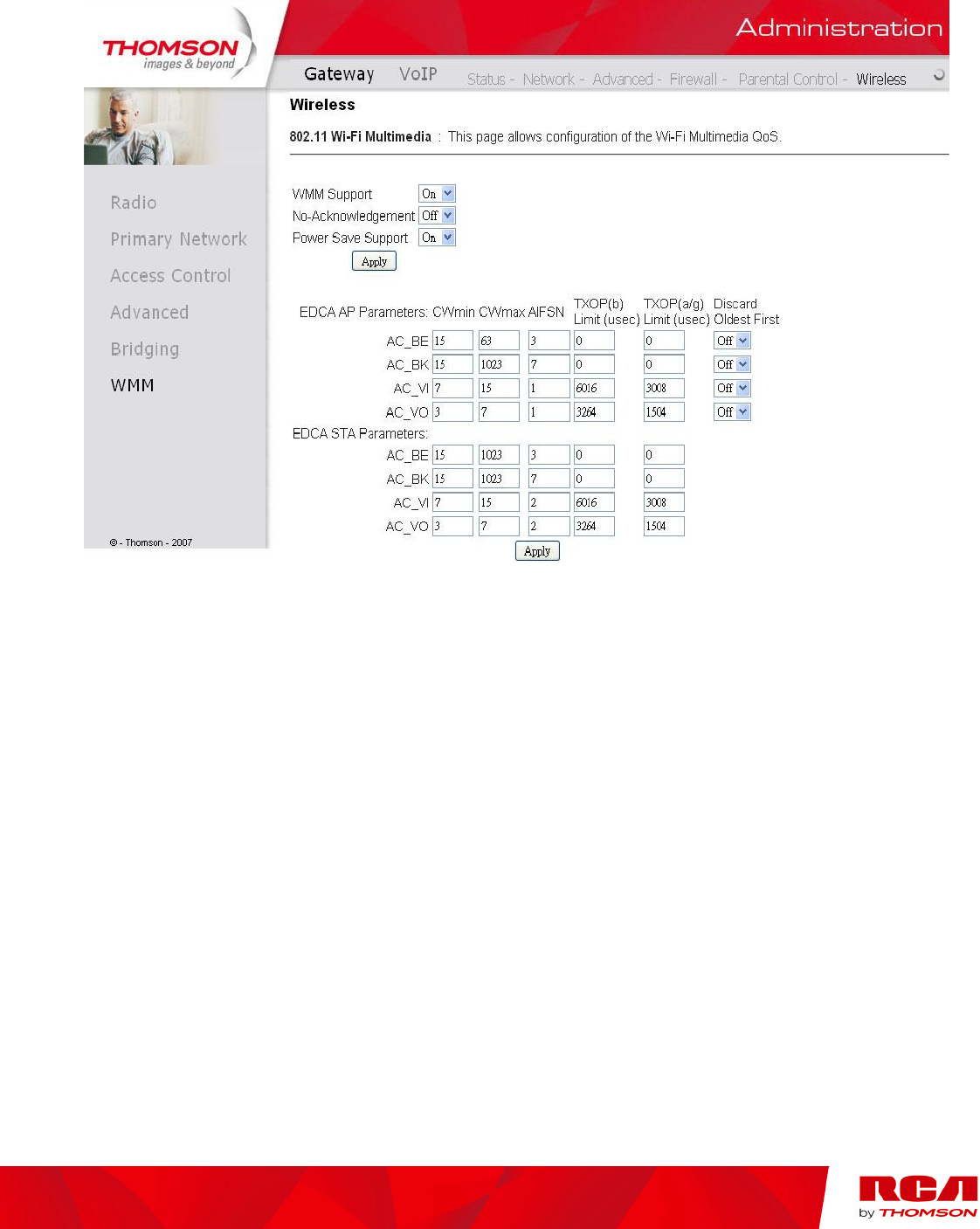
Chapter 2: Web Configuration
58
Illustrations contained in this document are for representation only.
7. WMM
This page allows you to configure Wi-Fi Multi-Media (WMM). WMM is an implementation of Quality
of Service (QoS) which is defined by the IEEE standard 802.11e.
Fig. 46 Gateway\Wireless\WMM
WMM Support:
Sets WMM support. Choices are Auto, On or Off. If enabled (Auto or On), the WMM information
Element is included in beacon frame.
No-Acknowledgement:
Sets No-Acknowledgement support. Choices are On or Off. When enabled, acknowledgments for data
are not transmitted.
Power Save Support:
Sets Power Save Support. Choices are On or Off. When Power Save is enabled, the AP queues packets
for STAs that are in power-save mode. Queued packets are transmitted when the STA notifies AP that it
has left power-save mode.
EDCA AP Parameters:
Specifies the transmit parameters for traffic transmitted from the AP to the STA for the four Access
Categories: Best Effort (AC_BE), Background (AC_BK), Video (AC_VI), and Voice (AC_VO).

Chapter 2: Web Configuration
59
Illustrations contained in this document are for representation only.
Transmit parameters include Contention Window (CWmin and CWmax), Arbitration Inter Frame
Spacing Number (AIFSN), and Transmit Opportunity Limit (TXOP Limit).
There are also two AP-specific settings: Admission Control and Discard Oldest First. Admission control
specifies if admission control is enforced for the Access Categories. Discard Oldest First specifies the
discard policy for the queues. On discards the oldest first; Off discards the newest first.
EDCA STA Parameters:
Specifies the transmit parameters for traffic transmitted from the STA to the AP for the four Access
Categories: Best Effort (AC_BE), Background (AC_BK), Video (AC_VI), and Voice (AC_VO).
Transmit parameters include Contention Window (CWmin and CWmax), Arbitration Inter Frame
Spacing Number (AIFSN), and Transmit Opportunity Limit (TXOP Limit).
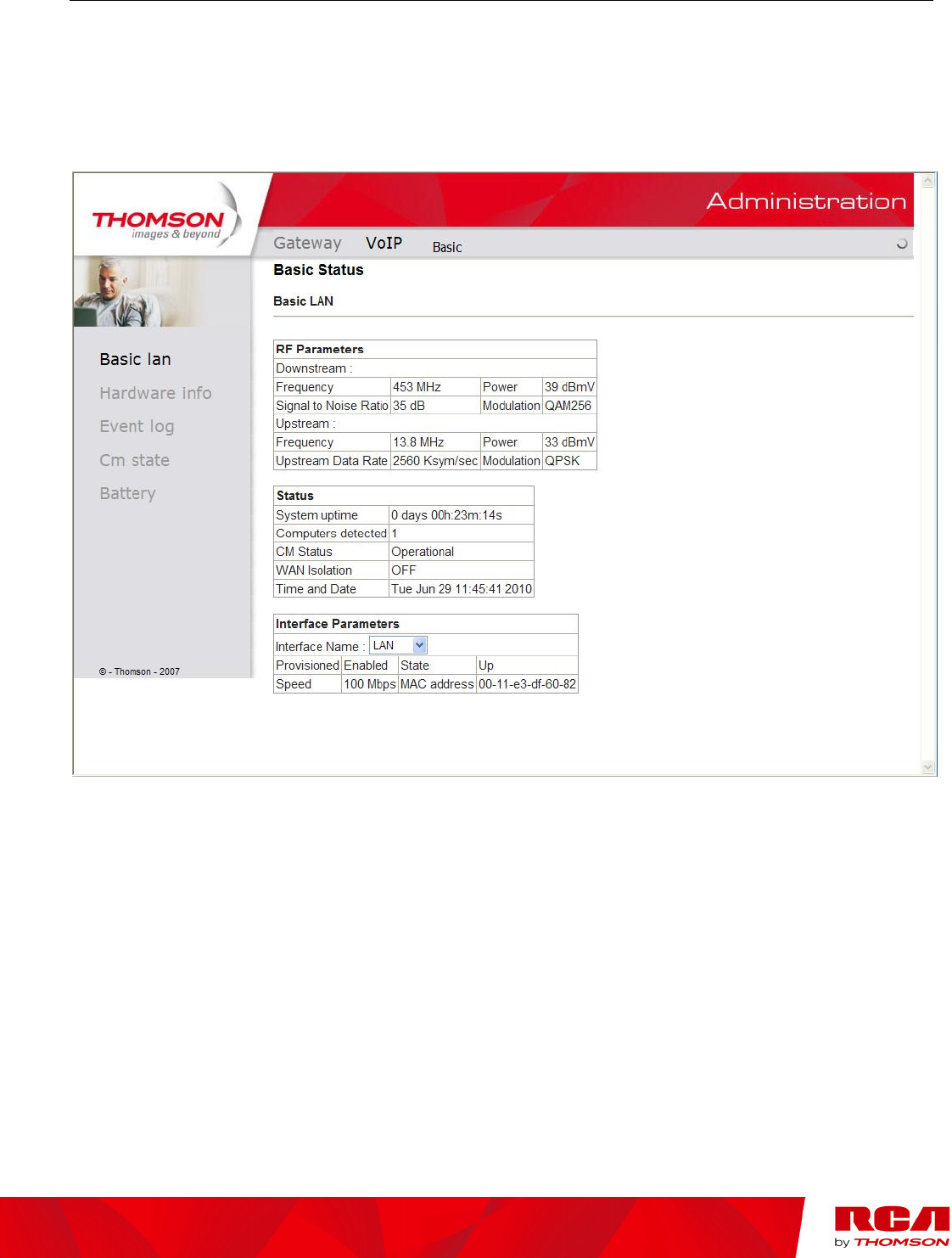
Chapter 2: Web Configuration
60
Illustrations contained in this document are for representation only.
VoIP – Basic Web Page Group
1. Basic LAN
This page displays the basic LAN status of this device, including the downstream and upstream status,
device information, and interface parameters. You can select specific interface from the Interface Name
drop-down menu.
Fig.47 VoIP\Basic\Basic LAN
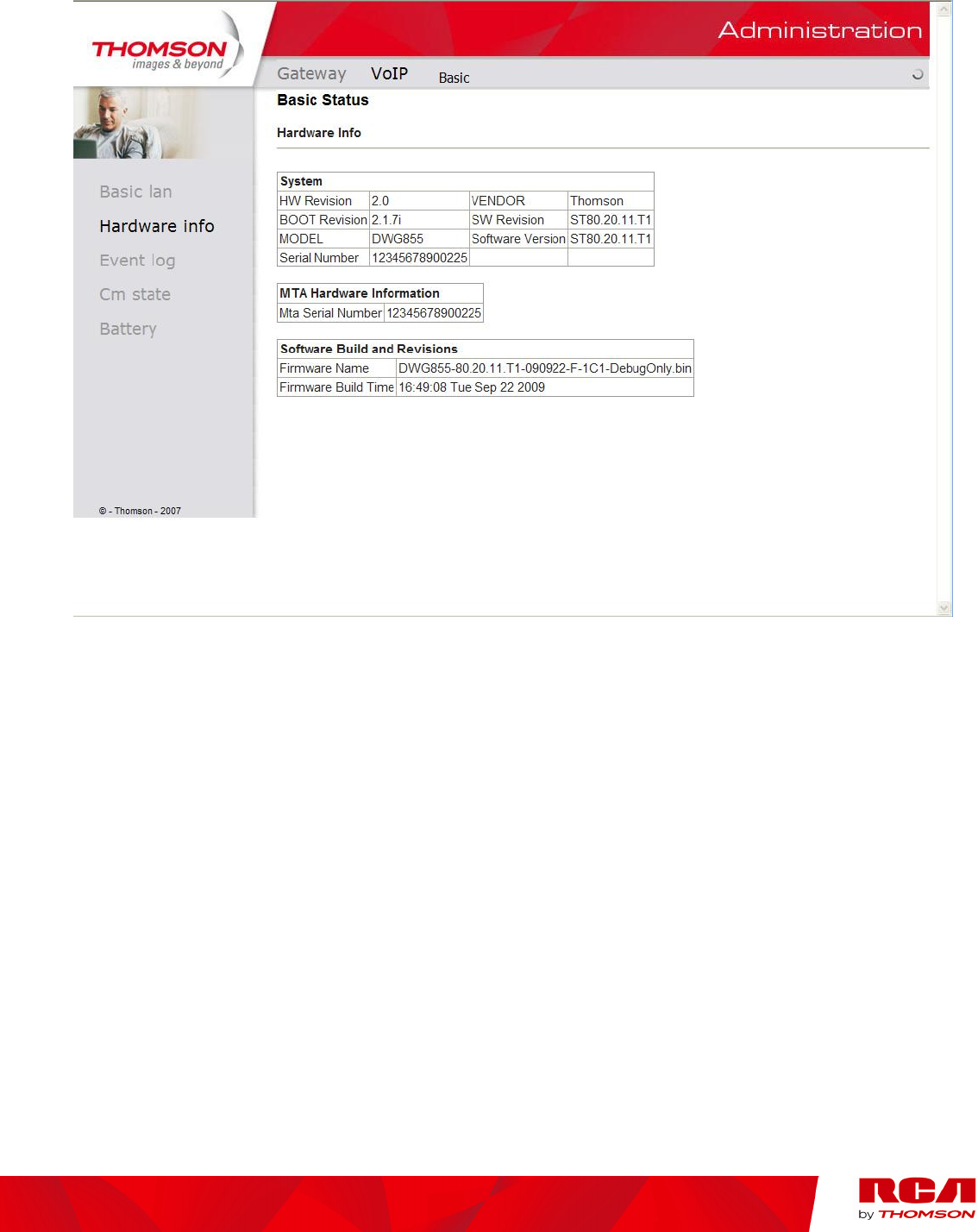
Chapter 2: Web Configuration
61
Illustrations contained in this document are for representation only.
2. Hardware Info
The hardware Info is displayed on this page.
Fig. 48 VoIP\Basic\Hardware Info
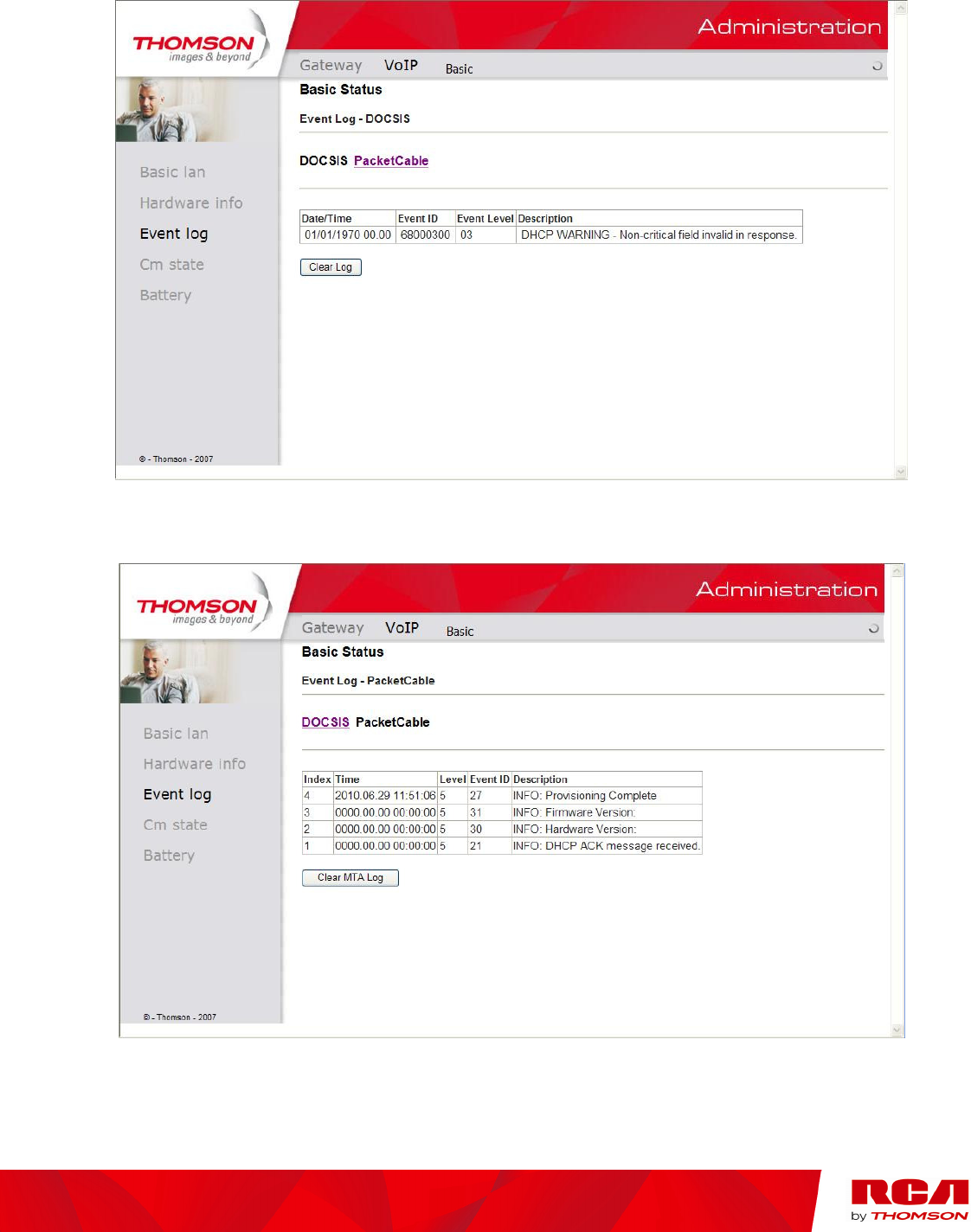
Chapter 2: Web Configuration
62
Illustrations contained in this document are for representation only.
3. Event Log
The event logs are displayed on this web page. You can check them whenever you need.
Fig. 49 VoIP\Basic\Event Log\DOCSIS
Fig. 50 VoIP\Basic\Event Log\PacketCable
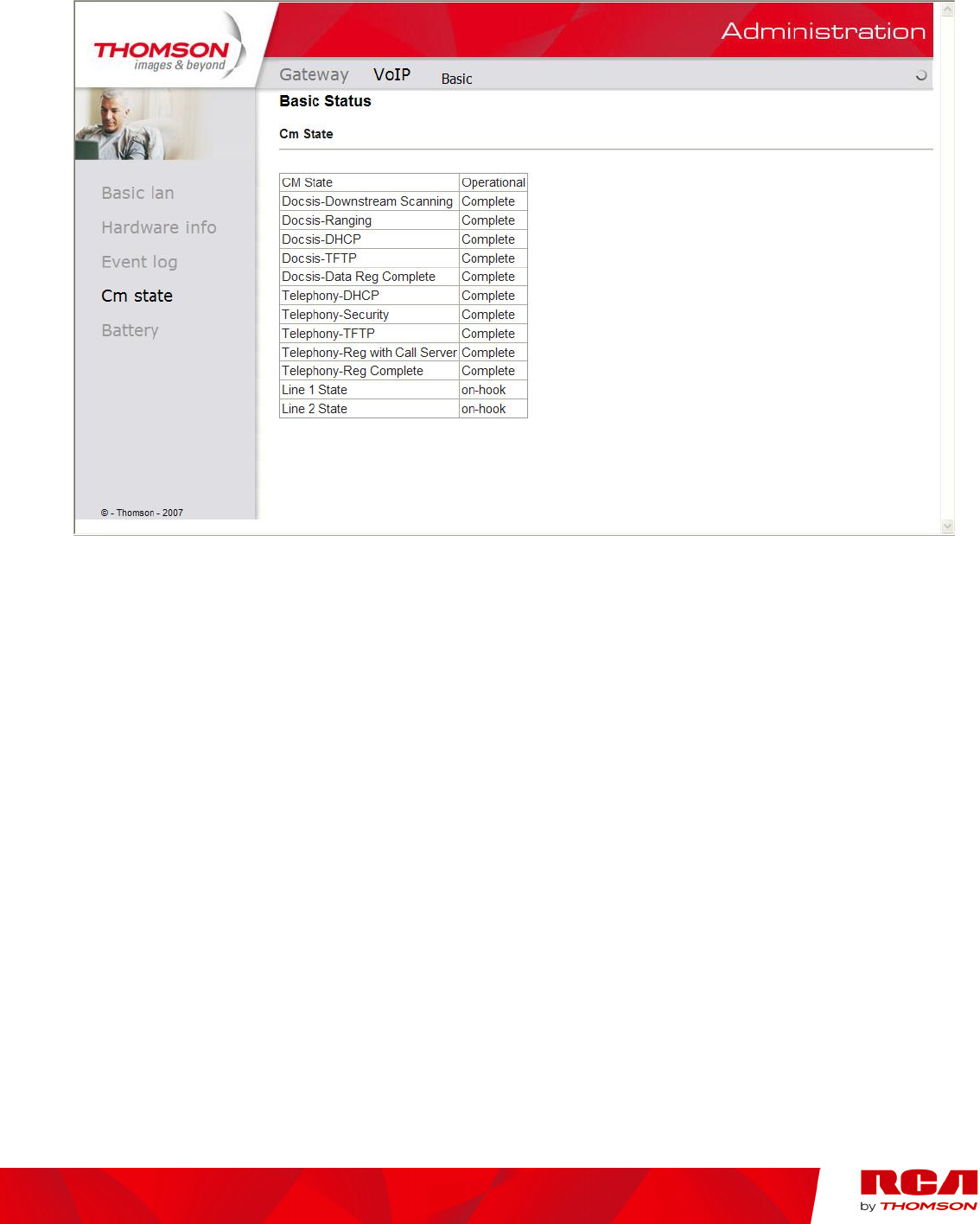
Chapter 2: Web Configuration
63
Illustrations contained in this document are for representation only.
4. CM State
This page shows the current state of the cable modem.
Fig. 51 VoIP\Basic\CM state
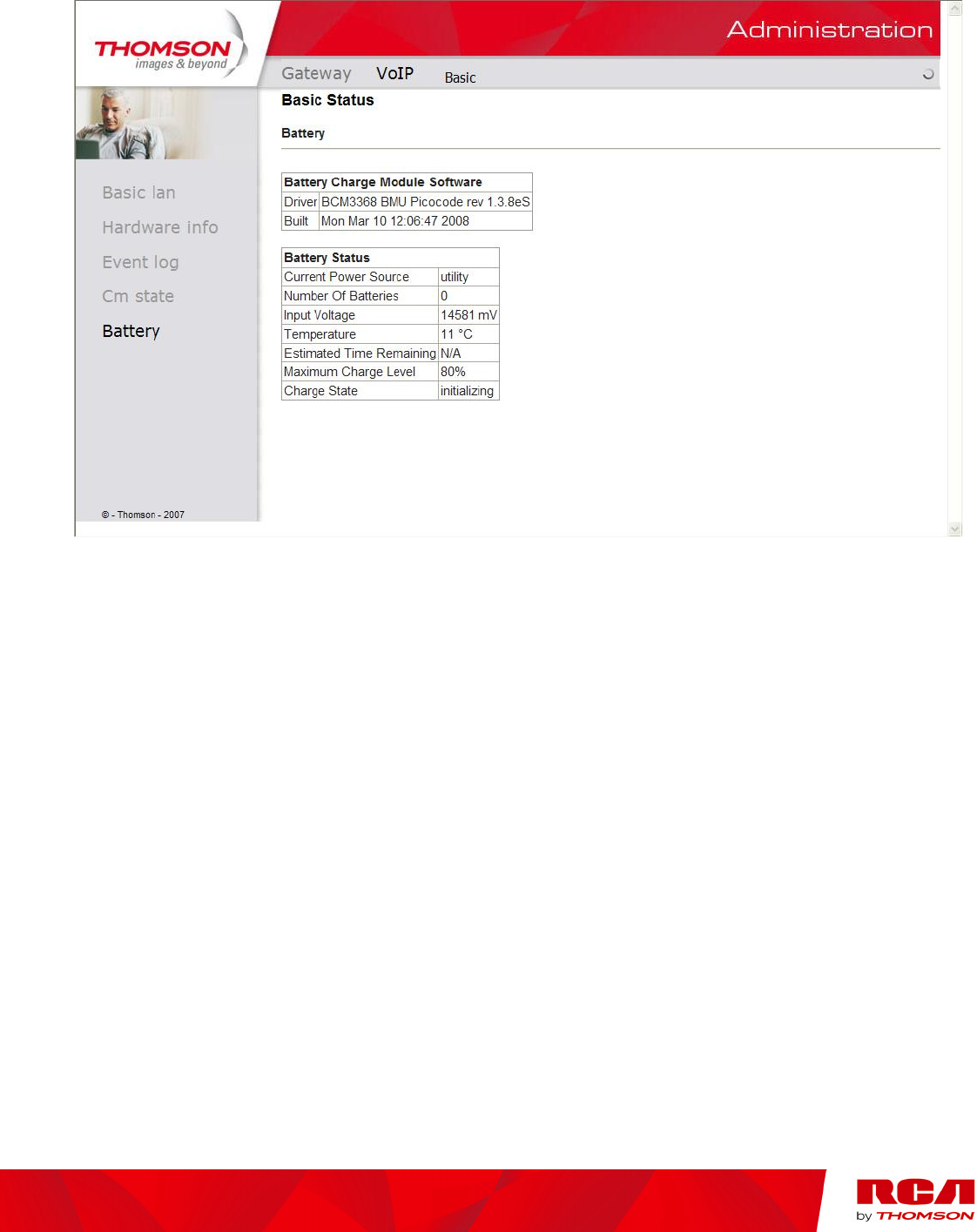
Chapter 2: Web Configuration
64
Illustrations contained in this document are for representation only.
5. Battery
This page shows the current state of battery.
Fig. 52 VoIP\Basic\Battery

Chapter 3: Additional Information
65
Illustrations contained in this document are for representation only.
Chapter 3: Additional Information
Frequently Asked Questions
Q. What if I don’t subscribe to cable TV?
A. If cable TV is available in your area, data and voice service may be made available with or without
cable TV service. Contact your local cable company for complete information on cable services,
including high-speed internet access.
Q. How do I get the system installed?
A. Professional installation from your cable provider is strongly recommended. They will ensure proper
cable connection to the modem and your computer. However, your retailer may have offered a self
installation kit, including the necessary software to communicate with your cable ISP.
Q. Once my Residential Voice Gateway is connected, how do I get access to the Internet?
A. Your local cable company provides your internet service*, offering a wide range of services including
email, chat, and news and information services, and a connection to the World Wide Web.
Q. Can I watch TV, surf the Internet, and talk to my friends through the Residential Voice Gateway at the same
time?
A. Absolutely!
Q. What do you mean by “Broadband?”
A. Simply put, it means you’ll be getting information through a “bigger pipe,” with more bandwidth,
than a standard phone line can offer. A wider, “broader” band means more information, more quickly.
Q. What is DOCSIS and what does it mean?
A. “Data over Cable Service Interface Specifications” is the industry standard that most cable companies
are adopting as they upgrade their systems. Should you ever decide to move, the Residential Voice
Gateway will work with all upgraded cable systems that are DOCSIS-compliant.
Q. What is PacketCable and what does it mean?
A. Like DOCSIS, PacketCable is the industry standard for telephony services that most cable companies
are adopting as they upgrade their systems. Should you ever decide to move, the Residential Voice
Gateway will work with all upgraded cable systems that are PacketCable-compliant.
Q. What is Xpress Technology and what does it mean?

Chapter 3: Additional Information
66
Illustrations contained in this document are for representation only.
A. It is one of the popular performance-enhancing WiFi technologies, designed to improve wireless
network efficiency and boost throughput. It is more efficient in mixed environments, and it can work
with 802.11a/b/g networks. When Xpress is turned on, aggregate throughput (the sum of the individual
throughput speeds of each client on the network) can improve by up to 27% in 802.11g-only networks,
and up to 75% in mixed networks comprised of 802.11g and 802.11b standard equipment. The
technology achieves higher throughput by re-packaging data, reducing the number of overhead control
packets, so that more useful data can be sent during a given amount of time.
* Monthly subscription fee may apply.
**
Additional equipment required. Contact your Cable Company and ISP for any restrictions or
additional fees.

Chapter 3: Additional Information
67
Illustrations contained in this document are for representation only.
General Troubleshooting
You can correct most problems you have with your product by consulting the troubleshooting list that
follows.
I can’t access the internet.
Check all of the connections to your Residential Voice Gateway.
Your Ethernet card may not be working. Check each product’s documentation for more
information.
The Network Properties of your operating system may not be installed correctly or the settings
may be incorrect. Check with your ISP or cable company.
All or some of the lights are flashing in sequence.
This means the Residential Voice Gateway is automatically updating its system software.
Please wait for the lights to stop flashing. The updating process typically lasts less than one
minute.
Do not remove the power supply or reset the Residential Voice Gateway during this process.
I can’t get the modem to establish an Ethernet connection.
Even new computers don’t always have Ethernet capabilities – be sure to verify that your
computer has a properly installed Ethernet card and the driver software to support it.
Check to see that you are using the right type of Ethernet cable.
The modem won’t register a cable connection.
If the modem is in Initialization Mode, the INTERNET light will be flashing. Call your Cable
Company if it has not completed this 5-step process within 30 minutes, and note which step it
is getting stuck on. (See page 22 for details.)
The modem should work with a standard RG-6 coaxial cable, but if you’re using a cable other
than the one your Cable Company recommends, or if the terminal connections are loose, it
may not work. Check with your Cable Company to determine whether you’re using the correct
cable.
If you subscribe to video service over cable, the cable signal may not be reaching the modem.
Confirm that good quality cable television pictures are available to the coaxial connector you
are using by connecting a television to it. If your cable outlet is “dead”, call your Cable
Company.

Chapter 3: Additional Information
68
Illustrations contained in this document are for representation only.
Verify that the Cable Modem service is DOCSIS-compliant and PacketCable-compliant by
calling your cable provider.
I don’t hear a dial tone when I use a telephone.
Telephone service is not activated. If the rightmost light on the Residential Voice Gateway
stays on while others flash, check with your TSP or cable company.
If the Residential Voice Gateway is connected to existing house telephone wiring, make sure
that another telephone service is not connected. The other service can normally be
disconnected at the Network Interface Device located on the outside of the house.
If using the second line on a two-line telephone, be sure to connect to port TEL1/2.
For more Usage and Troubleshooting Tips use the web site links provided on the CD-ROM.

Chapter 3: Additional Information
69
Illustrations contained in this document are for representation only.
FCC Declaration of Conformity and Industry Canada Information
This device complies with Part 15 of the FCC Rules. Operation is subject to the following two
conditions: (1) this device may not cause harmful interference, and (2) this device must accept any
interference received, including interference that may cause undesired operation.
Trade Name: Model: DWG855
Equipment Classification: Computing Device Accessory
Responsible Party: Thomson Inc.
101 West 103
rd
Street
Indianapolis, IN 46290
Telephone: 317-574-0496
This equipment has been tested and found to comply with the limits for a Class B digital device,
pursuant to Part 15 of the FCC Rules. These limits are designed to provide reasonable protection
against harmful interference in a residential installation. This equipment generates, uses, and can
radiate radio frequency energy and, if not installed and used in accordance with the instructions, may
cause harmful interference to radio communications. However there is no guarantee that interference
will not occur in a particular installation. If this equipment does cause harmful interference to radio or
television reception, which can be determined by turning the equipment off and on, the user is
encouraged to try and correct the interference by one or more of the following measures:
Reorient or relocate the receiving antenna.
Increase the separation between the equipment and receiver.
Connect this equipment into an outlet on a circuit different from that to which the receiver is
connected.
Consult the dealer or an experienced radio/TV technician for help.
FCC regulations state that unauthorized changes or modifications to this equipment may void the user’s
authority to operate it.
This Class B digital apparatus meets all requirements of the Canadian Interference Causing Equipment
Regulations.
IEEE 802.11b or 802.11g operation of this product in the U.S.A. is firmware-limited to channels 1
through 11.
IMPORTANT NOTE:

Chapter 3: Additional Information
70
Illustrations contained in this document are for representation only.
FCC Radiation Exposure Statement:
This equipment complies with FCC radiation exposure limits set forth for an uncontrolled
environment. This equipment should be installed and operated with minimum distance 20cm
between the radiator & your body.
This transmitter must not be co-located or operating in conjunction with any other antenna or
transmitter.
Service Information
If you purchased or leased your Residential Voice Gateway directly from your cable company, then
warranty service for the Digital Cable Modem may be provided through your cable provider or its
authorized representative. For information on 1) Ordering Service, 2) Obtaining Customer Support, or 3)
Additional Service Information, please contact your cable company. If you purchased your Residential
Voice Gateway from a retailer, see the enclosed warranty card.

Chapter 3: Additional Information
71
Illustrations contained in this document are for representation only.
Glossary
10BaseT – Unshielded, twisted pair cable with an RJ-45 connector, used with Ethernet LAN (Local Area
Network). “10” indicates speed (10 Mbps), “Base” refers to baseband technology, and “T” means twisted
pair cable.
Authentication - The process of verifying the identity of an entity on a network.
DHCP (Dynamic Host Control Protocol) – A protocol which allows a server to dynamically assign IP
addresses to workstations on the fly.
Ethernet card – A plug-in circuit board installed in an expansion slot of a personal computer. The
Ethernet card (sometimes called a Network Interface Card or NIC) takes parallel data from the computer,
converts it to serial data, puts it into a packet format, and sends it over the 10BaseT or 100BaseT LAN
cable.
DOCSIS (Data Over Cable Service Interface Specifications) – A project with the objective of
developing a set of necessary specifications and operations support interface specifications for Cable
Modems and associated equipment.
F Connector – A type of coaxial connector, labeled CABLE IN on the rear of the Residential Voice
Gateway that connects the modem to the cable system.
HTTP (Hyper Text Transfer Protocol) – Invisible to the user, HTTP is used by servers and clients to
communicate and display information on a client browser.
Hub – A device used to connect multiple computers to the Residential Voice Gateway.
IP Address – A unique, 32-bit address assigned to every device in a network. An IP (Internet Protocol)
address has two parts: a network address and a host address. This modem receives a new IP address from
your cable operator via DHCP each time it goes through Initialization Mode.
Key exchange - The swapping of mathematical values between entities on a network in order to allow
encrypted communication between them.
MAC Address – The permanent “identity” for a device programmed into the Media Access Control
layer in the network architecture during the modem’s manufacture.
Network Driver – A file that is loaded on the computer to allow the computer to recognize the Ethernet
card or USB port.

Chapter 3: Additional Information
72
Illustrations contained in this document are for representation only.
NID - Network Interface Device, the interconnection between the internal house telephone wiring and a
conventional telephone service provider’s equipment. These wiring connections are normally housed in a
small plastic box located on an outer wall of the house. It is the legal demarcation between the
subscriber’s property and the service provider’s property.
PacketCable – A project with the objective of developing a set of necessary telephony specifications and
operations support interface specifications for Residential Voice Gateways and associated equipment
used over the DOCSIS-based cable network.
PSTN (Public Switched Telephone Network) – The worldwide voice telephone network which
provides dial tone, ringing, full-duplex voice band audio and optional services using standard telephones.
Provisioning - The process of enabling the Media Terminal Adapter (MTA) to register and provide
services over the network.
TCP/IP (Transmission Control Protocol/Internet Protocol) – A networking protocol that provides
communication across interconnected networks, between computers with diverse hardware architectures
and various operating systems.
TFTP - Trivial File Transfer Protocol, the system by which the Media Terminal Adapter’s configuration
data file is downloaded.
TSP - Telephony Service Provider, an organization that provides telephone services such as dial tone,
local service, long distance, billing and records, and maintenance.
Xpress Technology - One of the popular performance-enhancing WiFi technologies, designed to
improve wireless network efficiency and boost throughput. It is more efficient in mixed environments,
and it can work with 802.11a/b/g networks.
Please do not send any products to the Indianapolis address listed in this manual or on the carton. This
will only add delays in service for your product.
Thomson Inc.
101 W 103
rd
Street
Indianapolis, IN 46290

Fore more information
Thomson 46, quai Alphonse Le Gallo
92100 Boulogne-Billancourt France
Fax : 33 (0) 141 86 56 59 www.thomson-broadband.com
2006 Thomson Inc.- Trademark(s)
®
Registered\ -Marca(s) Registada(s)\
Photos and features subject to change without notice.
Illustration of product finish may vary from actual color.
○
C